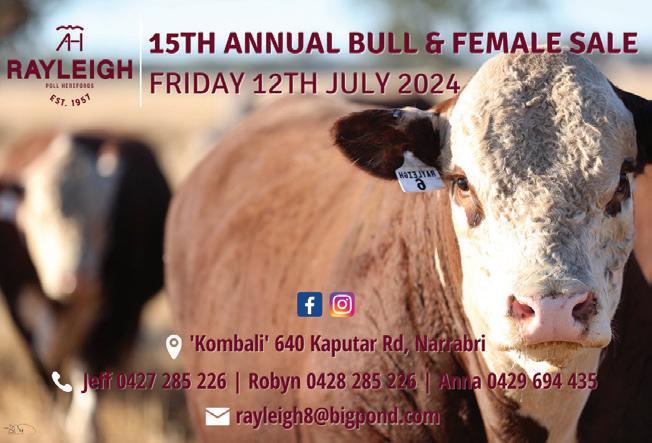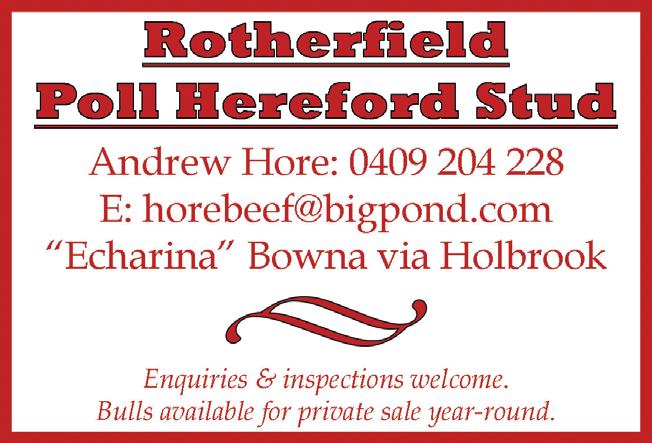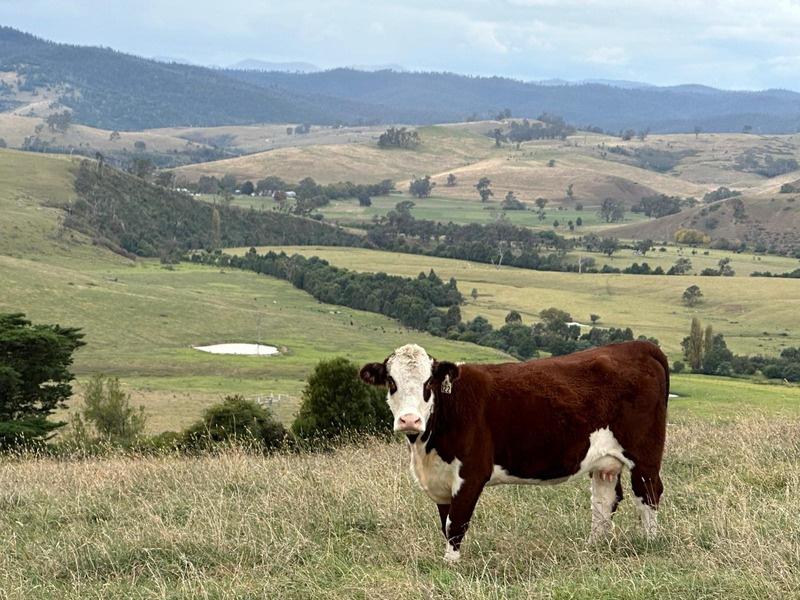HEREFORDS
AUSTRALIA


HEREFORDS Australia
Collaboration with USA on sustainability
Positioning Hereford as the first choice for crossbreeding
Hitting the specs for premium markets in the north
On-farm accreditation the backbone to supply chain










































































































HEREFORDS Australia
Collaboration with USA on sustainability
Positioning Hereford as the first choice for crossbreeding
Hitting the specs for premium markets in the north
On-farm accreditation the backbone to supply chain







































































































Hereford cows and calves grazing at Banana, Qld, demonstrating their adaptability to the climatic conditions of central, northern and western Queensland, making them ideal as a base female in crossbred enterprises. Image: Bryce Millar

Kim Woods - Outcross Media
0499 772 860
Email: kim@outcrossmedia.com.au
Art direction and design Hoffman
0409 643 947
Email: mh_design1@outlook.com
Advertising
Annette Weatherstone 0428 844 937
Email: annette.herefords@gmail.com
Michelle Hoffman 0409 643 947
Email: mh_design1@outlook.com
Publisher
Herefords Australia
ABN 86 121 714 332
Email: info@herefordsaustralia.com.au
www.herefordsaustralia.com.au
P: 02 6772 1399









Acting Chief Executive Officer / Member Services and Operations Manager
Ambrose Kenney
RD & E Specialist
Hamish Chandler
Marketing and Communications Coordinator
Olivia Pearce
Registry and Membership Services Assistant
Naomi Oehlers
Office and Accounts Coordinator
Stephanie Archibald
Communications and Breed
Development Officer
Rowan Koebel
Administration Officer
Georgia Ditchfield
Youth Coordinator
Nikki Martin
Board of Directors 2024
Marc Greening - CHAIRMAN
Ian Durkin - DEPUTY CHAIRMAN
Mark Baker - COMPANY SECRETARY
Sam Becker - RESEARCH AND DEVELOPMENT COMMITTEE CHAIRMAN
Annie Pumpa - MEMBER LIAISON REPRESENTATIVE
Sam Broinowski - YOUTH LIAISON REPRESENTATIVE / FINANCE, AUDIT AND RISK COMMITTEE CHAIRMAN
DIRECTORS
Tom Nixon, Ben Rumbel and Alex Sparkes
All mail to:

Dear Members,
The industry outlook is bright, and we look forward to stronger beef and livestock demand in the second half of 2024.
The fundamentals for the industry remain strong with global population and increasing middle class across the world growing. Demand for protein will continue to increase. Our major customer in the US is entering a rebuild phase post significant drought sees one of the lowest beef cattle herds on record leading to strong demand for Australian beef – particularly lean trimming for hamburger production which typically underpins the cow prices in Australia.
This operating environment is important when we look at the role of Herefords Australia to support our members to drive progress for the breed as well as secure the future of the business.
This brings me to the progress of the Herefords Australia Strategic Plan. The strategy provides the framework for the Herefords Australia business, and it also enables the directors to have oversight of the direction of the company.
The board undertook a review of the progress of the strategy at the December 2023 meeting as this was the halfway point in the strategy in its five-year time horizon.
A major announcement from last year was the focus of the business would be sustainability. We have defined sustainability under key productivity drivers that support both the economic and environmental sustainability of our industry.
This approach also positions Hereford cattle at the forefront of industry innovation by being a significant contributor to the solutions the industry needs.
The key factors defining sustainability for Hereford cattle are:
- Fertility
- Longevity - Weight for age - Feed efficiency
- Carcase quality
By focusing on these attributes that Hereford cattle deliver so well, we offer solutions to major industry problems. It also positions Hereford cattle as the breed of choice in cross breeding programs.
Within the remit of the board, we continue to focus on the effective governance and fiduciary responsibilities.
The Finance Audit and Risk Committee remains an integral board committee chaired by Mark Baker and focused on the active management of the investment portfolio.
Sam Broinowski, Mark Baker and Michael Crowley have worked with Morgan Stanley on the active management of the portfolio. Morgan Stanley Australia have been regularly reviewing the market and making strategic recommendations that go back to the committee to ensure the risk appetite of the portfolio is met whilst also maximizing returns.
The R&D Advisory Group have met several times through the year to discuss key strategic R&D priorities. The group went through a prioritisation process to recommend the R&D focus for HAL. Hamish Chandler has completed an index review which will lead to new index adoption and genomic technologies with Neogen and will be


commercialized by the end of the year. The group has also discussed the approach HAL is recommending tackling issues such as new genetic defects.
We were alerted to a new genetic defect this year –Delayed Blindness. The business has developed a matrix to review the risk and develop a robust process to determine the size of the impact for the breed to determine next steps.
Neogen have a test available in Australia which will enable us to undertake targeted testing and develop more information about the prevalence in the Australian population, establish the size of the risk and to determine the approach to manage/eliminate the condition. It is important to note there is no known affected animal in the country. HAL is taking this very seriously.
We are in a time of change with Michael departing HAL after two years on the board and the last 15 months as CEO. What we have benefited from over the last three years is stability on the board, succession plans for business-critical roles and continuity between CEOs with Lisa and Michael.
I would like to assure you all the business is in good shape and the next CEO will be able to keep the momentum going. With the strategy in place supported with an implementation plan and individual work plans, the team is well positioned to keep core services going while we recruit for a new CEO.
We have a deeply committed and passionate membership and I really appreciate that. There is a lot of information shared from HAL and I would like to hear more ways of how to make sure that information is more effective for our members. We have multiple platforms across social media, print media, website, and member emails. We ensure members are well informed and we can share messages from HAL that support driving our businesses forward.
I see a lot of opportunities for the breed, and we will only be successful if we can collaborate as a breed and align with addressing our customers’ needs and demands.
Regards,
Ian Durkin IMMEDIATE PAST CHAIRMAN
Dear Members,
At the 2023 AGM, Herefords Australia launched the Sustainability Strategy that focused on positioning Hereford and Hereford cross cattle as a significant part of the sustainability solution for the Australian beef industry. Over the course of the last 12 months there have been several initiatives to highlight this strategy along the supply chain.
Key opportunities throughout the year included:
- Partnering with JBS at their producer forum where we sponsored a session called “Under the Hide” where there was a MSA grading demonstration, carcase breakdown and product prepared by chefs into meal solutions. This sponsorship led to a 12-month partnership which saw Herefords Australia and Hereford Boss going hand in hand in the JBS Farm Assurance newsletters.
- Paddock to palate success at the Ekka created an opportunity to leverage the showring success and commercial feedlot weight gain competition success along with the battle of the breed beef success to promote Hereford Beef from paddock to palate with The Norman Hotel. This was a great showcase for what we can do across all parts of the supply chain and deliver real value for customers and consumers.
- Collaborator herds continued to provide valuable carcase data into BREEDPLAN which improves the accuracy of selection for carcase traits across the breed from both grass and grain finishing systems. We worked with Teys and JBS on the processing of the cattle with samples analysed by UNE Meat Science for IMF and Shear Force.
- Commercial carcase data collation of 35,000 carcase records from central QLD to Tasmania highlighted that Hereford and Hereford cross cattle deliver high eating quality, consistently. The biggest impact on the MSA index for the breed is carcase weight, Ossification (combining weight for age is key) and Marbling (the more the better). The highest marble score was from a grass-fed producer from Tasmania with AUS-MEAT Marble Score of 6 or 860 on the MSA scale. This is in the top 1 per cent of all cattle graded.
- Partnership with Willinga Pastoral Co highlighted Hereford and Hereford cross cattle in QLD which has huge potential for growth for the breed. Willinga are passionate Hereford advocates and delivering fertility, productivity, and carcase quality at scale with Hereford cattle running over 59,514 ha. HAL sponsored their campdraft which used over 1500 Hereford cattle and the event was streamed in 16,000 households across the country. Competitors were fed Hereford Boss beef and the product performed very well.
- Feedlot health remains a major perception issue for the breed. The industry released the Immune Ready program which promotes best practice animal health and enables Immune Ready certification recognised by all major feedlots as part of the animal health declaration.
- At Beef Australia, HAL focused on the role of Hereford cattle in complementing northern breeds to deliver fertility, productivity and improving carcase quality. The tag line “Sustainability, Productivity, Quality” was the theme for a special edition magazine that was provided to all visitors to the HAL site during beef. We also partnered with a chef to have Hereford beef part of the “M’eat Street” food focus during the event.

- We have also been partnering with key businesses who can support our breed. Optiweigh, Black Box Co, StockBook, Precision Pastures, Neogen, AuctionsPlus, and Virbac all offer services and solutions that help all our businesses. It is worth looking closely at their service offerings as we can deliver mutual benefit to each other. A number of these companies participated in our breed forum and their presentations are available on our website. There are some key initiatives the membership should be across moving forward. These create significant opportunities for you and your bull buying clients:
1. New indexes. HAL will be releasing a Sustainability Index and a MSA Index. These indexes will replace the current indexes and will be released at the end of the year with more information to be provided as they are developed.
2. Collaboration with American Hereford Association – AHA in collaboration with HAL will undergo a data sharing trial. This will help with improving accuracy of imported sires in comparing breeding values, create opportunities to collaborate on R&D outcomes and may also open more opportunities for Australian genetics into North America.
3. Commercial supply chain initiative – working with collaborating feedlots and a processor, a new commercial feedlot program will be developed that will deliver feedlot and over the hooks data back to the producer creating new market options for Hereford and Hereford cross cattle.
As I leave Herefords Australia, I would like to thank the members for your support over my time both on the board and as CEO of HAL. I would particularly like to thank the hardworking staff of HAL for their ongoing dedication to the organisation. Lastly, I could not have delivered the progress of the strategic plan without the support of the HAL board. The board have been steadfast in their pursuit of outcomes for the breed and have driven the innovation agenda. I look forward to seeing where the breed and the business can get to over the next few years. Keep focusing on what your customers want and where the industry is going.
Regards,
Michael Crowley IMMEDIATE PAST CHIEF EXECUTIVE OFFICER

By Kim Woods
WEIGHT for age, docility, carcase compliance and more specifically their superior ability to finish off grass has Hereford and Hereford influenced cattle in demand for a grass certified program on the NSW Liverpool Plains.
Launched a year ago, the Elders Killara Feedlot’s grass certified program is run on the 1000ha of cropping and pasture country surrounding the 20,000 head feedlot at Quirindi, and supplying grass fed beef to Woolworths.
Killara is known as a leading supplier of high-quality grain fed cattle to both domestic and international markets, with feeding programs of 70 to 150 days.
Around 40 per cent of Killara’s grain fed cattle are destined for domestic markets with large lines of Hereford and black baldy cattle purchased for those domestic feeding programs.
The feedlot has moved to become a regular buyer of Hereford, black baldy and Hereford-Euro cross cattle from Roma and Dalby in southern Queensland down to southern NSW and northern Victoria for the new grass certified program.
Cattle enter the program at 400-500kg liveweight (an average of 440kg) and exit at 460-600kg liveweight, or an average of 540kg.
Elders Killara Feedlot general manager Andrew Talbot said over the past decade a growth in grass fed beef brands
supplying the domestic market had changed the industry dynamics.
“The biggest change domestically is there are a lot more grass-fed programs in the supermarkets – there hasn’t been a big swing away from grain fed beef but there certainly is a lot of consumer demand for those brands such as Greenham Never Ever and no grain beef into the supermarkets,” Mr Talbot said.
“From a customer point of view, Killara understands production systems and we already have an existing procurement strategy – we are used to buying big numbers of cattle every week. For the feedlot we generally buy domestic heifers weighing 300-400kg, whilst for the grassfed program, we buy MSA eligible heifers and steers at 400500kg (liveweight).
“The paddocks were previously used to grow fodder for the feedlot but with this market opening and one of our customers being Woolworths wanting more grass finished cattle, we turned it into grass finished fattening paddocks.
“It dovetails quite well with our procurement for the feedlot. All of our supplier program for the certified grass fed is out of the paddock and the cattle need to be 100 per cent lifetime traceable, and grass fed eligible.
“Backgrounders trading cattle on farm need to ensure those cattle have full lifetime traceability which can be transferred to Killara, allowing visibility from birth to slaughter.
CONTINUED ON PAGE 8




“We are committed to supplying our customer with cattle that have never been fed grain, are lifetime traceable and antibiotic and GMO free.”
Mr Talbot said cattle are vaccinated upon entry with Bovilis MH + IBR to prevent respiratory disease and producers were encouraged to pre-vaccinate at weaning.
The cattle are supplemented in the paddock with a grain-free ration containing pulses, molasses, vegetable oil and hay whilst grazing either oat or cereal crops, or irrigated ryegrass pastures.
Around 70 per cent of the cattle procured for the grass-fed program are (scanned empty) heifers and 30 per cent steers.
“Heifers finish quicker on the highquality oat, barley, grazing wheat crops or ryegrass pastures in 80 days with the supplementary feed and molasses. Later maturing steers are either here too long or they get too heavy by the time they are fat,” Mr Talbot said.
“We have to ensure the cattle are MSA eligible, or soft Bos taurus types and that is where the Hereford, with its finishing ability, suits the program well. Early maturity is critical.”
When it comes to the preconditioning processes with key suppliers, Killara prefers cattle to be yard weaned with access to hay, grouped in a mob and socialised.
“We are not buying weaners – the heifers are 12 to 20 months - if they are over 400kg we will take a percentage of two tooth, but they need to be good framed cattle with capacity as we aim to finish them to average 280-300kg carcase weight or 460-600kg liveweight (average 540kg) after 80 days.
“The cattle in this production system will have an average daily gain of 1.2kg across the year.”
Mr Talbot said a key driver of weight gain was animal health and having individual animals on a rising plane of nutrition.
He said improving rumen health in poor cattle at the start of a feeding period limited weight gain and there was a risk associated with compensatory weight gain.


Feedlot staff monitor the grass-fed cattle, pasture utilisation and water quality on a daily basis, and paddocks are spelled between mobs.
“In the winter months, the most success we have had is getting an early crop of oats in the first week in March, with those crops finishing in October. Ryegrass is sown in early April and once established is grazed through to December whilst summer grazing is sorghum/sudan grasses,” Mr Talbot said.
Set in a 650mm rainfall zone, the paddocks are top dressed with Urea and 15 tonnes/ha of feedlot manure to encourage quick establishment, optimal growth and recovery, and fodder production.
Under the program, 250 cattle are sourced each week and with growing demand for the end product, this number is expected to increase.
“As long as we have the production system and country to handle it, numbers could double to 400 a week,” Mr Talbot said.
“There is a minimum lot size of 30 head, but we love to buy them in bigger lines of 60 plus if possible.
“There is a premium for heifers above 400kg liveweight rather than below 400kg – we encourage people to get weight into their cattle, and as long as they are not already fat, there is a good price signal.”
Mobs of 250-300 cattle are grazed in 50ha paddocks for 80 days.
The paddocks are then spelled for a month before another mob is introduced, achieving three to four grazing rotations per season.
“We use an animal nutritionist to formulate a grass ration to ensure
adequate protein and energy,” Mr Talbot said.
“The ration has around 13.5 per cent protein and 12 per cent metabolisable energy, and the consumption varies depending on the level of crop growth in the paddock. When there is a high level of crop growth, we limit the ration to 6kg/head – likewise if crop growth is decreasing, the ration is increased to 10-12kg/head, fed in paddock bunks.”
The carcase specifications are 220-350kg dressed, or an average of 280-300kg, with 5-22mm of fat, and an even fat distribution.
“The MSA Index scores generally average 61-62 – the reason that is so high is we are getting a good weight for age, so ossification is low and carcase weight high. Compliance rates sit at 99 per cent,” Mr Talbot said.
“With the Hereford and black baldy cattle, you can see their ability to really finish well in the paddock – they are deep bodied, weight for age is outstanding, and we don’t get any that become slabby or stretchy without finish. That is what we really like about them in this program. They are nice moderate framed, well fleshed and soft cattle.
“There are no issues with the carcase feedback on the Herefords – the percentage of dark cutters sits well below one per cent, the non MSA gradings is exceptionally low, and their dressing percentage and yields are good to result in a consistent product.
“The Hereford’s quiet temperament helps them settle in quickly.”
Producers interested in supplying the grass-fed program can contact Andrew Talbot or Killara supply chain manager Mark Mulligan at the Killara Feedlot.

By Kim Woods
THE ability of an on-farm quality assurance program to create market pull-through for the Hereford breed was on show for the industry to see at the annual Mountain Calf Sales.
The vast majority of the Hereford autumn drop weaners offered at the renowned sales circuit were accredited under the Greenham Never Ever Beef program and received premium prices from repeat and accredited buyers.
This was the result of a concerted effort by the Greenham team in stepping the producers through the accreditation process over the preceding 12 months.
According to Livestock Supply Chain Manager Jessica Loughland, Greenham has on-boarded 4500 suppliers in the program and expects this number to grow to roughly 6000 as the company expands its footprint into Victoria’s western districts, southern NSW and South Australia to supply the company’s newly redeveloped Tongala plant.
This year the processor received the National Banksia Awards - Agriculture and Regional Development Award for their Greenham Beef Sustainability Standard.
The Standard was piloted in 2022 and launched in November 2023 as an optional module for Greenham Never Ever accredited suppliers.
This voluntary on-farm program is being incrementally rolled out with a practical set of key indicators and measures to showcase the four pillars of environmental stewardship, animal welfare, economic resilience and people and community.
Greenham worked with industry, customers, technical experts, and producers to develop the program, which is backed by the latest best practice science and market pullthrough.
“To be eligible, producers need to be accredited under our Never Ever grass-fed program. The standard has four pillars aligned with the Australian Beef Sustainability Framework and is based on three tiers of achievement,” Ms Loughland said.

For Hereford and Hereford cross grass-fed producers, there is potential to supply the Greenham brands of Bass Strait, The Vintage Beef Company and Cape Grim (Tasmania only), while Wanderer caters for free range and barley fed cattle. Image courtesy Greenham
“The first tier is about the baseline for sustainable management with producers demonstrating procedures and records to ensure they are abiding by those.
“It also helps producers understand the role they can play in reducing their carbon footprint and the potential benefits. Moving into the second tier, it focuses on having measures in place to demonstrate performance across each of these areas, including property specific action plans to identify opportunities to enhance both environment and business performance.
“The third tier is aspirational and very much about that long term thinking. There is a 10c/kg premium on offer once tier two is achieved.
“The claim we are packing off is a Certified Regenerative product –we have had quite strong demand from our customers in the USA for regenerative beef, so we have been able to incorporate their requirements for that claim into the second tier of the program.”
Since the Standard’s November 2023 launch, Greenham has onboarded about 20 producers a month across the supply chain, with an aim to grow the number to 250-300 producers by early 2025.
our customers with an assurance in our management practices,” Ms Loughland said.
“We are proud of our production system as are our farmers, but having the data and evidence behind that builds a lot more confidence within the supply chain.
“Our new Certified Regenerative product, which we have been able to make a claim on from this new Standard, has led to new premium markets by connecting with what consumers are seeking in this space.”
When it comes to the big customer trends driving future demand for high quality beef, Ms Loughland pointed to climate change and biodiversity.
For Greenham, the subject of animal welfare is also key to market access and strongly aligned with the company’s core values as demonstrated through the adoption of Certified Humane®, a third-party US welfare accreditation embedded within the Never Ever program since 2017.
“This has allowed us to provide assurances around the welfare of animals in our supply chain. Our customer base is quite progressive in aligning their sourcing requirements with consumer values and we therefore tend to be quite responsive in adapting our programs and claims to meet their needs,” Ms Loughland said.
“Changes to nature-related reporting requirements stemming from the finance sector and emerging global policy will play a pivotal role in how we continue to service key markets. It is critical as processors we continue to work closely with our producers to limit compliance burden as much as possible.”
Greenham supply practical templates to help producers with meeting the program requirements and cover the full cost of the third-party audits conducted every three years.
“It was our priority to ensure it was free for producers to engage. There is a standard soil testing requirement in the second tier, but most farms typically see the production benefit of doing those tests. We did make sure there was either a freely available industry tool or template for paper or computer use to complete all required records and action plans,” Ms Loughland said.
A Greenham team member will then work with the individual producer on the Beef Sustainability Standards to identify what procedures are already in place and additional resources required before the first full audit within 12 months (from then on, audits occur every three years).
“There is a lot of noise about what the markets will require now and into the future, particularly with emerging reporting requirements and global policy surrounding climate and biodiversity. One goal was to help farmers to benchmark themselves to identify those gaps or mutual benefits, and the other was to provide
Teasing out those customer expectations impacting on carcase requirements at the plant, Ms Loughland said customers first and foremost wanted a product which eats well.
“Eating quality is a huge part of what we do. We have high MSA requirements across our brands and we pay and reward on our pricing grids on eating quality,” she said.
“We have a reasonably wide carcase weight specification which is representative of the markets we supply. Domestic markets in the retail sector are typically seeking a smaller carcase whereas in the US the bigger muscles attract the premium.
“Visual appeal is also important as this plays a big role in product selection at the store. With a growing understanding of the linkage between marbling and eating quality, visual marbling can also drive purchasing decisions.
“Every customer has a specification around the carcase they are looking for, and above that, many are seeking to make on-pack claims, such as grass fed or Certified Humane which are incorporated into their specifications.”
Greenham’s most successful suppliers are focused on understanding the market requirements.
“Within the Sustainability Standard, the economic resilience theme is focused on the collection and monitoring of meaningful certain data, with farmers demonstrating an understanding of profit drivers in their business and setting those goals and key performance indicators around those,” Ms Loughland said.
“This could be around having animals that gain weight and convert feed efficiently and deliver a high eating quality whilst aligning production with current and future raising claims.”
By aligning the on-farm quality assurance program to brand and customer specifications, the processor can build

trust on both sides of the fence, contributing to a more effective conversation about requirements.
“In terms of brands, we get that recognition right down to the consumer level. We can use that story on social media to achieve loyalty but with brands also comes risk if something goes wrong. That is where consistent eating quality becomes incredibly important,” Ms Loughland said.
“We have to understand what our customers need right now and into the future, and with the ability of our suppliers to adapt and respond to that. We have built a strong relationship with our customer base so we can have a twoway conversation about how we deliver product and meet these future requirements.”
For Hereford and Hereford cross grass-fed producers, there is potential to supply the Greenham brands of Bass Strait, The Vintage Beef Company and Cape Grim (Tasmania only), while Wanderer caters for free range and barley fed cattle.
“We process a lot of Hereford cattle through our Never Ever program which feeds into the Bass Strait, Cape Grim and Vintage brands, and they perform beautifully with good eating quality results and carcase weight,” Ms Loughland said.
“There is not only an opportunity for young cattle. While a two-year-old animal would typically end up in our Bass Strait brand, MSA-graded grass-fed cows go into the Vintage brand with their developed flavour and high marbling offering a unique eating experience.
“Cape Grim also comes under the Never Ever program and is specific to the Tasmanian origin.
“The Barley Beef program, which underpins our Wanderer brand, is not breed specific but marbling consistency is incredibly important. Eligible cattle must be fed a diet consistency of a minimum of 50 per cent barley during the finishing phase of roughly 120-150 days. Before feeding cattle for the Barley Beef program, producers should firstly reach out to our livestock team to discuss the possibility of supplying that brand as we have forward arrangements in place with our customer base.
“Going into a drought, however, there is a suite of grainfree feed supplements, including pellets, producers can use to maintain eligibility for the Never Ever grass-fed program.”
Ms Loughland encouraged Hereford producers to focus on bull selection and breeding objectives to optimise lifetime performance and maximise market eligibility.
From October 1, 2024, all cattle consigned to Greenham’s Victorian plants under the Never Ever Program must be lifetime accredited, meaning they have been born, backgrounded and finished on Never Ever accredited properties. This will bring the mainland in line with Tasmania which has been a closed system for many years.
Lifetime accreditation bolsters all raising claims under the Never Ever program, in particular Certified Humane® which requires the use of pain relief for adverse procedures such as castration and disbudding/dehorning.
AuctionsPlus has introduced a verified Never Ever accredited filter on cattle sold through their platform, while

Never Ever stickers are placed on pen cards to visually identify accredited cattle in the saleyard system.
“It is important to have lifetime accreditation right throughout the program, particularly to guarantee the use of pain relief from birth to give our customers the assurance it has been implemented and the animals are achieving those welfare standards,” Ms Loughland said.
“This also gives our customers the assurance that animals are lifetime grass fed and antibiotic free from birth to slaughter as all farms in the supply chain are audited.
“Greenham has been operating in Tasmania under those rules for quite some time however the program was only introduced on the mainland in 2018 following the purchase of our Moe plant. Given Covid-19 disruptions and supply constraints, it has taken some time to build the supply chain to a point where we can adequately support our producers through the transition and ensure they are able to source high quality cattle that meet the program requirements.
“The company receives Certified Humane inquiries for all parts of the animal from bone broth to hides so from their perspective lifetime accreditation is absolutely pivotal.”
Cattle consigned without lifetime Never Ever accreditation from October 1 will not be eligible for Never Ever price premiums. Accredited producers with cattle currently on their property not sourced from Never Ever accredited breeders are encouraged to get in contact with Greenham to receive assistance in closing these gaps.
A valuable tool for breeders, backgrounders and finishers in identifying top performing cattle is the newly relaunched carcase feedback platform, Greenham Connect. It provides an analysis by kill date, season or year and allows vendors to benchmark their cattle against their region or filter by traits such as MSA, marbling and dentition.
Vendors are also provided with animal health feedback with links to supporting resources.
“This feedback platform is available to any Greenham supplier and gives producers some real insights as to what are driving their returns,” Ms Loughland said.
“Producers can see where their animals have fallen in relation to the Greenham grid on various attributes such as carcase weight or MSA performance and identify the common traits of high performing animals.
“We are working constantly to improve this platform to introduce additional functionality to give farmers further insights around carcase returns, and access information around their account and accreditation or even cattle coming up for sale. It will be a one stop digital hub for farmers.”
For those seeking to take advantage of excess pasture, Greenham also has a Liveweight Agistment program where payment is based on weighted gain and market prices at the time of contracting. Greenham also cover all animal health costs. There are grass and grain fed fed options available with cattle required to have an entry weight of 250-450kg and turn off 450-650kg liveweight.
Jessica Loughland was a key speaker on supply chain focus at the Herefords Australia Breed Forum at Wodonga in May.
By Kim Woods
POSITIONING Hereford cattle in northern Australia as a breed of choice was showcased to around 120,000 domestic and international visitors to one of the biggest beef industry events in the southern hemisphere in May.
Hereford and Hereford cross cattle were on display at Beef Australia 2024, at Rockhampton, on the Queensland Country Life big screens using footage collected in central Queensland and showing the cattle performing in local conditions.
Herefords Australia produced a special edition magazine focusing on the advantages of crossbreeding Herefords over Bos indicus breeds with case studies backed up with data and evidence.
Herefords Australia also partnered with chef Roel Van Camp to prepare
signature dishes on site using Hereford beef and hosted social functions with QCL and the Australian Braford Society.
Roel worked with Jarrah Genetics, of Banana, to serve three beef inspired dishes at the popup, Frites by Amuse, in Beef Australia’s popular M’eat St.
A site in the genetics area of the main pavilion enabled HAL staff to engage with commercial producers on using Hereford genetics and also helped Herefords Queensland Youth Association Hereford fund raise for their show in Dalby, Qld, on June 28-30, 2024.
Special guests were American Hereford Association executive vice president Jack Ward and chief operating officer Shane Bedwell, with Jack judging the Hereford ring entries. Jack and Shane were interviewed by media outlets and had public speaking
opportunities at the event, providing insight into the similarities on how both countries are taking the breed forward.
In the Nutrien Ag Solutions Stud Cattle Championships, it was a clean sweep of the Hereford classes with grand champion male and female sashes for NSW central west breeders, Kierin and Nikki Martin.
The young couple operate Kianma Poll Herefords at Forbes and made the long trek to Rockhampton to win grand champion female with Kianma Princess S009 and grand champion bull with Kianma T-Rex T002 (P) as well as champion and reserve champion junior female. Kianma also went on to win the group class.
CONTINUED ON PAGE 14
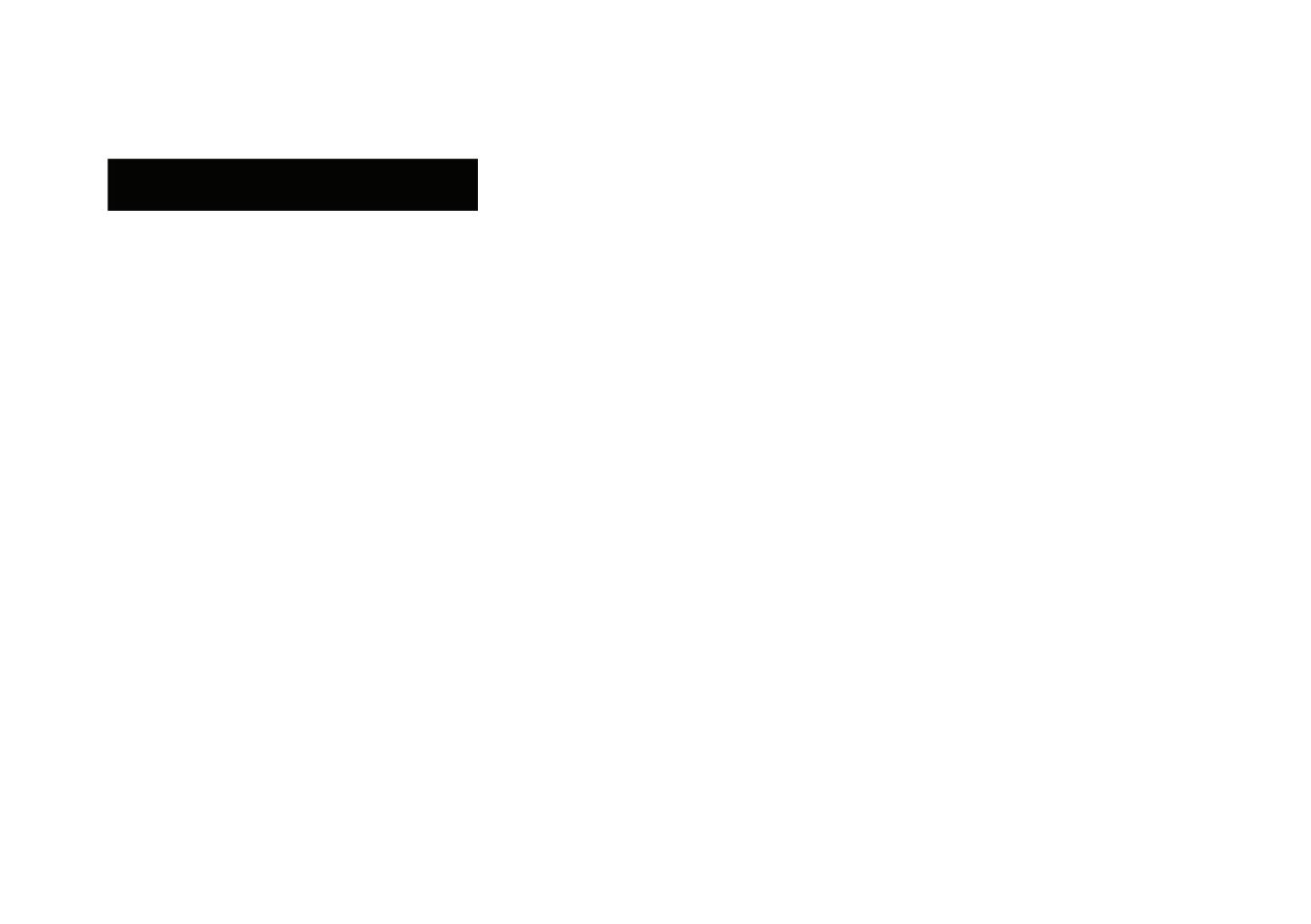


Assisting judge Jack Ward was Herefords Australia Youth member Mitchell Taylor, Quipolly, NSW. Mitchell received the opportunity after winning grand champion junior judge at the 2023 Herefords Australia National Youth Expo.
Yagaburne Prunella U369 (P) exhibited by Yagaburne Pastoral Company, Goondiwindi, was sashed as female calf champion and in reserve as Welray Corisande 84 U968 (H) exhibited by Selwyn Weller, Welray Partnership, Nabiac, NSW.
The male calf champion Braelyn Renault U034 (H) was exhibited by Neville and Denise Shannon, Braelyn Herefords, Texas, Qld, and in reserve was Welray Unleased U970 (AI) exhibited by Welray Partnership.
Commercial Hereford breeder Nicole Hayes, Undoolya Station, Northern Territory, sashed the champion junior female Kianma Last Day T016 (ET) (PP) and reserve junior champion Kianma Princess, both exhibited by Kianma Poll Herefords.
Junior champion bull was won by Te-Angie

Tyson T009 (PP), exhibited by Oglivie & Sons, Wongwibinda, NSW, and reserve was Braelyn Pioneer T085 (P), exhibited by Braelyn Herefords.
Senior and grand female champion was awarded to Kianma Princess S009 (AI) (P) and her January drop heifer calf, Kianma Princess V1, exhibited by Kianma Poll Herefords, whilst in reserve was Truro Queenie S147 (P), exhibited by Scott and Pip Hann, Truro Whiteface, Bellata, NSW.
Senior and grand champion bull Kianma T-Rex T002 (P) was exhibited by Kianma Poll Herefords, while senior reserve champion went to Truro
Jack Ward paid tribute to Mitchell Taylor as associate judge, saying he had a tremendous eye for cattle, enthusiasm on the microphone and was professional in his manner.
“I suspect you will see Mitchell for a long time around Australia working through cattle shows. His sister is out in the ring helping and they have both started their own stud herds, and I encourage you to continue to mentor these folks along as they will be true assets to the breed.”















Devon Court Herefords gives you the opportunity to purchase the very best in what we have to offer, from sires we have selected from our own program to some of the breed’s best leading sires from Australia and the around the world. Select your next sire for breeding season with the click of a button.
SCAN QR CODE TO ACCESS MORE DETAILS
All purchases of semen are sold in 10 straw packages. All shipping costs are extra and will be billed separately.



Devon Court, Drillham Qld 4424
Email: tom@devoncourt.com.au
Web: www.devoncourt.com.au


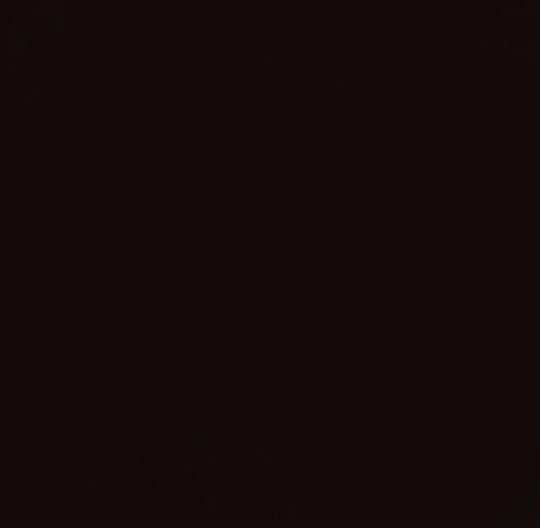







By Kim Woods
HEREFORD and Hereford influenced cattle are being positioned as global beef industry leaders for sustainability with superior feed efficiency and reduced methane emissions.
American Hereford Association (AHA) chief operating officer Shane Bedwell addressed the Herefords Australia Breed Forum at Wodonga on May 14 on the Association’s work to establish a greenhouse gas emissions baseline for Hereford cattle and develop a model/index for Herefords to continue to drive demand for all segments.
The project is a collaboration with Colorado State University to study the genetics contributing to methane production and nitrogen excretion.
The research leveraged decades of phenotypes for individual feed intake collected by AHA members as well as previous feed efficiency research conducted by the Association.
“Long term this project will identify potential tools to reduce beef production’s environmental footprint,” Mr Bedwell said.
“The Hereford breed has been sustainable for a long time being one of the oldest beef breeds in the world.
“We are taking our message deeper into the supply chain – the consumer, retailer and big corporates are needing help to assist their bottom line relative to methane free emissions.”
Mr Bedwell said US Meat Animal Research Centre data revealed a lot fed Hereford steer eats an average of 0.9kg less per day than an Angus steer. This was extrapolated over the 165,634 head of Hereford and Hereford influenced cattle fed under the Certified Hereford Beef brand in 2021.
“Herefords consume 86.8kg less of corn per steer over their feeding period compared to the Angus steers. Because of the efficiency advantage, Certified Hereford Beef cattle reduced corn consumption by 1,649,304 kg,” he said.
“That equates to 30 days of corn feeding a 100,000 head feed yard in the US.
“Given it takes 204 litres of water to grow 0.45kg of corn, Certified Hereford Beef cattle required 6,466,804,723 less litres of water.
“Water is the most underrated resource we have – they are not making more water and we have to utilise the water we have more efficiently.”
Delegates to the 2025 World Hereford Conference in the USA will tour the Hereford research herd in western Nebraska where data has been collected since 1999 on individual phenotypes across 1000 steers with 15 different sires.
A feed intake facility was added in 2010 followed by inpen weighing systems and data is now being collected on methane, carbon and water intake.

“I don’t know of another facility in the world that’s collecting this amount of information on a set of pedigree steers which can be tracked back to 1999,” Mr Bedwell said.
“This will establish a base line for Hereford cattle relative to greenhouse gas emissions and our early data shows it is highly correlated to feed intake.
“We are looking forward to developing a model relative to methane and working that potentially into an index or new trait. By the 2025 World Hereford Conference, we will have individual methane and phenotypic data on over 1000 animals through a sire test program.”
Mr Bedwell said the red and black baldy female was the core of AHA’s business and one of its greatest opportunities with Hereford bull sales comprising 25 per cent of the market, and increasing year-on-year.
“The baldy female is the king cow in the US – from the north with the British cross, being the black and red baldy, to the south with the Tiger stripe and five star (Santa cross) being the most favoured commercial cow in the industry,” he said.
Heterosis research in the early 2000s in ranch settings in California and Missouri revealed a similar outcome in the two different environments with increased calf weights, a healthier calf, and advantages in growth, weight, efficiency, and carcase merit.
“Where Hereford really fits in the US right now is the maternal heterosis side – when the study was summarised in 2007-08 our input and sell prices were cheaper. The University of Tennessee took the same data set looked at in 2023-24 to see what the difference was.
“Due to the direct advantage and maternal heterosis of using a Hereford bull on a British bred cow base, the net return to the producer was $90 more per cow over an Angus bull on an Angus cow.
“The net worth of the baldy female is significantly more because she has the ability to breed back a higher percentage of those calves. We found heterosis resulted in a 7-8 per cent advantage in conception rate – not only is that baldy female producing more pounds of calf, but she is staying in the herd longer.
“This simulation projected over a 10-year period an advantage of $300 per cow from a net worth standpoint.”








By Kim Woods
LINKING paddock, crush-side, feedlot and abattoir data is now possible to lift productivity and profitability in commercial beef enterprises.
Speaking at the Herefords Australia Breed Forum on May 14 at Wodonga, Optiweigh support manager Max Laurie said agtech was rapidly improving productivity within the beef industry.
“It is products like Optiweigh and Black Box that are allowing us to measure efficiencies to help us increase productivity and reduce those labour units. In future, there will be lots of data, more remote monitoring, automated tasks in livestock monitoring and machinery, resulting in improved production efficiency, less labour and helping our environmental management,” Mr Laurie said.
“We are starting to see that in terms of autonomous spray drones, virtual fencing, pasture monitoring, livestock weighing, and asset monitoring. All these tools are sitting there - it is just how they might be implemented into your business.”
Mr Laurie said Optiweigh measures minimum and maximum liveweights, the average daily gain and summarises the spread of weights within the mob.
He said variations and trends in average daily weight gain could pinpoint impacts of animal health issues such as worm burdens, or pasture quality and quantity, water quality and even genetics.
“There are productivity gains to be achieved just out of monitoring livestock more readily and removing those dips. As the margins get tighter and input costs increase, these tools are there to help producers make those management decisions,” he said.
“In terms of increasing average daily gain we have been seeing with producers using Optiweigh it has been in pasture utilisation and optimising grazing rotation.
“Picking up nutritional deficiencies has also been important when dealing or moving livestock, along with the impact of rain, heat and cold weather.”
Mr Laurie said the next step for Optiweigh was to run weight gain data in parallel with feed conversion efficiency and methane emissions using industry collaboration.
“We have to have more efficient stock and part of that comes down to the collaborations we have now – there are products out there picking up feed conversion and grazing optimisation to ensure producers manage their pastures to maximise their animal’s performance.”
Herefords Australia chief executive officer Michael Crowley said feedback was critical for producers to know the impact of their breeding programs on their customer’s business.
While collating MSA data from abattoirs, Mr Crowley found the Black Box Co dashboard had all the data in one spot – feedlot entry weight, average daily gain, animal health treatments, feed conversion, exit weight carcase weight and carcase data including MSA Index.

“There are big opportunities to send information forward with animals through the supply chain,” he said.
Black Box Co senior client manager Edwina Warby said the centralised data storage and analysis software integrated with all crush side systems and data received from abattoir.
“Black Box Co uses an interactive dashboard to turn raw data into insights and increases transparency across the supply chain,” Ms Warby said.
“The internal analytics enable visual reporting and analytics for on-farm and feedlot performance and carcase data. The feedlot feedback system enabled the sharing of data back to feedlot suppliers.”
Ms Warby said Black Box Co worked with 30 per cent of grain-fed cattle nationally to complete the feedback loop to producers but have feedback available with many more through request.
“Many people open their carcase data, look at the dollar figure, and close it. We are working to make the data more accessible, easy to interpret, and linked back to genetic and management decisions on-farm,” she said.
“Black Box Co provides on-farm support to collect meaningful data and turn it into insights with cloud-based reports. Users can easily analyse fertility and wet rebreed performance by breed, sire, classes and age, while feedlot and carcase results can be linked back to DNA and crushside data.
“Feedlot and carcase data, such as induction, exit and carcase weights, average daily gain, marbling and eye muscle area, MSA Index and compliance is linked to on-farm results of breeds, mobs, sires, and property of origin.”
Black Box Co integrates the animal data with other agtech software including Optiweigh using liveweight and average daily gains to predict the number of animals hitting the target weight range and financial forecasting.



By Kim Woods
HEREFORDS have proven their finishing ability off grass by winning the highest carcase score as a pair and placing second overall for average daily gain and carcase, in Australia’s only grass-fed trial at the 48th Lardner Park Steer Trial in Victoria.
The trial results were announced at Farm World at Lardner Park, Warragul, on March 24.
Tim Hayes, Tarcombe Herefords, Ruffy, Vic, won the highest carcase score as a pair on an average of 88.72 points.
First time entrant Alistair Black, Riverline Herefords, Sale, Vic, was runner-up in the combined weight gain and carcase award on a total of 217.23 points with his pair of purebred steers.
At the fifth and final weigh in November, the steers entered by Mr Black notched up individual average daily gains of 1.65kg and 1.28kg to give an overall average of 1.46kg. The average overall daily gain for the trial was 1.24kg.
Mr Black’s top steer was second overall in the individual average daily gain for the trial.
It was a first-time entry in the trial for the fourth generation commercial Hereford producer, who selected his steers on evenness and type.
The overall winner was Malcolm Reedy, Eagle Rock Angus, Garfield, Vic, on 1.56kg with his pair of Angus steers and the top individual average daily gain of 1.67kg.
Tim Hayes entered two teams with his top team having a carcase weight of 266 and 273kg, eye muscle area of 70 and 73 sqcm, rib fat of 8 and 7mm, and MSA Index of 61.41 and 62.25, to win the carcase score and place the team sixth overall.
Eight producers with 12 purebred and infused Hereford teams entered the trial which began in July 2023 with 68 mixed breed steers entered from around Victoria from 25 producers.
The steers were grazed on a mix of ryegrass and clovers and supplemented with a molasses based mineral feed.
The steers were processed after 160 days on December 4 at JBS Brooklyn with the carcase data analysed by Agriculture Victoria. The average carcase weight was 269.8kg, average dressing percentage 52.7, average P8 fat depth 7.7mm, average rib fat, eye muscle area 66sqcm, ossification score of 123 and MSA Index of 61.72.
Mr Black’s pair of steers finished at 600kg and 550kg liveweight, 313kg and 282kg carcase weight, dressing percentages of 51.3 and 52.2, rib fat 7 and 5mm, 69 and 67 sqcm eye muscle area, and one of the highest MSA Index of 64.21 and 61.80.

The black baldy team from Barb Stewart, Riverbend, Kernot, had an average daily gain of 1.39kg and placed fourth overall with a total score of 215.49.
A team from David Meikle, Tarwin Poll Herefords, Meeniyan, placed fifth overall on 210.26 points and had MSA Index scores of 61.37 and 60.45.
Two teams from Stan and Denise Walker, Charellen Poll Herefords, Pearsondale, recorded an average daily gain of 1.31 and 1.16kg, with the top team placing 10th overall.
Alistair Black likes the Hereford breed’s docility and doing ability, and in modern times has used River Perry, Charellan and Mawarra genetics.
He runs a herd of 65 spring calving breeding females on alluvial soils along the Thomson River in a 525mm rainfall zone with help from his son Tim.
The herd is accredited under the Greenham Never Ever program with steers and surplus heifers either sold through Leongatha store and prime markets or direct to the processor or restocker, depending on market prices.
Mr Black said the positive feedback quantified his breeding program and bull selection criteria.
He intends to enter the competition in 2025 and considers it be a great learning exercise.
“The whole purpose of entering was to promote the breed.
“I have just sold steers and cull heifers finished on Greenham Never Ever pellets for 70-90 days to Greenham. It is nice to see how the Herefords do grow out under those grain-free pellets.”


Whole herd genomically tested to identify homozygous
Top 15% of breed for eye musc e area & better

and docility EBVs to improve temperament


By Kim Woods
A CROSS breeding program using Hereford and Angus to lift on-farm productivity has produced the champion feedlot performance team in the 2024 Beef Spectacular Feedback Trial.
Bill Garnock, Boco Pastoral Company, runs 1400 wintercalving cows at Nimmitabel, in the NSW Snowy Mountains, with his son Charlie and daughter-in- law Manon, using the natural heterosis of the black baldy to drive fertility, growth, weight gain and carcase traits.
Mr Garnock entered two teams of 12-month-old black baldy steers in the Beef Spectacular Feedback Trial to validate his breeding objectives of progeny with consistent feedlot performance.
The trial at the Teys Australia Jindalee feedlot, Stockinbingal, NSW, is the eighth time Mr Garnock has entered the competition.
He uses the feedback from the feedlot and carcase components to finetune his breeding program to achieve optimum feedlot average daily gains and feed efficiency, and eating quality in the chiller.
Boco Pastoral’s top team of five black baldy steers scored 315 points to place first in the feedlot phase and third overall from 91 teams with a total score of 790 points and a team profit of $776 above the average.
HGP-free and Bovilis MH + IBR vaccinated steers were entered from the eastern states, as far south as Gippsland and as far north as Condamine, Queensland, with 16 breeds represented.
The Boco Pastoral team scored a maximum of 100 points in the feedlot entry which was judged on induction weight, rump fat, frame score, dentition, NVD completion accuracy, pre-feedlot vaccination with Bovilis MH + IBR.
In the feedlot, the team had average daily gain ranging from 2.2 to 2.76kg, ranking them first out of 91 teams. The average daily gain for the trial was 1.95kg.
In the carcase assessment, the team’s top dressing percentage was 53.3, eye muscle area of 87sqcm, AUS-MEAT marble scores of 1, 2 and 3, and MSA indexes of 60.89 to 65.14 to give an overall team profit of $776.57 compared to the average of all trial teams (average adjusted to zero). The average MSA Index for the trial was 62.2 and average AUSMEAT marble score of 1.5.
Set in a 600mm rainfall zone, the 6477ha freehold and leasehold aggregation runs 26,000 DSE on basalt soils with the equivalent of three full-time labour units.
The cattle herd is run under challenging conditions and calve in July/August when winter temperatures can be down to -12 degrees Celsius.
“There is no doubt the Herefords are better foragers on the cold, hard native pastures here,” he said.
Hereford bulls are joined to ex-stud Angus cows and exstud Hereford cows are joined to Angus bulls to produce a moderate framed animal with length, weight for age, doing ability and above average carcase quality.
Mr Garnock said the hybrid vigour of the black baldy resulted in an advantage of a 10 per cent increase in weight gain at weaning.
“The doing ability of the Herefords contributes the weight gain in the black baldy.”
In the early years of the feedback trial, he entered an Angus, Hereford and two black baldy teams to gain a comparison but now concentrates solely on the performance of the black baldy.
Bill has used the feedback to finetune his breeding program, boosting his teams to the top in feedlot performance and increase carcase grading scores.
“The idea was to keep the doability and feedlot performance in the top percentile while combining above average carcase traits to lift meat quality.”
He selects bulls on a balance of carcase and growth traits, combined with moderate birthweight aiming to produce a moderate mature weight, feed efficient and fertile female.



By Kim Woods
WHITEFACE vendors pocketed an extra $163 a head for steers and $69 for their heifers above other British breeds at the 84th annual Mountain Calf Sales.
Held at Benambra, Ensay and Omeo on March 5-6, 2024, the Mountain Calf Sales yarded 7738 cattle in the Elders dedicated sales to average $1047 and gross $8.1 million.
Whiteface steer prices peaked at Omeo at $1800 and for heifers at $1400.
A cautious start to the 2024 Hereford weaner sales had seen prices peak at $1328 for 405kg autumn drop steers at Hamilton on January 9.
But NSW and Victorian buyers came roaring back to the high country creating a bidding frenzy over the top end autumn drop calves with the weight, genetics and consistent performance from the paddock to the chiller.
Repeat steer finishers who turned off their steers bought 2023 calf sales did not hold back when it came to bidding on the heavy end with prices hitting the seasonal high of $1800 for Herefords in 2024.



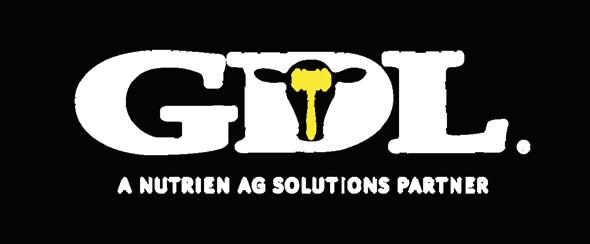
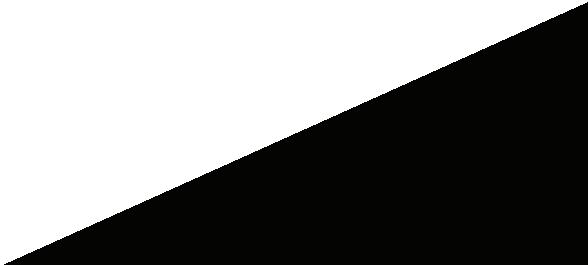


By Kim Woods
HEREFORD’S early maturity, weight gain and finishing ability on grain is resulting in a profitable return on investment for a family-owned breeding and lot feeding enterprise in southern Queensland.
The Bowhay family specialises in finishing steers and cull heifers for 100 days on grain to 400kg carcase weight with low ossification scores, and marble scores of 1 to 2 before the age of two years.
“The carcase specs are 320-400kg – that is an easy target for us to hit when turning the cattle off by two years and the Herefords do that comfortably,” Mark Bowhay said. George and Robyn Bowhay, their son Mark and his wife Rina, and his brother Stephen, operate Buckinbah, a vertically integrated cropping and beef enterprise across 16,194ha at St George, value adding grain through an accredited 500 head on-farm feedlot to turn off heavyweight steers to Kilcoy Global Foods.
The September/October calving herd of 850 Hereford cows is run on black soil Mitchell grass and red Mulga country in a 475mm rainfall zone.
An irrigated cropping program produces wheat and fodder for the feedlot while the cow herd grazes Mitchell and Buffel grass pastures. Calves are bunk trained at weaning in the feedlot and then finished to feedlot entry weight on grazing oats.
The family sources bulls from Talbalba Herefords and uses artificial insemination every few years in selected heifers for rapid genetic gain.
They cull hard on fertility and were previously part of the Meat and Livestock Australia’s CashCow project. The project investigated the causes of poor reproductive performance in northern Australian beef herds, including environment, nutrition, management and infectious disease.
“Usually, we only join for two months, and we are always striving for fertility. Our heifers don’t get any special consideration and we fertility test our bulls every year,” Mark said.
“The CashCow project gave us a lot of good feedback on nutrition – we were happy with our fertility rates with the cows up around an average of 90 per cent calving rates over the life of CashCow.
“We strive to be up around 97 per cent calving rate and maintain that. Nutrition plays a part in fertility with a lot of Australian soils being phosphorus deficient, but a big part is management.”
The “deal breaker” traits in bulls are 600-day weight estimated breeding value, scrotal circumference over 40cm and 100 per cent eye pigment in both eyes. Maternal traits including milk and carcase indicators such as eye muscle area and intramuscular fat are also considered.
“We are not turning out weaners but heavyweight feeder steers to be finished by the age of two years,” Mark said.
“Kilcoy is our preferred destination, and the top of the grid is 400kg carcase weight. We need bone, length, depth and width in those calves. So, we are looking for large framed, fertile cows and big, fleshy bulls.
“Those steers have to be gone by the age of two – we don’t hang on to them until they are two-and-a-half or three-years-old.
“Our cast-for-age cows are also finished in the feedlot to over 800kg liveweight, so we lose there if we join them too young as heifers. It is a trade-off and one we are happy running with.”
The joining percentage has slowly declined from four bulls to 100 cows and is now at 3 per cent.
“CashCow pushed for a lower percentage and once again it is a trade off – the bulls are capable of doing better and I
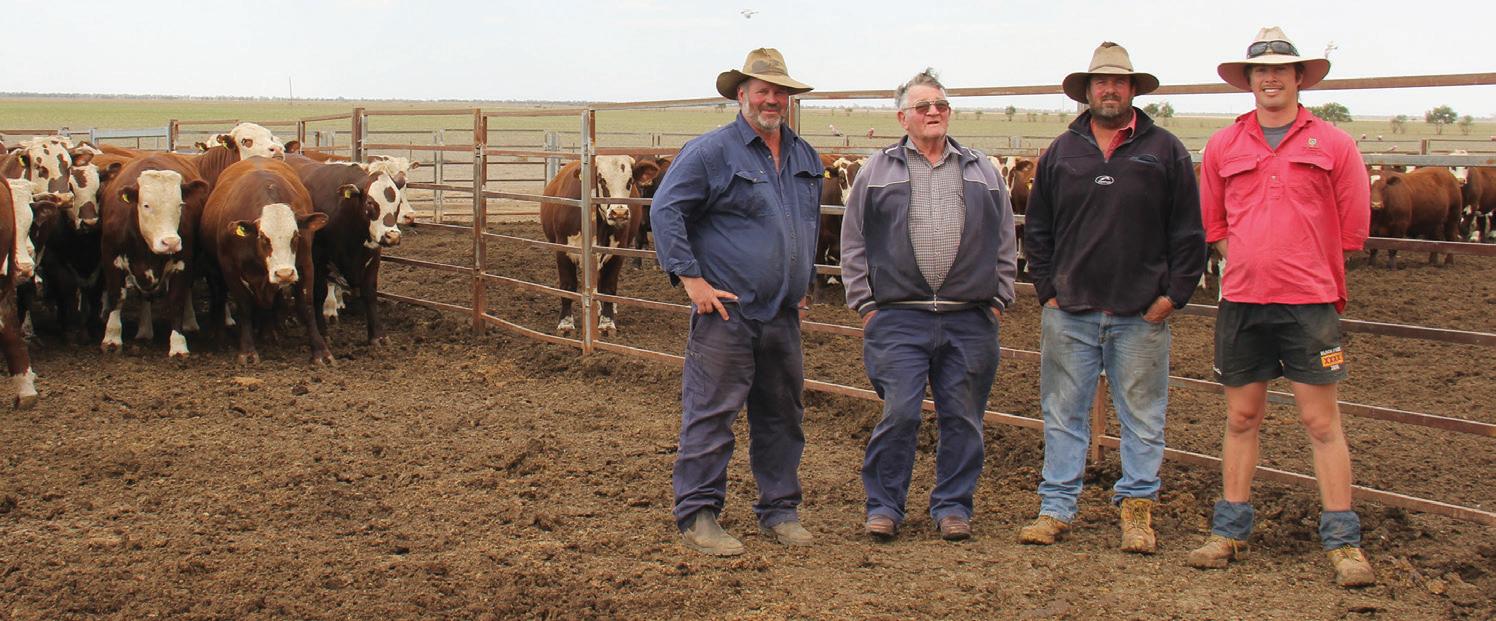
would be comfortable at 2 per cent, but in the commercial herd setting we don’t see them every day.
“We join the heifers for eight weeks and the cows 12 weeks in November to January, aiming for conception in those first two cycles but in saying that the weather can be quite hot (affecting fertility).
“We like the cows to calve a bit lighter in condition and then be on a rising plane of nutrition.”
Calves are weaned into the feedlot according to seasonal conditions rather than weight and bunk trained on a grain and fodder ration.
“The feedlot gives us the flexibility to wean calves earlier if we have to. It was built as a risk management tool for consistently turning off heavyweight steers by the age of two for premium markets in our variable climate,” Mark said.
“Our ration is a simple, traditional one of home-grown wheat and hay with the additives. Wheat is what cattle will perform on but it is higher risk, so we carefully manage the feeding in those first three weeks.
“We are aiming for the 400kg carcase, even in our cull heifers, so have two entry points a year – the first entry is for all steers and the second for cull heifers and tail end steers.
“We try not to feed over summer as we don’t get the average daily gain due to the heat. So, we calve over summer during our greatest grass growth, put the calves in the feedlot at the end of that pasture growth, and they are gone by the time they are two.”
Being one mark and vendor bred, the steers are well socialised and educated to the feedlot beforehand. An average daily gain target during the 100-day grain fed program is 2.5kg.
“We find the Herefords are feed efficient and the quiet temperament never goes astray. The heifers have the frame size to carry a 100-day feeding and can perform without a growth promotant,” Mark said.
Mark said the full Meat Standards Australia chiller feedback is evaluated and used to fine tune the breeding or feeding programs.
“Kilcoy also gives us their internal benchmarking feedback for the cattle killed in the same fortnight. It is handy to compare all the 100-day grain fed cattle subject to the same humidity and heat events and processed at the same time. They may have been under different feed rations and management, but they had to put up with the same weather conditions,” he said.
“Our average MSA Index is in the high 50s and 70 per cent of the bodies a marble score one. The ossification of our cattle usually shows up well as they are younger at heavier weights compared to the other breeds with a MSA score of 100 to 150.
“The Herefords early maturity and finishing ability at a younger age is an absolute advantage and that shows up in our benchmarking.”

With 60 years of rigorous selection, it’s no fluke that we have been highly successful in the show ring. Our cow herd puts on the kilograms when feed allows and holds condition when the feed is hard to find. Our annual rainfall is 14 inches, which means when you buy cattle with Minlacowie genetics they are bred to perform and adapt to your conditions.


By Kim Woods
ONE of South Australia’s most remote Hereford operations is pursuing an expansion program with an on-farm feedlot specialising in Hereford beef for the domestic market.
Carolyn Mudge, of Maildaburra Hereford Beef, at Wirrulla inland from Streaky Bay, had a soft launch with new branding in April 2024 and is feeding predominantly Hereford beef for the regional butcher trade and domestic processors in South Australia and Victoria.
Maildaburra Poll Herefords was registered in 1972 by Carolyn’s parents, Leon and Marilyn Mudge, and is the state’s only Hereford stud between Port Augusta and Western Australia. It is also the most marginal with an average rainfall of 300mm.
Carolyn operates three farms totalling 3036ha and share farms out 1214ha of wheat and barley with her brother. Her share is kept to value add the barley through the on-farm feedlot.
The stud herd of 160 breeding cows produces 30-35 bulls a year, with 35
heifers retained as replacements. The heifers are joined over nine weeks and the cows over 12 weeks for a July calving. About 50 selected cows are artificially joined using outcross genetics.
“No females are supplementary fed. It is marginal country with a variable rainfall, and we don’t expect to have green feed over summer,” Carolyn said. The family has been heavily focused on objective data and performance recording with Leon being an early adopter of BREEDPLAN. The majority of bulls are sold to commercial Hereford producers on the Eyre Peninsula and pastoral stations in northern South Australia.
In 2023, bulls were delivered for the first time to Cunyu Station at Wiluna in central Western Australia, 800km from Perth. The station has sent several road trains of yearling Hereford steers over a distance of 2100km to the Maildaburra feedlot in the past couple of years.
Other Hereford steers were sourced in 2023 from Charles Townsing, Cawkers Well, Wilcannia, NSW, with the mob putting on an impressive 250kg in
under 90 days to have an average exit liveweight of 650kg for processing at Oakdale Meat Co, Dandenong.
Set for expansion, the Maildaburra feedlot has up to 250 steers and cull heifers year-round, with preference given to Herefords, either home bred or purchased from clients or other quality sources.
Homebred calves are yard weaned for five days onto oats at five to seven months of age for heifers and males seven to eight months. Steers are backgrounded on pastures before feedlot entry at 300-400kg liveweight, depending on the season.
Exit weights were previously 500-550kg but changing market specifications have resulted in heavier weights of 650kg.
“I also have a market supplying steers and cull heifers to the Streaky Bay butchery with six head a fortnight at 500kg liveweight,” Carolyn said.
“Dad originally built the feedlot in the 1980s and was putting through 1000 head a year, buying station cattle from the Northern Territory. In more recent times, each year I had been


putting our own cattle through for three to four months of the year, until I decided to intensify that program.
“The cattle start off on an oat-based ration and then rolled barley is gradually added with mineral concentrate, lupins and lime as a cost-effective ration. The cattle also have access to hay ad lib.
“The cattle are weighed once a month to collect data on average daily gain, and given a vitamin A, E and D injection plus a backliner. I aim for an average daily gain of 1.8kg.
“I had a soft launch of the Maildaburra Hereford Beef brand in April and there may be opportunities for boxed beef in the future but at the moment that is not the focus.
“I am passionate about Herefords so only want to feed Hereford cattle. I like their temperament, weight gain and finishing ability.”
Beef is supplied to the Streaky Bay Meat Services, Ceduna Meat Service and year-round to Thomas Foods International, Murray Bridge.
“I also sent cattle to Oakdale, Dandenong, a distance of 1600km over two days and they dressed out at 50 per cent. The last load to TFI dressed out at 51.5 per cent,” Carolyn said.
“Before they go the cattle receive an injection of Vitamin A, E and D and travel well.

“I receive the carcase feedback and images, with the last load of Cunyu Station zero to two tooth steers averaging 310kg dressed, and a top MSA Index of 63.4, which is pleasing considering they travelled 750km to Murray Bridge.”
In 2020, Carolyn entered two steers in the Royal Adelaide Show carcase competition. One entry, Maildaburra Quality Q027, had an MSA Index of 68.72 after travelling the 1100km over two days to the abattoir. The steer was also first in the purebred heavy export class and third overall in the MLA prize for Best Export eating quality carcase.
“Ultimately with the feedlot I would like to be putting cattle through from clients using our genetics as I put a lot of focus on BREEDPLAN, selecting sires on low birthweight, above average 400-day weight, eye muscle area and intramuscular fat.
“That selection focus in the home bred cattle gives me the carcase results I’m seeking at the other end.
“The fantastic Hereford temperament means they settle on feed quickly and they are feed efficient.”
BELOW LEFT: These Hereford steers had an average daily gain of 2.3kg to finish at an average exit weight of 642kg for processing at Thomas Food International.
BELOW: Hereford steers being finished on a barley-based ration in the Maildaburra feedlot.
Images courtesy Carolyn Mudge
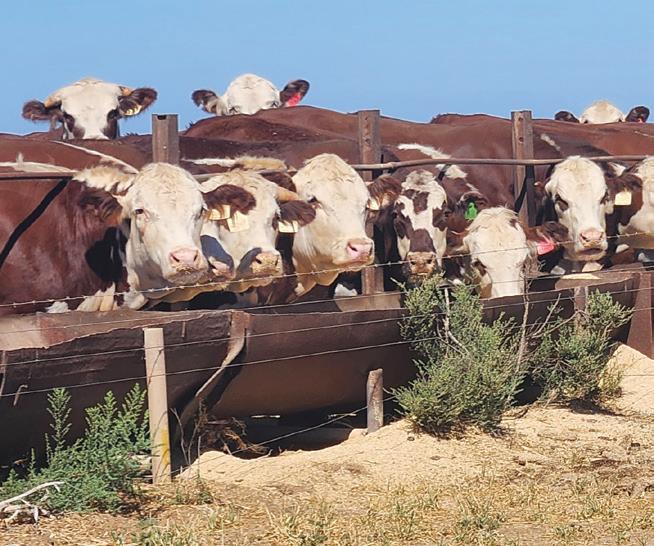

FOSTERING domestic and international collaboration, and equipping members with tools to increase productivity and profitability are among the aims of incoming Herefords Australia Chairman Marc Greening.
Mr Greening was announced as the Chairman, replacing the outgoing Chair Ian Durkin, at the first board meeting held the day after the Herefords Australia Limited annual general meeting on May 15 in Wodonga.
Mr Greening is principal of the southern NSW based Injemira Beef Genetics, one of the nation’s leading Hereford seedstock and commercial operations and has served on the Herefords Australia board as a director and deputy chairman for four years.
In addressing members at the Herefords Australia National Show, he paid tribute to Ian Durkin for stabilising the organisation, having a united team, focusing on financial fundamentals and placing the breed in the commercial world.
“Our board is focusing behind the scenes on developing the professional
manner of the organisation, and much has been achieved by our chief executive officers Lisa Sharp and Michael Crowley, over the past four years,” Mr Greening said.
“In the last 15 months Michael identified the commercial industry and processing sector we need to engage with and build our understanding of what our customers want.
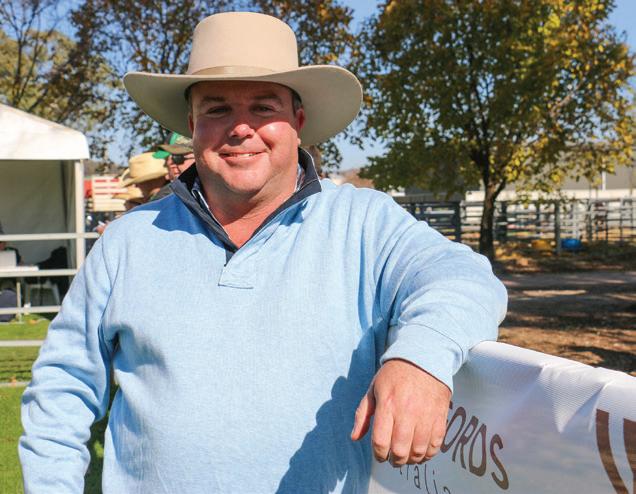
“The role of this Board is to set a precedent and template for the members to grow and succeed in their aims. We encourage members to get on the front foot and help promote the breed by equipping them with the right tools.”
Mr Greening said Herefords Australia was positioning itself long term to assist members, pointing to the Breed Forum held at Wodonga on May 14 as an educational tool for producers to hear about the latest innovations in
AMBROSE Kenney has been appointed as interim chief executive officer for Herefords Australia, undertaking the role temporarily while the Board continues the recruitment process to fill the role permanently.
This follows the completion of Michael Crowley’s appointment as CEO, moving on to take up the role of Managing Director with Meat and Livestock Australia.

Ambrose comes from a commercial cattle farming background and has been with the company since 2017, moving up through the animal registry, DNA and member services departments.
Chairman Marc Greening said an extensive recruitment process for the next CEO was underway with potential candidates from different states and varying backgrounds considered for the role. Quote from email blast?????????
Immediate past chairman Ian Durkin was elected as deputy chairman, Sam Broinowski as Finance, Audit and Risk Committee chairman and Youth Liaison Representative, Annie Pumpa as Member Liaison Representative, Marc Greening as Show and Sale Representative and Sam Becker as Research and Development Chairman.
A LARGE mural depicting Hereford cattle and Victorian High Country icons of the breed was unveiled to thousands of livestock buyers and visitors during the famed Mountain Calf Sales in March.
The mural was the brainchild of Hereford breeder Barry Newcomen, Newcomen Herefords, Ensay, and has been painted on a water tank at the Ensay saleyards – in the heartland of the Hereford breed - by Omeo artist Terry Petersen.
The painting depicts a mob of Hereford cattle with stockmen, including well-known Ensay breeder Phill “Bluey” Commins, Nunniong Herefords, on horseback, and Barry and his wife Topsy.
Barry said he wanted the painting to pay homage to the Hereford and its significance to the history of the Victorian High Country.

“The local shire built five concrete tanks at Ensay for firefighting purposes and there is one right opposite the saleyards. I decided it was a good idea to paint it with Herefords and there are a variety of scenes with Hereford cattle,” he said.
“I gave a few photos to the artist and he did a great job with the painting on the tank. It is a great promotion for the breed, and it is receiving a lot of publicity. We are hoping visitors will have a look at the tank and then have a meal at the pub to support Ensay.”
genetics, genomics, ag tech, carbon sequestration and the supply chain.
He said Herefords Australia was collaborating with domestic commercial partners and internationally with the American Hereford Association.
Herefords Australia hosted the American Hereford Association executive vice president Jack Ward and chief operating officer Shane Bedwell at Beef Australia 2024 and the 2024 National Show and Sale.
“The AHA aligns with what we are achieving in Australia in terms of sustainability, the ability to prove that Herefords are a maternal source and position Herefords as the number one choice for crossbreeding with Bos indicus cattle,” Mr Greening said.
“We can collaborate on a range of things in the future from performance recording and data sharing for projects, evaluating their marketing and messaging strategies, right down to their youth programs and potentially getting Australian youth involved in those American programs.
Mr Greening thanked outgoing chief executive officer Michael Crowley for his service to Herefords Australia over the past three years as a board and staff member.
“At Herefords Australia we are attracting high profile, capable CEOs and Michael was an example of that. Thank you for your service, it was greatly appreciated, and we wish you the best of luck in your new role at Meat and Livestock Australia.”
THE judging for the Hereford – Champion of the World competition took place from December 1-14 with Australian entries performing highly.
Australian sire Glendan Park Soprano S115 (PP) was awarded the gold medal in the Hereford – Champion of Asia/Africa, after taking out grand champion bull at the 2023 Herefords Australia National Show and Sale Wodonga.
The judges for the 12th annual Hereford – Champion of the World were Flavio Montenegro Alves, Brazil, David Giddings, New Zealand, Robert Clarke, England, and Tom
McNeely, Canada. The competition involved judging 2000 champion bulls and females across 16 breeds from around the world.
The announcement in Fort Worth Stock Show and Rodeo, Texas, on February 29 was attended by Liz Ikin and her grandsons, Cloverlee Poll Herefords, Bannister, NSW, to see Cloverlee Asteret EKI R604 be awarded 2023 Hereford –Miss Asia/Africa.
Asteret and her heifer Cloverlee Asteret T001 had been sashed as grand champion female at the 2023 Royal Canberra Show and Sydney Royal Show. The cow is a daughter of Tarlee Mustang and her calf by Mawarra Terminator Q274.
PREPARATIONS are underway for the 2025 World Hereford Conference to be hosted by the American Hereford Association in Kansas City, Missouri in October.
The program includes a welcome reception at the American Herefords Association headquarters on October 22, followed by educational sessions on October 23-24 and the closing reception on October 24. The program then moves to the Young Breeders Fitting and Showing Competition, American Royal National Junior Hereford Show and International Genetics Sale.
The conference will include a property tour from October 16-21 of Montana, which is home to 2.5 million head of cattle and some of the most pristine Hereford operations in the US.
The pre-tour will take attendees on an experience seeing Hereford cattle, agricultural history and US landmarks.
A post-tour on October 26-29 will take in the Sandhill sites and mountain views of Nebraska. An optional tour on October 26-29 is Lone Star and Sooner states, and Oklahoma City.
Each country represented at the Conference can have a team of four young breeders to take part in the Young Breeders Competition hosted at Kansas State University, taking part in a variety of skills-based events.
ANOTHER group of young sires from across the nation has been inducted into the ranks of the Herefords Australia Super Sires catalogue.
Out of the 90 bulls from 13 herds that were eligible, four have been nominated as Super Sires.
The new nominations from round seven are Days Landlord T064 (AI) (PP), Elite Q194 T058 (AI) (PP), Wirunna Smokin Joe S010 (AI) (PP) and Yavenvale Taylor Made T874 (AI) (PP).
All bulls embody a balance of high performing genetic traits suited for grain and grass-fed operations.
The four new sires take the total number of Super Sires to 44 offering breeders an even greater choice when selecting Super Sire genetics to use in their operations.

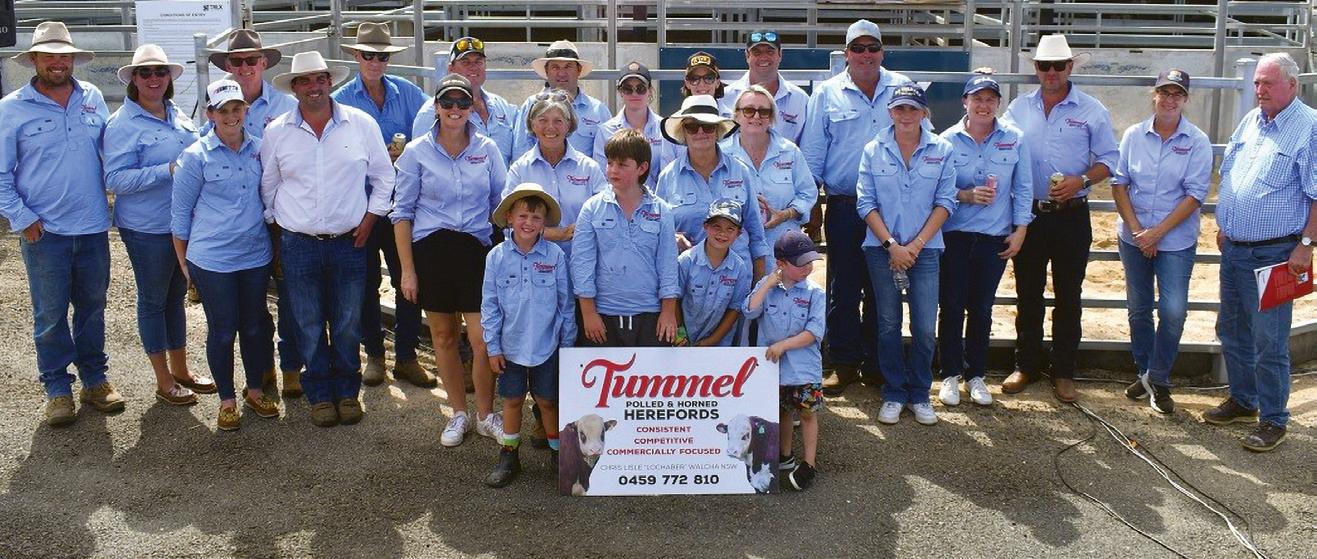
By Ro Koebel
THE first phase of the dispersal of the Walcha based Tummel Hereford stud took place at Tamworth Regional Livestock Exchange on February 28.
Established in 1956 by Gordon and Olga Lisle, the Tummel stud was the ongoing passion and life’s work of their son, Chris Lisle, who tragically passed away due to a horse-riding accident in September 2023.
The sale was well supported with 203 head plus 113 calves sold across 159 lots to average $2830 with a clearance of 92 per cent.
Poll Hereford cows and calves averaged $3535 and sold to a top of $9250 for Mawarra Minerva 224 R351
bought by Sugarloaf Creek Herefords, Towong, Victoria.
Horned Hereford cows and calves averaged $3324 and sold to a top price of $8250 for Mawara Maritana 192, purchased by long-time friends of the Lisle family, Scott and Pip Hann, Truro Herefords, Bellata.
In the heifer portion of the sale PTIC Poll Hereford heifers sold to a top of $5500 and averaged $2806.
The top priced polled heifer was Kidman Albia T081, purchased by Ben and Leanne Rumbel of Supple Whiteface, Guyra. The August 2022 drop heifer was PTIC to VP Redford T058, a son of record-breaking Super Sire Injemira Robert Redford Q287.
PTIC horned heifers averaged $2432 and sold to a top of $4750 for Tummel Diamond T232. The 19-month-old Diamond T232 was sired by Wild Bear Play Maker P009 and PTIC to VP Redford T058.
Unjoined Poll Hereford heifers averaged $2531 and topped at $4500, while unjoined horned heifers averaged $1528 and fetched a top price of $1750.
Groups of commercial cows (some with calves at foot) averaged $1869 per head and fetched a top of $2700 per head for a group of five 24-36-month-old horned cows and calves which sold via AuctionsPlus.






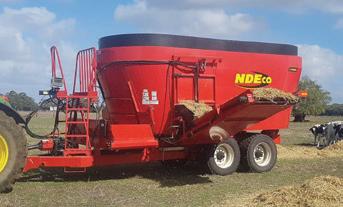





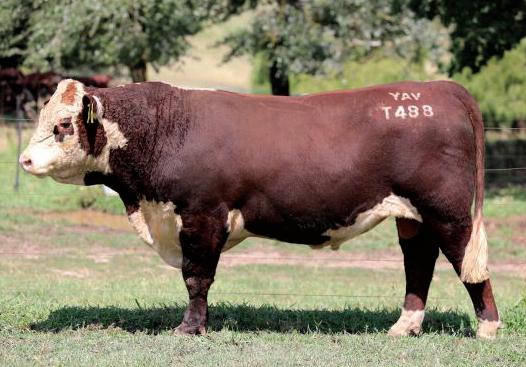

By Hamish Chandler
HOW fast we make genetic improvement in our own breeding programs and as a breed is heavily influenced by our accuracy of selection.
Higher accuracy of selection simply means we can make the right decision more often when we are choosing the best animals to breed from. The role of Hereford BREEDPLAN is to give us the highest possible accuracy of selection for the traits that we can measure objectively.
We are in a fortunate position because Hereford BREEDPLAN is backed by an extensive research and development program of work. This R&D is conducted by ABRI and AGBU, but also by a range of other organisations supported by MLA’s National Livestock Genetics Consortium. The alignment between R&D and the delivery of BREEDPLAN means that as soon as new R&D is completed and the outcomes are implemented into the genetic evaluation, Hereford breeders get the benefit with higher rates of genetic improvement based on better accuracy of selection.
As a result of the most recent developments, we will be implementing several updates to the Hereford BREEDPLAN evaluation later this year. As with all updates to the

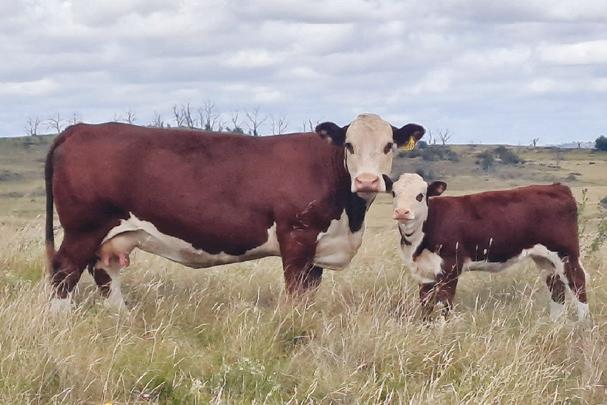
evaluation these developments have been extensively tested and we are confident the updates will give Hereford breeders better outcomes and enable better rates of progress.
Of course, any changes to the evaluation means some breeding values will change and this means there will be some reranking of animals. To minimise any disruption that this may cause the changes are due to be implemented as of the October BREEDPLAN run.
The key changes are outlined below. If you would like any additional information about these updates, please contact the office.
The Hereford BREEDPLAN analysis makes use of genomic tests of various sizes, typically from 30,000 SNPs to 100,000 SNPs.
These genotypes are then imputed up to a much larger SNP list for use in the BREEDPLAN evaluation. Imputation is best described as filling in blank spaces in a sentence or story, if we have read a similar story before it is much easier to fill in the blank spaces.
Similarly, imputation of genotypes relies on having a library of genotypes for similar animals. Updating our library means that we can impute genotypes with greater accuracy.
As more genotypes are now available for the Hereford breed, we will be updating the library used for imputation. This will mean some improvement in accuracy and means a small number of animals that were previously having their genotypes excluded from the analysis will now have that information brought in.
Alignment between the current library and updated library is high, therefore changes to EBVs because of this update are expected to be relatively minor.
Single step BREEDPLAN analyses use pedigree, performance, and genomic information simultaneously to calculate the highest possible accuracy EBVs using all available information. In this type of genetic evaluation genomics contributes by telling us the number of genes individual animals share, or in other words, it is giving us a much better understanding of the relationship between animals. The challenge with this approach is the relationship you get from pedigree records and the relationship from genomic information are not the same.
The diagram (Figure 1) shows the relationship between an animal and its grand-progeny. Based on pedigree alone we have to assume that all grand-progeny share the expected 25 per cent of their genes with their grand-parent. Once we have genomic information, we can see that there is variation in how closely related each of those animals is to the grandparent, in this case a range from 23 to 27 per cent. Understanding this difference allows more appropriate weightings to be applied when using relative’s performance to calculate higher accuracy EBVs.





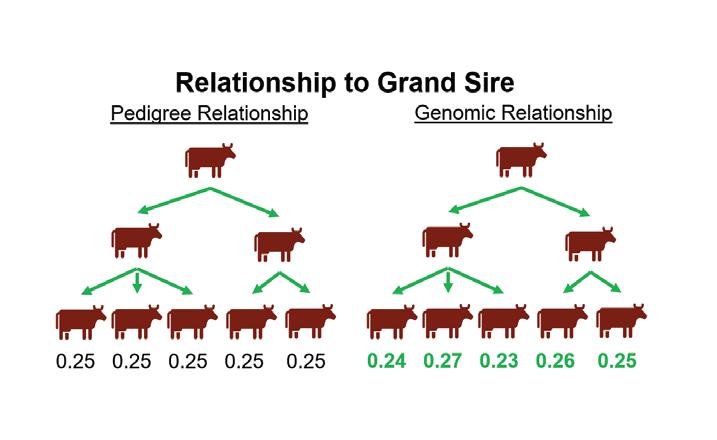
used to combine the relationship information from these two sources. Since Hereford BREEDPLAN was first introduced in 2017 a lambda value of 50 per cent has been used. More recent work conducted by AGBU has shown significant advantages in moving to a lambda value of 95 per cent.
Doing this means the relationship value between animals used in the analysis aligns much more closely with the genomic records. More importantly it has been demonstrated to give us higher accuracy EBVs as well as improvements in other quality metrics for stability and bias.
The scatter plots on Figure 2 show the impact of changing lambda on the accuracy of EBVs. The blue dots represent EBV accuracy for animals out of an analysis using pedigree only and not genomic information. The orange dots represent EBV accuracy for animals using the current model with lambda at 50 per cent and the green dots represent the new analysis moving to lambda at 95 per cent.
As shown in the plots the impact differs between different traits depending on the heritability of the trait and the size of the reference population for that trait. As an example, we see greater improvement in accuracy for Weaning Weight in comparison to Days to Calving as Weaning Weight has a

significantly higher heritability and we also have a bigger reference population.
The other point to note is we see a much bigger improvement for the animals that have low accuracy EBVs in the pedigree only model. For example, we see a much bigger improvement in accuracy for young animals that don’t have any phenotypes recorded in comparison to sires with progeny information already on file.
This is worth considering when planning the genotyping strategy for your herd. Genotyping calves earlier on in life will give you higher accuracy EBVs early on in life that will also be more stable and less likely to change as more information becomes available.
Calving Ease is a challenging trait to include in a genetic evaluation because of the categorical scoring system and the low frequency of calving problems. Calving Ease has to date been analysed in a separate sub-analysis using calving difficulty scores, birth weight and gestation length.
It has not been possible to use genomics as part of the Calving Ease analysis as appropriate methodology has not been available. A new model has now been developed that will allow Hereford BREEDPLAN to move to SingleStep Calving Ease meaning that for the first time genomic information will contribute to calculating Calving Ease EBVs.
The changes to the Calving Ease analysis are based on a new solver (software) being used but will also mean the inclusion of genetic groups and changes to contemporary groupings.
The benefit of these changes is there will be a large increase in the number of animals included in the Calving Ease analysis, there will be a significant increase in the accuracy of Calving Ease EBVs and these EBVs will be more stable with less bias.

As shown in Figure 3, these changes will mean that we will see a much larger range in Calving Ease EBVs, and we will see significant changes for some animals.
The scatter plot shows results from the existing analysis along the horizontal axis against results from the new analysis on the vertical axis. The yellow shading on the chart indicates that most animals sit in a range where there are not particularly large changes between current and new analyses. But the darker blue dots show that there are animals that will change significantly.
It will be important to keep in mind the new analysis will give us more accurate Calving Ease EBVs that are more reliable and for more animals. This means as a breed we will be well placed to make better progress for this economically important trait. It will also be important to remember the new Calving Ease EBVs should only be compared to the breed average and percentile bands table from the same analysis. The previous benchmarks will no longer be relevant.



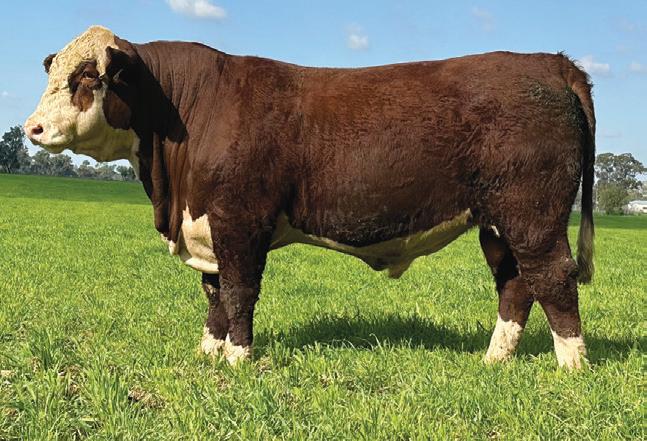



At the 2023 Hereford AGM, the board announced a new strategic direction for the breed focussing on sustainability. In developing the approach for addressing this from a breeding program perspective we have considered what can be done now, what comes next as a focus for the medium term, and what needs to be done in the longer term.

What we can do in the immediate term to address sustainability priorities is update Hereford indexes so responses to selection decisions in our breeding programs have better impacts on sustainability. This can be done using traits that we already have access to.
In the medium term our focus shifts to capturing better information to improve the accuracy of selection for existing traits important to improving sustainability, for example mature cow weight and net feed intake. Improving the accuracy of EBVs for these traits means greater responses to selecting based on the index. The longerterm strategy is to then develop breeding values for new traits that address sustainability such as a direct measure of methane production.
As part of the immediate term strategy, we have been working with AGBU to develop two updated indexes for the Hereford breed. Methane production is the biggest sustainability indicator for us to use, it represents lost or wasted energy. More efficient animals and more efficient production system produce less methane.
However, we need to be conscious of how we define methane production. We can talk about it in two ways; total methane produced, and
methane intensity or the amount of methane produced per unit of product. To improve both sustainability outcomes and continue improving productivity we need to include both metrics in our breeding objective.
The development work that has been done using BreedObject to update indexes has shown this can be achieved. By increasing the feed cost used in the model it puts more pressure on traits that influence total methane production, such as mature cow weight and feed intake. At the same time, it retains as much as possible of our improvement in productivity traits that influence methane intensity such as growth and reproduction.
The bar chart (Figure 4) shows the changes in selection differentials for different traits for the Southern Self Replacing index as feed cost is increased by 10, 20 and 30 per cent. The most acceptable option is increasing feed cost by 20 per cent. The outcome is that we end up with an index that is quite balanced across the major trait groups impacting on profitability as well as sustainability.
The index puts more downward pressure on cost of production through mature cow weight but has similar pressure on improving cow/calf survival, growth, reproduction, carcase weight and eating quality.
Changing the Southern Self Replacing index to a Sustainability index with an additional 20 per cent feed cost gives an index that is strongly correlated with current values with a correlation of around 99 per cent.
This would lead to some reranking of animals. However, the other changes to the analysis, particularly changes to the Calving Ease analysis, will have a flow on impact on index values. Once changes to the analysis are accounted for in addition to changes to the index, we will be expecting a correlation of 92 per cent.






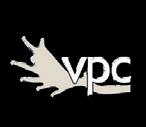

By Kim Woods
IT was a stunning trifecta for the Sykes family at the 2024 Herefords Australia National Show and Sale at Wodonga with junior, intermediate and bulls culminating in the grand champion sash.
The family’s Mawarra Genetics, of Longford, Vic, exhibited the junior and grand champion, Mawarra Whiteout T290 (S), the intermediate champion, Mawarra Whip Cracker T229 (PP), and senior champion, Mawarra Western Star T060 (AI) (PP) under international judge Shane Bedwell.
Held at the Wodonga Exhibition Centre on May 15, the Herefords Australia National Show drew 122 bulls from 45 vendors, including five new vendors of Ardno, Chanel, Kalara, Oak Hill and Winchester studs.
The 21-month-old Mawarra Whiteout T290 was sired by Mawarra Showtime P277 and out of Mawarra Miss Titania 127. Weighing 924kg, the young sire had a raw eye muscle area scan of 136sqcm, rump fat of 25mm and rib fat of 16mm, and a scrotal circumference of 40cm.
Whiteout ranked top 2 per cent on BREEDPLAN for milk at +26kg, top 5 per cent for eye muscle area at +7.0sqcm, positive fats, top 9 per cent for carcase weight, and top 15 per cent for 400- and 600-day weights.
Judge and American Hereford Association chief operating officer and director of breed improvement Shane Bedwell was impressed with Whiteout’s quality, shape, power, and athleticism.
“He can get out and move and is really genuine in terms of shape. I like how he comes over his top and is elite in terms of his hind leg. He has a set of figures to back him up,” Mr Bedwell said.
Vendor Peter Sykes said the National was the bull’s showring debut and his sire had been used heavily in the Mawarra herd with semen sold overseas.
He said the stud had last scored a champion trifecta in 2011 and this year was extra special with their three children, Brandon, Logan and Taylah, handling the bulls.
Intermediate champion, the 22-month-old Mawarra Whipcracker T229, weighed 850kg and scanned with a raw eye muscle area of 128sqcm, rump fat of 16mm and rib fat of 10mm. he ranked top 2 per cent for 400- and 600-day weight, carcase weight at +82kg, and eye muscle area at +8.0sqcm. This combined with top 4 per cent intramuscular fat.
Whipcracker was sired by Oldfield Quantum Speed Q029 and out of Mawarra Minerva 199 Q304.
Mr Bedwell liked the bull’s style, shape, moderate frame, front end, plus growth and end product figures on BREEDPLAN.


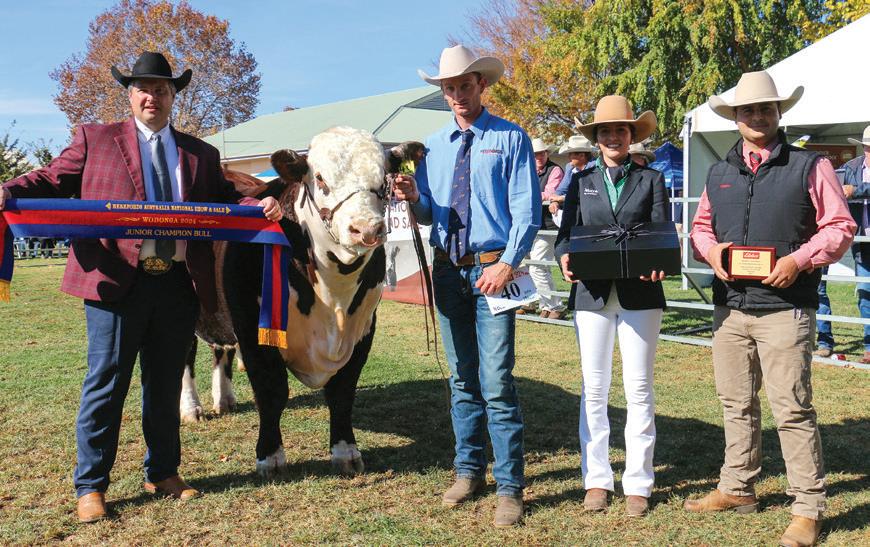
Senior champion, the 27-month-old Mawarra Western Star T060 weighed in at 1012kg, and scanned with an eye muscle area of 147sqcm, rump fat of 23mm, rib fat of 14mm and scrotal circumference of 40cm. Sired by Mawarra Star Attraction and out of Mawarra Minerva 188, the bull ranked
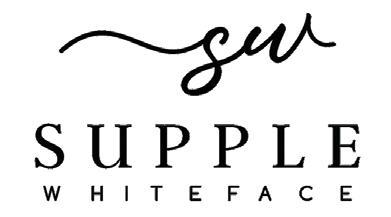
top 3 per cent for 600-day weight at +114kg and carcase weight at +78kg.
Mr Bedwell described Western Star as a “big index bull” with a nice structure, top line, and hind leg quality.
Mawarra Genetics also exhibited the reserve senior champion, Mawarra Las
Vegas T057 and received the Most Successful Exhibitor. The 27-monthold was sired by Mawarra Emperor, weighed 950kg, had an eye muscle area of 138sqcm, and ranked top 1 per cent for intramuscular fat at +2.9 per cent.
Kalara Tik Tik Boom T004 (AI) (ET) (PP), exhibited by Jamie Hollis and Mikayla Passmore, Kalara Poll Herefords, Clifton, Qld, was sashed as reserve junior champion.
The 20-month-old bull was by US sire TH Masterplan 183F and weighed 938kg with an eye muscle area of 137sqcm, rump fat of 22mm, rib fat of 13mm and scrotal of 42cm.
He ranked top 4 per cent for scrotal size, top 5 per cent for 400-day weight, and top 15 per cent for retail beef yield.
“This bull is incredible in terms of presence, style, thickness, and is really athletic in terms of his hip and hind leg, and has the paperwork to back him up,” Mr Bedwell said.
Danny and Debbie Hill, Granite Hill Herefords, Bungendore, NSW, exhibited


the reserve intermediate champion bull, Granite Hill Toro T010 (ET) (PP). Sired by Injemira Robert Redford Q287 and out of Kerlson Pines Annie L1, the 914kg bull had an eye muscle area of 128sqcm, rump fat of 16mm, rib fat 10mm, ranked top 3 per cent for eye muscle area at +7.5sqcm and carcase weight at +79kg. This combined with top 6 per cent for birthweight at +1.0kg.
“Everything fits about this bull, his birthweight, calving ease are on the right side. He is a bull that offers quite a bit in growth - he is a neat bull visually and how he scans, and has a lot of volume and doability,” Mr Bedwell said. He thanked Herefords Australia for the invitation to judge the hallmark event.
“For this legacy in the breed and for what all the breeders have accomplished, this show highlights the testament that you have of making cattle very functional, deep red, heavily pigmented, extra athletic, sound and doing an excellent job of combining a lot of the traits.
“Herefords are in the best place to do both maternal and offer the end product and eating quality necessary for a demanding consumer that has fallen in love with high quality beef. Herefords in my opinion are in a great place to drive this industry forward.”


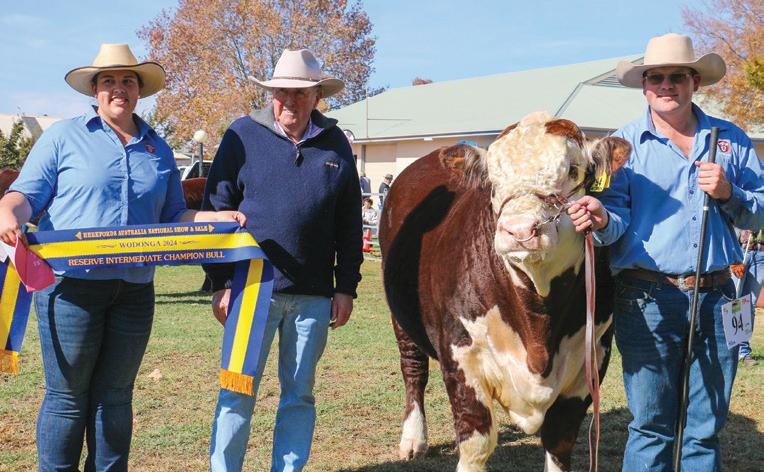
TOP: Senior champion bull Mawarra Western Star T060 (AI) (PP) led by Logan Sykes with judge Shane Bedwell, Craig Brewin, Yarram Park Herefords, and April Huijbregsen, with the Elders Shield of Excellence.
ABOVE: Intermediate champion bull Mawarra Whip Cracker T229 (PP) paraded by Logan Sykes with judge Shane Bedwell, and sashed by Ambrose Kenney, Herefords Australia and Ross Milne, Elders Shield of Excellence.
LEFT: Reserve intermediate champion bull Granite Hill Toro T010 (ET) (PP) led by Kierin Martin with vendor Danny Hill and presented by Brittany Sykes, BJS Livestock Photography.
Carcase quality ticks the boxes for buyers as prices hit $46,000 at Hereford
By Kim Woods
A YOUNG sire who impressed an international judge to win grand champion bull also captured the interest of buyers who bid to a top of $46,000 at the 2024 Herefords Australia National Sale.
Held at the Wodonga Exhibition Centre on May 16, the National sale drew 126 registered buyers from NSW, Victoria, South Australia, Queensland and Tasmania competing on the junior, intermediate and senior bulls from 45 vendors.
Mawarra Whiteout T290 (S) had been judged by American Hereford Association chief operating officer Shane Bedwell as the grand champion bull a day earlier at the Herefords Australia National Show, and was snapped up by Antony Baillieu, Yarram Park Herefords, Willaura, Vic, for $46,000.
A total of 91 bulls sold under the hammer from the 121 offered for a 75 per cent clearance, average of $11,406 and gross of $1,038,000.
In the sale break down, 62 junior bulls topped at $46,000, averaged $12,193 and grossed $756,000 whilst 29 senior bulls topped at $26,000, averaged $9724 for a gross of $282,000.
Offered by Peter and Deanne Sykes, Mawarra Genetics, Longford, Vic, the 21-month-old Mawarra Whiteout T290 weighed 924kg and scanned with an eye muscle area of 136cm. On BREEDPLAN, the bull ranked top 9 per cent for carcase weight at +71kg, top 2 per cent for milk, and top 15 per cent for 400- and 600-day weight.
Yarram Park went on to invest in a bull battery, selecting the senior champion bull Mawarra Western Star T060 (AI) (PP), sired by Mawarra Star Attraction P033, for $26,000 from the Sykes family. Yarram Park also outlaid $24,000 for Ardno Urban U223 (AI) (ET) (PP), a son of Herefords Australia Super Sire Injemira Robert Redford Q287, from first time vendors Kent and Harry Comley, Ardno Herefords, Mount Gambier. Mawarra Wild Bill T707 (AI) (ET) (PP), also from the Mawarra stable, sold to Yarram Park for $16,000.
Yarram Park Herefords manager Craig Brewin said the new sires represented an injection of power into the stud cow herd.
He said BREEDPLAN figures were considered for the end progeny’s programs of grass finishing and feedlot entry weights with large eye muscle areas and high MSA (Meat Standards Australia) grading.


The second top price of $34,000 was paid by Mark and Wendy Campion, Amos Vale Herefords, Pinkett, NSW, for Mawarra Lamborghini T329 (AI) (H), a 21 -monthold son of Mawarra If Only Q264 weighing 918kg, ranking top 9 per cent for intramuscular fat and sold by the Sykes family.
Mr Campion liked the bull’s sire appeal, softness, length, depth, muscle and mobility.
He will join the new sire with selected mature cows and heifers.

He said demand for Hereford genetics in the New England had been maintained and expected it to continue to improve following good general rainfall.
Bernard Hore, Rotherfield Herefords, Bowna, paid $32,000 for Mawarra Walkabout T434 (PP), a 21-month-old son of Mawarrra Showtime P277 and weighing 840kg with a raw eye muscle scan of 127sqcm.
Ben and Kaitlyn Davies, Wild Bear Herefords, Meadows, SA, sold Wild Bear Trademark T019 (H) for $24,000 to commercial Hereford producers Russell and Colleen Foster, Omeo, Vic.
Also paying $24,000 was David and Olwyn Lyons, Melville Park Herefords, Vasey, Vic, for the intermediate reserve champion bull Granite Hill Toro T010 (ET) (PP), an 914kg son of Injemira Robert Redford Q287, from vendors Danny and Debbie Hill, Granite Hill Herefords, Bungendore, NSW.
ABOVE: Mawarra Lamborghini T329 (AI) (H), held by Brandon Sykes, was bought for $34,000 by Mark and Bradyn Campion, Amos Vale Herefords, Pinkett, NSW, with Carl Hooton, Elders Glen Innes. Images: Kim Woods BELOW: The $20,000 Glenholme True Blue (H), held by Cassie Bush, Kirraween/Glenholme Herefords, Cootamundra, NSW, with buyers Carly, Blake, Ross and Mandy Smith, Glenellerslie Herefords, Adelong, NSW.
Mr Lyons was impressed with Toro’s soft skin, muscle, thickness, and carcase data.
Incoming Herefords Australia chairman Marc Greening, Injemira Beef Genetics, Book Book, NSW, outlaid $22,000 for Tarcombe Validated T227 (PP) from vendor, Tim Hayes, Tarcombe Herefords, Ruffy, Vic.
Also outlaying $22,000 for a new sire was Homeleigh Herefords, Firefly, NSW, for Kirraweena Tariq (H) from Geoff and Heather Bush, Kirraweena/Glenholme Herefords, Cootamundra, NSW.
The Bush family also sold Glenholm True Blue (H) for $20,000 to Ross, Mandy, Blake and Carly Smith, Glenellerslie Herefords, Adelong, NSW.
Ross Smith had judged True Blue as champion All Breeds bull at the Harden Show and committed to buying the bull for heifer joinings.
Impressed with a raw eye muscle scan of 137sqcm, Jeff and Robyn Holcombe, Rayleigh Poll Herefords, Narrabri, bought Mawarrra B Trifecta (AI) (ET) (PP) for $20,000 from Brandon and Brittany Sykes, Mawarra B Herefords, Howlong, NSW.
Mawarra Genetics averaged $21,820 for their team of 11 bulls and coprincipal Deanne Sykes said it was rewarding to have the buyer support.
“Most of those purchasers were repeat buyers which is a great testament to our genetic program,” she said.


ABOVE: The $24,000 Ardno Urban U223 (AI) (ET) (PP), held by Sam Garvin, and from left, Yarram Park manager Craig Brewin, cattle manager Mick Petersen, Ross Milne, Elders, Yarram Park principal Antony Baillieu, and vendors Kent and Harry Comley, Ardno Herefords, Mount Gambier, SA.
BELOW: Jack Smythe is on the halter of the $24,000 Granite Hill Toro T010 (ET) (PP), with buyer David Lyons, Melville Park Herefords, Vasey, vendor Danny Hill, Granite Hill Herefords, Bungendore, NSW, and Tim Button, Nutrien Ag Solutions Hamilton, Vic.
“The leadership group at the top of Herefords Australia is strong and there are some exciting plans coming in the strategies they have put in place. It is great to have the collaboration and forward-thinking to inspire people as at the end of the day we are all running businesses and have to be profitable with a sustainable production system.
“Hereford cattle are known for their sustainability and there is more research happening around that – that is the key especially in our grass-fed markets.”
Phil “Bluey” Commins, Nunniong Herefords, Ensay, Vic, paid $20,000 for Ke Warra Camelot T136 (PP), a son
of Wirruna Nolan N146 and offered by Jan Coghill, Ke Warra Herefords, Mornington, Vic.
Llandillo Poll Herefords, The Lagoon, NSW, partnered with Tim and Jemma Reid, JTR Cattle Co, Roslyn, NSW, to select Talumbi Thumper T016 (AI) (ET) (PP), for $20,000 from Caleb Croker, Talumbi Herefords, Yarra, NSW.
Commercial producer Lesley Taylor, Moonan Flat, NSW, bought Glenholme Terry (AI) (H) for $20,000 from the Bush family.
Nutrien South East Stud Stock
Manager Peter Godbolt said the sale equated to value buying in the $6000-
$8000 price range for commercial producers whilst seedstock operators were spending $15,000-$46,000.
Herefords Australia National Show and Sale Committee chairman Alvio Trovatello said the sale result was a good outcome in light of the subdued cattle market and dry seasonal conditions in southern Australia.
“Buyers were chasing cattle with carcase and weight for age while maintaining carcase quality,” Mr Trovatello said.
He said holding the Herefords Australia Breed Forum in conjunction with the National would be considered again to encourage more commercial producers to attend the event. Mr Trovatello said the Wodonga National had long enjoyed a social and networking aspect for stud and commercial producers, and it was important for it to be maintained.
“Our new sale coordinator Charlotte Nugent hit the ground running and it is great to see young people stepping up and taking things on. We had five new vendors this year and we want to see more of that whilst keeping the quality of the bulls in mind.”
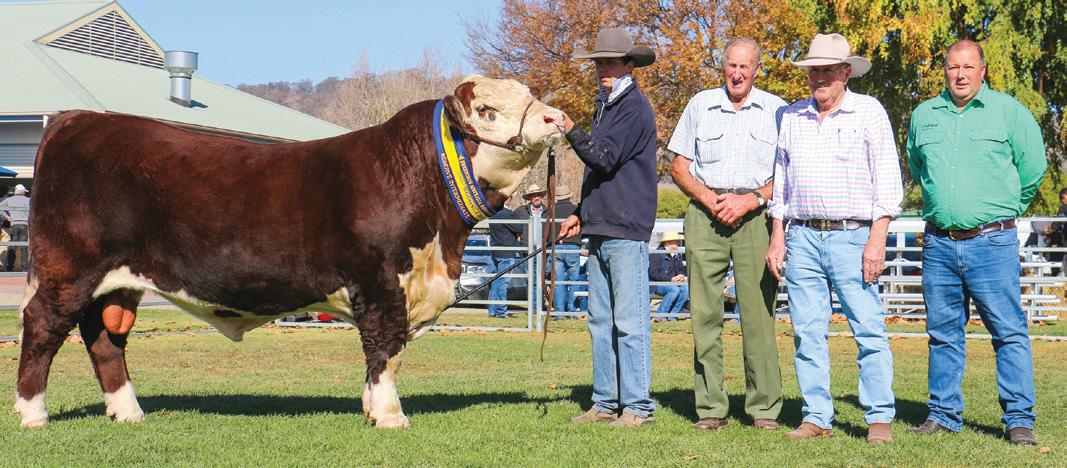
The sale was interfaced with AuctionsPlus whilst duty agents were Elders and Nutrien Ag Solutions.

By Kim Woods
A YEARLING son of the $120,000 bellringer The Ranch Remington R028 followed in his sire’s footsteps to triumph as grand champion bull at the Dubbo Poll Hereford Show.
Born a twin, the 14-month-old The Ranch Gunsmoke U012 (AI) (TW) (PP) impressed judge Steve Crowley, Tycolah Poll Herefords, Barraba, NSW, with his substance, muscle, capacity, bone, hair type and fat cover to win both the junior and grand champion broad ribbons.
Held at the Dubbo showgrounds on June 4, the show drew 24 vendors from NSW, Victoria and Queensland.

and Lucas Pascoe, Dick Smith Transport. Image: Kim Woods
For Tomingley breeders Greg and Del Rees, The Ranch Poll Herefords, Gunsmoke was the first son to be offered in Australia of The Ranch Remington R028, the grand champion and $120,000 top price bull at the 2022 Dubbo National Show and Sale.
Out of the Tilly cow family, Gunsmoke weighed 686kg at 14 months of age, had a 110sqcm eye muscle area, scanned with a fat depth of 15mm on the rib and 9mm on the rump, and had a 38cm scrotal circumference.
His BREEDPLAN figures included +1.3 per cent for IMF, +5.3sqcm for eye muscle area, and +104kg for 600-day weight, +21kg for milk, and +70kg for carcase weight.
Mr and Mrs Rees received the Dick Green Memorial Trophy, sponsored by the Crowley family, and the Evan Davies Memorial Shield.
The Ranch Poll Herefords also scored a double with The Ranch Tilly U010 (AI) (PP) winning junior champion female.
The 14-month-old heifer was sired by Wirruna Qantas Q036 and out of The Ranch Tilly Q016, and boasted BREEDPLAN figures of +2.0 per cent for intramuscular fat, +5.8sqcm for eye muscle area and +20kg for milk.
The 21-month-old heifer Grathlyn Petal T036 (PP) was exhibited by Max Rayner, Grathlyn Poll Herefords, Hargraves, NSW, to senior and grand champion female.
The September 2022 drop female was sired by Wirruna Qureshi Q074 and out of Grathlyn Petal P056. She had BREEDPLAN figures of +105kg for 600-day weight and +68kg carcase weight.
Supple Thimply Thuper (PP0 emerged from a strong showing of intermediate bulls to win the intermediate championship for exhibitors Ben and Leanne Rumbel, Supple Whiteface, Llangothlin, NSW.
Paul and Angela Durkin, Valley View Poll Herefords, Warialda, exhibited Valley View Titanic T011 (PP) to senior champion bull. Sired by Valley View Rubble R003 and out of Valley View Maritana P018, the 24-month-old weighed 934kg, scanned at 14 and 12mm, had a whopping eye muscle area of 141sqcm and a 41cm scrotal circumference.
Allan and Colleen Green, Ivy Bank Partnership, Walcha, NSW, exhibited Ivy Bank Tex T021 (AI) (PP) to reserve champion junior bull. The 20-month-old bull was by US sire Churchill Broadway 858F, weighed 874kg, scanned at 19mm and 10mm, had an eye muscle of 128sqcm, and a scrotal of 41cm.
Grathlyn Pastoral Company exhibited the 21-month-old Grathlyn Trademark T058 (AI) (S) to reserve intermedia champion bull. By the New Zealand sire Koanui Layer P028, the bull weighed 988kg, scanned at 21 and 14mm, had an eye muscle area of 137sqcm and 40cm scrotal.
The 22-month-old Supple TNT (PP), exhibited by Supple Whiteface, was sashed as reserve senior champion bull. Sired by Bowen Quad Q4, the young sire weighed 974kg, scanned at 23 and 14mm, had an eye muscle of 138sqcm and a scrotal of 43cm.
Grathlyn Pastoral also exhibited the reserve junior champion female, Grathlyn Jewess U037 (AI) (PP), a ninemonth-old heifer by Armada Roff and out of Grathlyn Jewess N044.
Her stablemate, Grathlyn Jewess Q009 (PP), a 2019 drop cow by Grathlyn Nomination, was shown with an impressive heifer calf Grathlyn Jewess U001 (AI) (PP) by Okawa King Pin, and sashed as reserve senior champion.
The coveted President’s Shield for a team of three bulls was won by Supple Whiteface, with Ironbark Glen in second and Grathlyn Pastoral Company in third.
The Most Successful Exhibitor was Supple Whiteface.
By Kim Woods
SEEDSTOCK and commercial buyers from four states pushed prices to $28,000 for bulls and $10,000 for females at the Dubbo Poll Hereford Sale.
Held at the Dubbo showground on June 4, the sale was interfaced with AuctionsPlus and drew 50 registered buyers from NSW, Victoria, Queensland and Tasmania.
In the live lots, 53 bulls were offered with 36 sold to a top of $28,000, gross of $302,000 and average of $8388.
In the females, six sold from the 10 offered to a top of $10,000, gross of $37,500 and average of $6250.
Nutrien Warrnambool bid on AuctionsPlus on behalf of an undisclosed buyer to secure the top price bull at $28,000, the senior champion Valley View Titanic T011 (PP), offered by Paul and Angela Durkin, Valley View Poll Herefords, Warialda, NSW.
Sired by Valley View Rubble R003 and out of Valley View Maritana P018, the 24-month-old weighed 934kg, scanned at 14 and 12mm, had a whopping eye muscle area of 141sqcm and a 41cm scrotal circumference.
Stephen and Jodi Peake, Bowen Pastoral Company, Gunnedah, NSW, were in the sale barn to outlay the second
top price of $25,000 on yearling bull The Ranch Gunsmoke U012 in partnership with David and Olwyn Lyons, Melville Park Poll Herefords, Vasey, Vic.
Earlier judged as grand champion bull, Gunsmoke was the first son of the $120,000 The Ranch Remington R028 to be offered by vendors Greg and Del Rees, The Ranch Poll Herefords, Tomingley, NSW.
Mr Peake had seen the bull in the catalogue before the sale and had purchased his sire The Ranch Remington R028 in 2022.
Robert Hain, Gunyah Herefords, Cooma, NSW, bid over the phone to buy reserve senior champion bull Supple TNT (PP) for $18,000 from Ben and Leanne Rumbel, Supple Whiteface, Llangothlin, NSW.
Intermediate champion bull Supple Thimply Thuper (PP) was sold by Supple Whiteface for $14,000 to Ian and Shelley Durkin, Mountain Valley Poll Herefords, Coolatai, NSW, and Gary Clarke, Shangri-La Poll Herefords, Hagley, Tasmania. Supple Whiteface also sold the Yalgoo Video M195 son Supple Touchdown (PP) for $14,000 to Thalabar Pastoral Company, Laggan, NSW.
CONTINUED ON PAGE 50





The reserve intermediate champion Grathyln Trademark T058 (AI) (S) was sold by Grathlyn Pastoral Company, Hargraves, NSW, for $12,000 to Evesham Ag, Narrabri, NSW.

Repeat buyers Pat and Kerrie Bredhauer, Lambert Pastoral Company, Charleville, Qld, outlaid $10,000 for yearling bull Callaway R075 Uno U007 (PP) from Mark and Nikita Duthie, Callaway Poll Herefords, Irvingdale, Qld.
Good recent rainfall buoyed livestock and grain producers Rob and Nicole Logg, Bellarwi Pastoral Company, Barmedman, NSW, to pay $11,000 for JTR Texas T043 (AI) (PP) from Tim and Jemma Reid, JTR Cattle Company, Roslyn, NSW.
Mr and Mrs Logg have bought bulls in the past at Dubbo and consider it a good place for commercial producers to buy.
“We liked the bull for his above average figures, particularly for rib and rump fat, as we keep some females, and good scrotal circumference for fertility to improve our herd,” Mr Logg said.
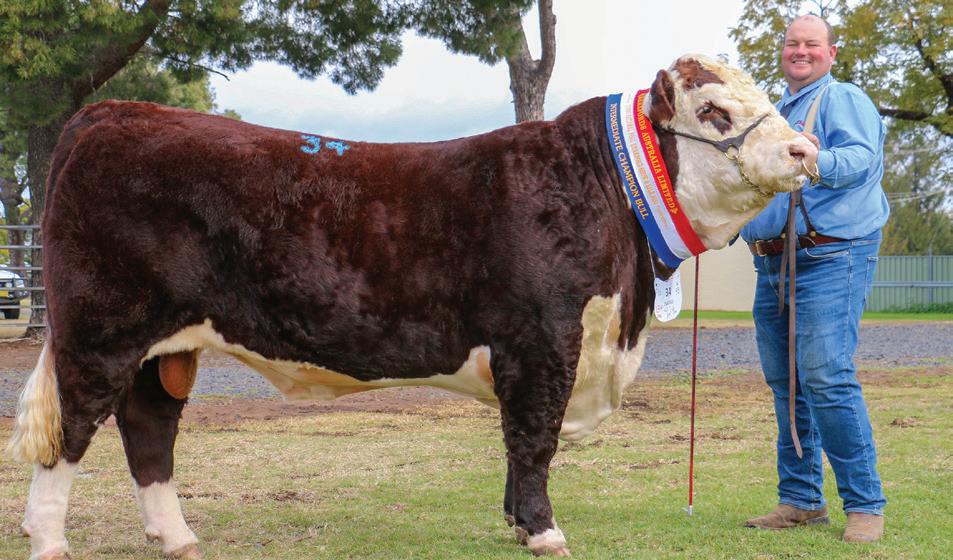

By Kim Woods
AN influx of northern buyers combined with southern NSW and Victorian support pushed prices to 362c/kg for autumn drop steers in the opening Hereford fixture for January.
Selling agents Corcoran Parker, Rodwells Peter Ruaro, Brian Unthank Rural, and Schubert Boers yarded 3085 cattle for the Premier Hereford, Hereford cross and Euro Grown and Weaner Sale on January 4 at NVLX Wodonga.
Grossing $3.018 million, the sale resulted in an overall average of $1055 or 296c/kg for steers and 253c/kg or $862 for heifers.
The sale opened on the heavy grown Hereford steers which sold for $850-$1310 or 242-306c/kg while the black baldy pens finished at $1120-$1500 or 275-318c/kg.

The couple turns off steers and heifers at 12 months of age, and look for good early growth rates, milk and positive fat.
“We like the Hereford doability, fertility, temperament and longevity – we will stick with them. If you want to improve your herd you’ve got to be willing to spend a bit more,” Mr Logg said.
Nutrien Ag Solutions NSW stud stock manager John Settree said commercial buyers were active in the bulls priced from $6000-$11,000, and were selective on phenotype and BREEDPLAN data.
Mr Settree said the females presented well with new genetics and added another dimension to the event.
Dubbo Poll Hereford Show and Sale committee chairman Ben Rumbel said the sale represented good value buying for stud and commercial producers.
Incoming sale committee chair is Mark Duthie with Nikita Duthie as sale co-ordinator.
Selling agents were Nutrien Ag Solutions and Elders.
With the focus squarely on the autumn drop weaners, the purebred calves over 350kg made $940-$1285 or 249362c/kg, while those weighing 280-350kg finished at $870$1075 or 271-318c/kg and the lighter weights under 280kg settling at $630-$855 or 252-319c/kg.
Topping the Hereford autumn drop weaner run was M & J McNamara, Nariel Valley, with a pen of 23, aged 9-10 months, Newcomen blood, and weighing 355kg.
The pen was snapped up by steer finisher David Braniff, Corryong, for $1285 or 362c/kg.
“We have had these cattle before, and they perform well. We are grass fed assurance finishing to above 750kg liveweight to major processors,” Mr Braniff said.
“We have turned off the calves we bought last year, and they averaged 400kg carcase weight off pasture, hay and silage.”
Mr Braniff said the Hereford steers were reliable with a durability aspect and finished well.
He said having the cattle weaned beforehand was critical.
In the black baldy steer weaners, those over 350kg sold for $1050-$1240 or 290-311ckg, and the middle run of 280350kg made $910-$1070 or 302-342c/kg.
In the heifers, those grown females over 350kg made $750-$1100 or 206-258c/kg and the lighter heifers under 350kg sold for $500-$860 or 170-251c/kg.
The black baldy heifers over 350kg made $890-$985 or 256-276c/kg and those under 350kg $450-$890 or 174270c/kg.
Buyers operating included Corcoran Parker, Jeff Cooper Agencies, Corryong, Brian Unthank Rural, PRL, Costello Rural, Corryong, AWN Inverell, Rodwells Euroa, North East Livestock, Elders Shepparton, Allied Beef, and commission buyers Graham Ward and Andrew Lowe.
Cookardinia producer David Trethowan made it a hattrick of wins in the Herefords Australia champion pen under judge and Indigo Valley steer finisher Bryan Proctor.
Mr Proctor described the yard weaned steers as exhibiting evenness, length, good eye pigment and supple skin.
The pen of 50 Wentworth blood steers averaged 382kg and sold for $1205 or 315c/kg to Allied Beef.
Mr Trethowan offered 103 Hereford and black baldy steers, and had anticipated prices of 310-320c/kg.
He retained 160 heifers and uses a nucleus of ex-stud cows joined to AI sires, including Cootharaba Magnum, to produce herd bulls.
“The sires are selected on 600-day weight as a lot of the calves go to grass fatteners,” Mr Trethowan said.
John and Jane Witherow, Murmungee, sold a run of Yavenvale blood steers, March/April drop, with the tops weighing 366kg making $1060 or 287c/kg and the seconds weighing 317kg making $940 or 299c/kg to Upper Murray steer finishers.
The couple offered 90 steers (270-366kg) and heifers (249-285kg) after a challenging year of growing conditions where the cattle were fed silage after weaning.
David Hocking, Mullengandra, uses Hereford bulls over quality Angus cows to produce black baldies, and topped the sale overall with his Rotherfield blood steers, aged 14-15 months, weighing 518kg, and returning $1500 or 289c/kg.
The second run of the 9-10 month-old black baldy steers made $1220 while the black baldy heifers, nine to 10 months and 356kg, made $985.
“We achieve an extra 80kg in our crossbreds using Hereford over Angus.” Mr Hocking said
G. Hiskins, Howlong, topped the Hereford heifers with a pen of 17 yearlings aged 12-14 months and weighing 433kg, making $1100 or 254c/kg.

By Kim Woods
THE message was loud and clear for heavy Hereford cattle for short term trading in grass fed markets as buyers jockeyed at the rail on the final day of the week-long January weaner sales at Wodonga.
Selling agents Elders and Paull & Scollard Nutrien Ag Solutions yarded 2555 cattle for the NVLX Premier Hereford, Hereford Cross and Euro Grown and Feature Weaner Sale on January 5.
Grossing $2.48 million, the sale resulted in an overall average of $1047 or 281c/kg for steers and $846 or 258c/kg for heifers.
The sale opened on the heavy grown Hereford steers over 350kg liveweight and fetching $980-$1480 or 283306c/kg. A small number of heavy black baldy steers made $1085-$1320 or 238-297c/kg.
The autumn drop Hereford steers weighing over 350kg finished at $1054-$1100 or 268-305c/kg, while those weighing 280-350kg sold for $755-$1065 or 263-316c/kg. The lighter weight pens under 280kg settled at $650-$830 or 267-322c/kg.
Black baldy steers over 350kg averaged $965 or 268c/kg and those under 350kg made $750-$930 or 295304c/kg.
Heavy Hereford heifers over 350kg made $910-$1040 or 246-279c/kg and the lighter weights under 350kg finished the day at $480-$840 or 212280c/kg. Black baldy heifers under 350kg sold for $715-$920 or 256292c/kg.
Grafton based commission buyer David Gillett judged the Herefords Australia champion pen of steers, awarding the sash to the Sleigh family, Jerilderie, for a pen of 22 Bayunga bred, Wirruna and Glentrevor blood steers weighing 360kg.
They were purchased by Phil Gledhill, Elders Holbrook, for $1100 or 305c/ kg – the top price for the Hereford autumn drop steer weaners. Richard Smith, Tocumwal, topped the Hereford

weaner heifers with his pen weighing 363kg and returning $940 or 258c/kg.
David Gillett said the even line of Sleigh steers exhibited outstanding length and growth for age.
He sources Hereford cattle for backgrounders, lot feeders and processors and attended the Wodonga sale for the first time to buy feeder bullocks, feeder heifers, and backgrounder steers and heifers for Queensland.
“For our feeder bullocks, it is generally 400-500kg, the heifers are 350-400kg and the backgrounders 280-350kg. Prices here were to my expectations with bullocks around 300c/kg, feeder heifers 250-270c/kg, backgrounder steers 290-320c/kg and heifers 250-260c/kg,” Mr Gillett said.
To make a pen more appealing to buyers, Mr Gillett said vendors should ensure health treatments are up to date and the cattle are fully weaned.
He expected to send 700-1000 cattle north from the sales at an average of 300c/kg for weaner steers.
One of the local buyers putting a floor in the market was Justin Costello, Costello Rural, Corryong, operating on grown steers for Upper Murray clients finishing cattle for grass fed programs.

“We have been looking for heavy Hereford bullocks and are very happy with the quality and presentation of the Herefords this year. Our clients are looking for good growth in yearlings of 14 to 16 months of age,” Mr Costello said.
“We are sourcing the heavier end of the steers at over 380kg up to 500kg to turn into a bullock at a price point of up to $1500.”
Elders Albury livestock manager Brett Shea quoted solid competition from lot feeders and bullock fatteners sourcing 500kg plus cattle for short term trading in an anticipated dearer prime market in 2024.
“Arguably the weaner run was the best 24 pens of Hereford calves seen in the state at any time of the year, have all made between 300-330c/kg,” Mr Shea said.
“Those cattle were soaked up by local northeast agents being Holbrook, Wangaratta, Corryong and also northern competition in Inverell and crossing the border to Toowoomba.
“They were all vendor bred, grass assured, a few were EU, all are weaned, they are clean in the eyes and were a credit to the vendors. They go on to hit those heavy grass-fed specifications in this northeast Victorian country.”

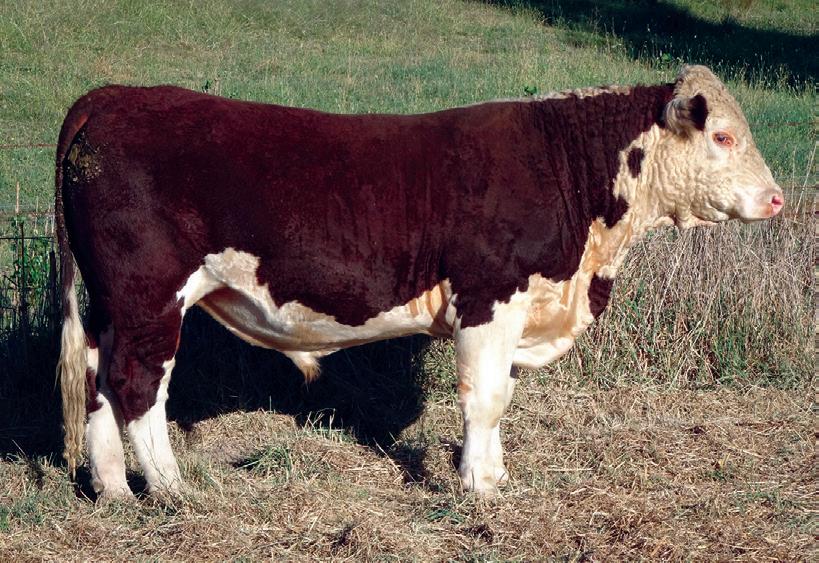
$14,000 to Ralph Burgess, Rosehill, Lyndhurst
$9,000 to Ms Pat Woods, Hobbys Yards

By Kim Woods
GRASS finishers figured prominently as the buyers of the Hereford run paying to a top of $1328 for the lead steers at the Hamilton All Breeds Weaner Sale.
Selling agents Elders, Nutrien Ag Solutions, Brian O’Halloran & Co and J & J Kelly yarded 3349 Hereford, Hereford cross, Angus and Euro steer weaners in the January 9 fixture, the opening salvo for the Hereford breed in the Western Districts sales circuit.
Grossing $3.7 million, the sale resulted in steers averaging 326c/kg or $1106. In the breed breakdown, 586 Hereford steers sold to a top of 336c/kg or $1328 per head, and average of 317c/kg or $1016 to gross $595,723. Black baldy steers topped at 322c/kg or $1184 and averaged 309c/kg or $1036.
The lead pens of the autumn drop Hereford weaners weighing 350kg plus sold for $1140-$1328 or 314-336c/kg. Steers weighing 280-350kg liveweight made $922-$1040 or 310-328c/kg while those under 280kg finished at $805$840 or 304-312c/kg.
Former steer finisher and now Hereford breeder Tim Hutton, Nigretta Partnership, Hamilton, judged the Herefords Australia champion pen, awarding the sash to the opening pen of March/April 2023 drop steers from vendors John and Liz Craig, “Inverell”, Casterton and Hamilton.
The steers had been yard weaned in November, weighed 405kg, were Yarram Park and Glendan Park blood, European Union and Greenham Never Ever accredited, and Pasturefed eligible.
They were bought for the top price of $1328 or 328c/ kg by commission buyer Andrew Lowe on behalf of repeat buyer and steer finisher Paul Mason, Wellington. Mr Mason also bought the second draft of 60 head weighing 365kg for $1226 or 336c/kg, the top on a cents per kilogram basis for the purebred calves.

the
for
South Australian lot feeders and backgrounders competed with their northern counterparts for quality weaned and accredited Hereford steers, lifting prices to 350c/kg and $1320 at Hamilton’s second sale.
Selling agents JM Ellis & Co, LMB Livestock & Land, Lanyons Stock & Station Agents, Kerr & Co, Southern Grampians Livestock, J & J Kelly and Brian O’Halloran & Co yarded 2259 Hereford, Hereford cross and Euro steers and heifers for the Hereford and Euro Feature Weaner Sale on January 10.
Overall, the sale grossed $2.41 million and averaged 325c/ kg or $1070 while weaner steers averaged 328c/kg or $1109.
The big runs of quality autumn drop Hereford steers saw prices jump considerably on the morning’s Casterton sale with those over 350kg liveweight selling for $1092-$1320 or 312-338c/kg. The European Union accredited pens traded at the same rates.

The steers weighing 280-350kg finished at $923$1168 or 300-334c/kg and the EU pens sold for $923$1168 or 312-332c/kg.
The lighter weight cattle under 280kg settled at $644-$945 or 316-350c/kg and the EU pens made $846-$945 or 316-350c/kg.
Commission buyer Andrew Lowe, Wagga Wagga, judged the Herefords Australia champion pen, selecting 25 European Union accredited, February/March drop steers, Yarram Park and Mawarra blood, from Leon Wheeler, Wallacedale.
Liz and John Craig, “Inverell”, Hamilton and Casterton, received the Herefords Australia champion pen for their 406kg, March/April drop, steers, Yarram Park and Glendan Park blood, bought by Paul Mason, Wellington, for $1328 or 328c/kg.
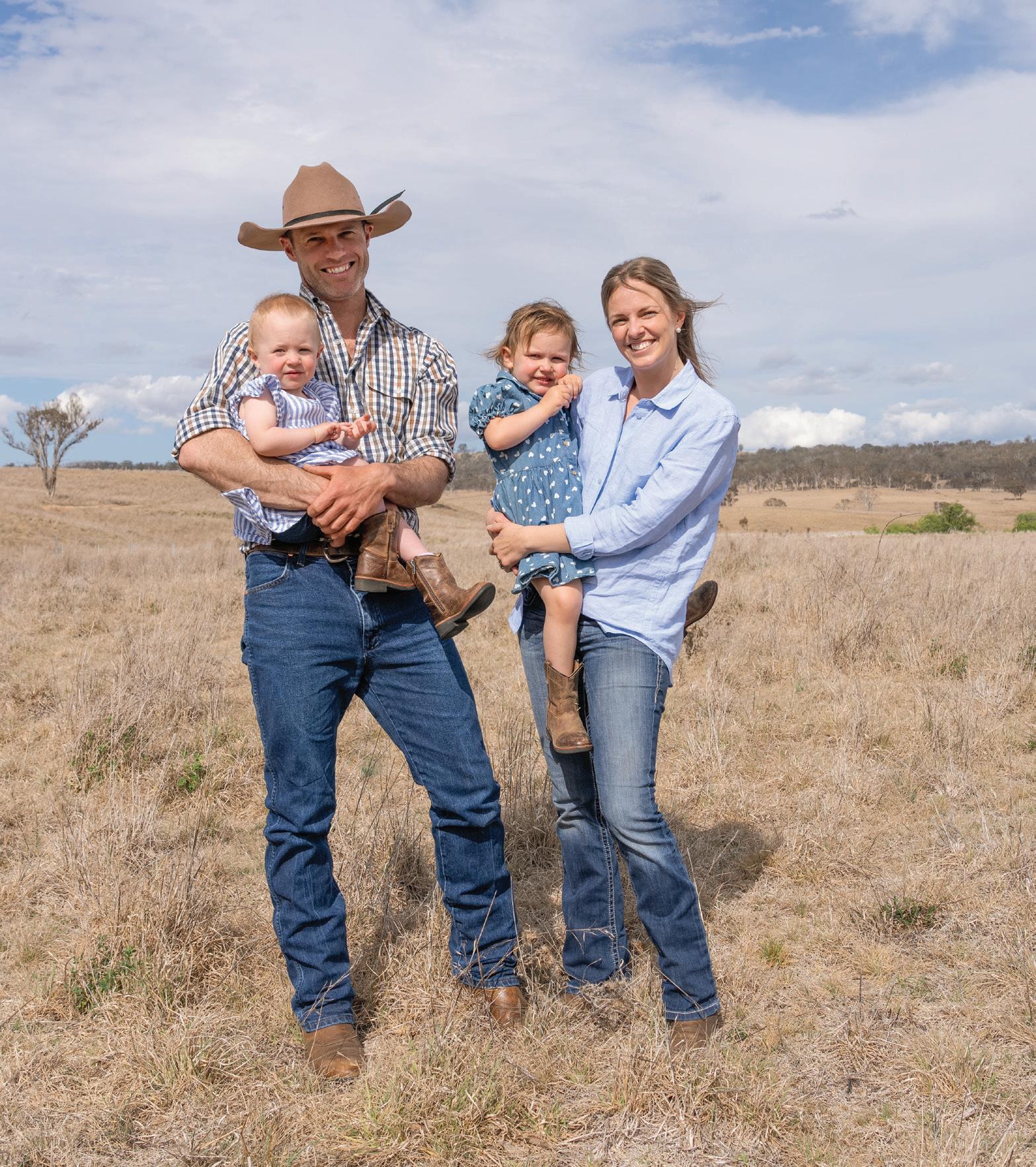
Farming is more than just a job, it’s a way of life. Our team of specialists are passionate about supporting farmers to grow their business.


By Kim Woods
A LOT feeder and grass finisher went head-to-head in the Western District sales at Casterton buying 40 per cent of the total yarding, pushing prices to $1270 for autumn drop Hereford steers.
Selling agents Elders and Nutrien Ag Solutions yarded 1093 Hereford, Hereford infused and Euro steers for the Casterton Hereford and Euro Steer Weaner Sale on January 10.
The sale averaged 311c/kg for steers weighing an average of 318kg.
Active buyers included Princess Royal Station, Burra, Miller Whan & John, Mt Gambier, TDC Livestock Penola, Nutrien Bendigo, Nutrien Kerang, Nutrien Deniliquin, Nutrien Cohuna, Southern Grampians Livestock, O’Connor & Graney, Midfield Group, Elders Ararat, Creek Livestock, Injemira Beef Genetics and Willinga Pastoral, Qld.
In the pens weighing over 350kg liveweight, prices finished at $1033-$1270 or 294-326c/kg and the European Union accredited pens made $1115-$1250 or 308-326c/kg.
Hereford steers weighing 280-350kg returned $781-$1087 or 284-322c/kg while the EU pens made $887-$1087 or 292-316c/kg. The lighter weight steers under 280kg settled at $530-$897 or 260-330c/kg and the EU pens made $530$887 or 284-330c/kg.
The Hereford infused pens sold for $921-$1283 or 300310c/kg.
Marc Greening purchased 233 head, including 135 averaging 346kg for Injemira Beef Genetics, for a total average weight of 277kg and average price of $880.
“The cattle I bought for myself will go into our normal grass finishing programs for Coles Graze. They will firstly go onto pasture and graze early cereal crops in the winter and finish on pasture.”
Mr Greening paid 460c/kg for Injemira blood steers and 440c/kg for non-Injemira blood steers at the 2023 Casterton fixture, finishing them on grass for either Woolworths or Coles Graze in the past 12 months.
“There is upside now and the strength is the EU market with processors telling me to concentrate on buying EU cattle to give another marketing option out the other end. I’m buying EU cattle that will either fit Coles or go into the EU market.
“A big thing for the Hereford breed is the EU market – my overseas contacts tell me it will be strong and that is good for the breed and the vendors who have stuck with their EU accreditation.”
Greg Farquharson, Bushy Park Angus, Dergholm, judged the Herefords Australia champion pen, selecting a pen of 25 Injemira blood March/April drop steers weighing 396kg presented by Cam and Carolyn Emerson, Alva Downs, Tahara.
Princess Royal bought the pen for $1251 or 316c/kg.
The McDonald family, “Sunningdale”, sold the top price Hereford pen of 13, March/April drop, Banemore blood, weighing 402kg, and returning $1270 or 316c/kg.
Jeoff and Jill Hortle, “Woranga”, topped the sale on a cents per kilogram basis at 330c/kg for calves weighing 238kg and selling to Elders Ararat.
The top price Hereford infused pen was Hereford/South Devon cross, 414kg, sold by the Kerr family, “Glenaulin”, for $1283 or 310c/kg.


Introducing the next big thing from New Zealand:
One of the most exciting bulls bred by Koanui
• Impeccable structure and feet
• Genetic appeal and soft skin
• Sire and Dam at the very top end
• Data set that ticks all the boxes


@ koanuiherefords.co.nz www.koanuiherefords.co.nz
Limited offer!
10 semen packages available until September 2025.
50 straws for $5,000 per package for in herd use, available from Agri-Gene.
Koanui Amethyst Q100 (Lips’ Dam)
Probably the best uddered beef cow you will find with a list of high-performing progeny.
• 2-year: Best 2-year-old’s calf of the year 2021
• 3-year calf: Lips, best of 2022
• 4-year calf: Best heifer calf of 2023
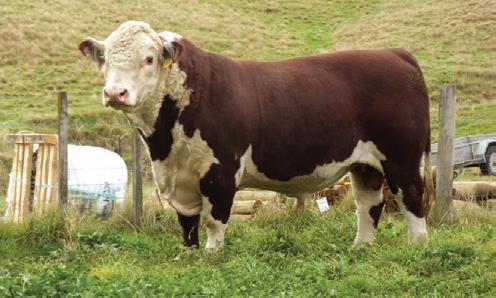
Koanui Layer P028

By Kim Woods
RESTOCKERS and backgrounders from South Australia, Queensland, NSW and Victoria jockeyed with feeders for quality weaner heifers with European Union accreditation at Casterton.
Selling agents Elders and Nutrien Ag Solutions
Casterton yarded 1856 Hereford, Hereford infused and Angus cattle for the Casterton Heifer Weaner Sale on January 12.
The yarding had an average weight of 299kg and average price of 299c/kg.
The autumn drop Hereford heifers weighing 280350kg sold for $812-$998 or 280-332c/kg while the EU accredited pens made $843-$998 or 288-332c/kg. The purebreds weighing under 280kg made $575-$985 or 250-310c/kg.
In the black baldies, the heifers weighing over 350kg finished at $1055-$1154 or 310-318c/kg and those under 350kg settled at $928-$1072 or 308-328c/kg.
Topping the purebred pens on a dollars per head and cents per kilogram basis was “Glencairn”, Chetwynd, with a pen of Injemira and Yarram Park blood heifers weighing 310kg. They were bought by Marc Greening, Injemira Beef Genetics, Book Book, NSW, for $998 or 332c/ kg.

Mr Greening was sourcing heifers for his joined female program, Injemira Advantage. He also continued a buying spree on behalf of newcomers to the Western District sales circuit, Willinga Pastoral, picking up 74 heifers for their broad scale aggregation at Wandoan, Queensland.
The 41 heifers averaging 284kg purchased by Injemira will be marketed as PTIC lots at Injemira’s annual bull sale in February. They will be naturally joined over eight weeks to low birthweight paternal brothers of Australian recordbreaking sire Injemira Redford Q287.
“We do a slightly different job for that heavier weight heifer than we do for the steers and the lighter heifers,” Mr Greening said.
“I’m pretty selective on the heavier EU accredited heifers for the heifer program where they will be joined as future breeders and sold back through our bull sale on the point of calving.
“We have used proven calving ease Injemira Redford sires over the last few years. The feedback has been good from clients buying heifers and calving them out.”
Last year Mr Greening paid to a top of $2098 for heifer weaners at the Western District sales and will offer those as PTIC females.
“We have had groups of heifers average well over $3000 in large drafts of 300-400 head. Last year was back in the high $2000s but it is part of the diversification of our business
model in terms not relying solely on finishing steers for grass and cash flow at different times of the year. Buying these quality Injemira blood heifers means we can stand behind the product.”
“Carinya” sold the top priced black baldies – a pen of nine March-April drop weighing 363kg, EU accredited and returning $1154 or 318c/kg. Jack and Mark Storer, Kleenview Pastoral, Hotspur, topped the black baldies on a cents per kilogram basis with December/January drop calves, 333kg, and making 322c/kg or $1072.
Greg Farquharson, Bushy Park Angus, Dergholm, judged the Herefords Australia champion pen, selecting 28 EU accredited heifers, Mawarra, Bowen, Kidman, Warwick Court and Guilford blood, from David and Olwyn Lyons, Melville Park Herefords, Vasey. Mr Farquharson liked the heifers’ shape, eye pigment, and accreditation with the pen selling for $843 or 288c/kg to Miller Whan & John, Mt Gambier.
David Lyons sold 38 heifers and retained 80 heifers, classing them on size, conformation and doing ability.
Bill and Kathy Lambert, Taronga, Paschendale, averaged 300c/kg or $819 for their draft of 44 heifers weighing an average of 270kg and have tracked their market trend over the years.
The top pen of Taronga heifers sold for $904 or 315c/kg as backgrounders for a lotfeeder.
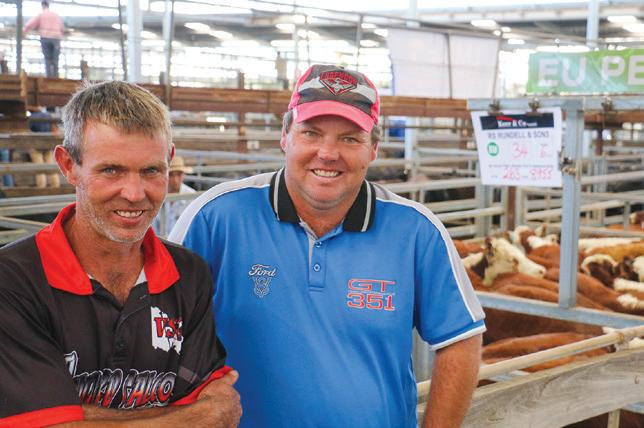
Robin and Sam Rundell, RS Rundell & Sons, Condah, sold their top pen of Yarram Park, Glendan Park and Oak Downs blood heifers for $899 or 310c/kg. All images Kim Woods

David,
and

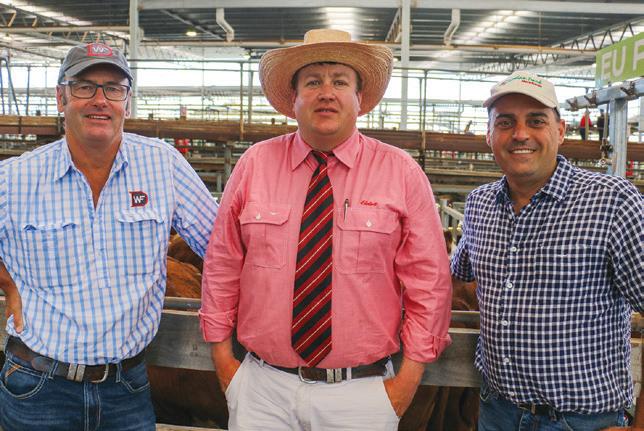


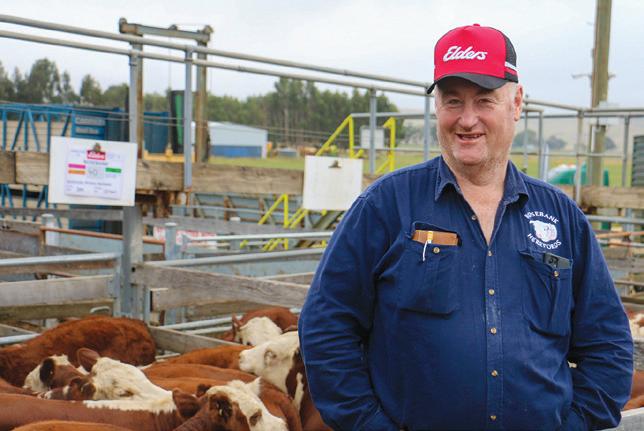


By Kim Woods
IN a repeat of last year, two industry heavyweights went toe to toe on the lead run of the Hereford heifers at Hamilton with prices peaking at $970 for the autumn drop pens.
Selling agents Elders, Nutrien Ag Solutions, J & J Kelly and Brian O’Halloran & Co yarded 1555 Hereford, Angus, and Euro heifer weaners for the All Breeds Weaner Heifer Sale on January 11.
Overall, the sale grossed $1.4 million with the heifers averaging 301c/kg or $900.
In the purebred heifers, a single pen over 300kg made $935 or 296c/ kg while those weighing under 300kg sold for $585-$970 or 250-330c/kg. The Hereford/Shorthorn heifers made $607-$772 or 246-274c/kg and black baldies $768-$1058 or 275-314c/kg.
A bidding duel for the champion pen between Injemira Beef Genetics and Yarram Park Herefords was the high point, resulting in the Hereford offering’s top price of $970 or 330c/kg.
Commission buyer Andrew Lowe judged the Herefords Australia champion pen, awarding the ribbon to Gordon, Jane and Owen McClure, Beerik Partnership, Coleraine.
The pen of 31 March/April drop heifers, weighing 294kg, were Yarram Park, Injemira and Melville Park blood, EU accredited, Greenhams Never Ever, Pasturefed eligible, antibiotic free and yard weaned.
Antony Baillieu, Yarram Park Herefords, was keen to secure the pen, included in a total of 141 heifers for the company’s Western Districts Pastoral operation of 3000 breeders in South Australia
On the second day of heifers at Hamilton, restockers were flushed out of the woodwork to bid for known quality and performance genetics, pushing prices to 350c/kg for Hereford heifers and finalising the 2023 Western Districts weaner sales circuit on a positive note.
Selling agents JM Ellis & Co, LMB Livestock and Land, Lanyons Stock and Station, Kerri & Co, Southern Grampians Livestock, and J & J Kelly yarded 2219 Hereford, Angus, black baldy and Hereford infused heifer weaners for the British Bred Heifer Weaner Sale on January 12.
Grossing $2.17 million, the sale resulted in an overall average price of 325c/kg, and top price of 386c/kg.
The Hereford yarding featured no heifers over 350kg but those weighing 280-350kg sold for $701-$1067 or 284-322c/kg with half of the lots being EU accredited. In the purebred pens

or 318c/kg.
weighing under 280kg, prices finished at $395-$952 or 230-350c/kg, the top purebred price for the week’s sales circuit in the lighter end of the heifers.
In the Hereford infused pens, the Hereford/Simmental heifers over 350kg sold for $1122 or 318c/kg, and those under 350kg made $821$1164 or 308-316c/kg. Black baldy heifers over 350c/kg averaged $1060 or 302c/kg and those under 350kg settled at $524-$1058 or 225-326c/kg.
Adding an air of excitement to the Hereford run, the bidding was fast and furious from the opening pen offered by the Malseed family, Orana, with Yarram Park manager Craig Brewin snapping up in a bid of 318c/kg the run of 59 Orana calves over three yards for their Western Districts Pastoral commercial herd in South Australia.

YAVENVALE ROMEO R055 // Ident: YAVR055
Sire Stack: NJW 792 2311 EDURE 173D X PINEHILL DERBY D578

Marc Greening, Injemira Beef Genetics, kicked into gear on the Koolomurt heifers offered by vendor John Wyld, with a bid of 350c/kg, the top cents per kilogram for the Hereford yarding.
Gordon, Jane and Owen McClure, Beerik Partnership, received the Herefords Australia champion pen for their
ROMEO R055 has tremendous length, softness and shape with a deep red coat and abundant pigmentation. He combines a set of EBV’s that are hard to match for calving ease, carcase traits and marbling; with fat cover and $indexes at the top end of the breed.


TURBO was the top priced bull from the 2023 Gippsland Performance





By Kim Woods
VICTORIAN and NSW steer finishers, restockers and lot feeders converged on the Victorian High Country in March to bid for whiteface cattle at the 84th annual Mountain Calf Sales circuit opener.
Selling agents Nutrien East Gippsland Livestock yarded 900 yearling and weaner Hereford, Hereford cross, Angus and Euro steers and heifers for the March 5 fixture at the Hinnomunjie yards.
Heavy yearling Hereford and Hereford/Shorthorn steers, spring drop 2022 and over 400kg liveweight, sold for $1620-$2000. They were displayed with green weights and their curfewed price per kilogram was 330-357c/kg.
The run of autumn drop Hereford steers over 350kg topped at $1500 and sold down to $1160 while the lighter pens under 350kg returned $810-$1250.
Black Baldy steers over 400kg returned $1630-$1920 and were also displayed with green weights to five a curfewed price of 328-352c/kg. The autumn drop black baldy steers under 350kg sold for $740-$1010.
In the heifer pens, spring drop 2022 Hereford/Shorthorn and black baldy females over 350kg sold for $1280-$1400 and were displayed with green weights to give a curfewed price of 270-304c/kg. The autumn drop Hereford heifers returned $640-$1110 while the black baldy heifers made $600-$970.
Gippsland steer finisher Graham Osborne judged the Herefords Australia champion pen, awarding the sash to Peter Soutter, Benambra, for 18 Karoonda and Nunniong blood autumn drop steers, Greenhams Never Ever accredited and antibiotic free.

With their health treatments also displayed for buyers, the steers were snapped up by Mr Osborne for $1440.
“We like to see antibiotic free, grass-fed and vendor bred – that is part of the reason we come here for the genuine producer-bred cattle,” he said.
The sale opened on the heavy spring drop 2022 Hereford and Hereford/Shorthorn, Karoonda and Yarram Park blood, steers sold by Donald Betts, Bairnsdale. Donald was the only vendor to display weights (seven hour curfew) and the 637kg steers were bought by Jamie Quinlan, Elders Yea, for $2000 or 330c/kg.
Topping the autumn drop Hereford steers was Gus and Sandra Crisp, Omeo, with a pen of 27 Mawarra and Newcomen blood, selling to Graham Osborne for $1500. Mr Osborne also paid $1480 for the seconds.
A & K Farms topped the autumn drop Hereford heifers with a pen selling for $1110 to Everitt Seely & Bennetts.
Our commitment to market savvy selection will ensure our bulls give clients market premiums
t More calves to sell... our years of selection for CE daughters and CE direct ensure more live calves
t Better growth at early ages... selection emphasis on 400 day wt. gives more weight to sell and better ossification for top MSA indexes
t Better market compliance... from balanced selection for growth, fat, muscle and IMF to suit processor grids
t Outstanding EMA’s... selected to achieve better yields and dressing percentages for increased returns without compromising CE
t More IMF... to enhance eating quality for consumers, achieve higher MSA indexes and better Feedlot acceptance
Our sale bulls regularly rate in the top 5% for CE, 400 day growth, EMA, IMF, Yield and $Indexes
All bulls poll tested, sire verified and free from genetic diseases
Sale

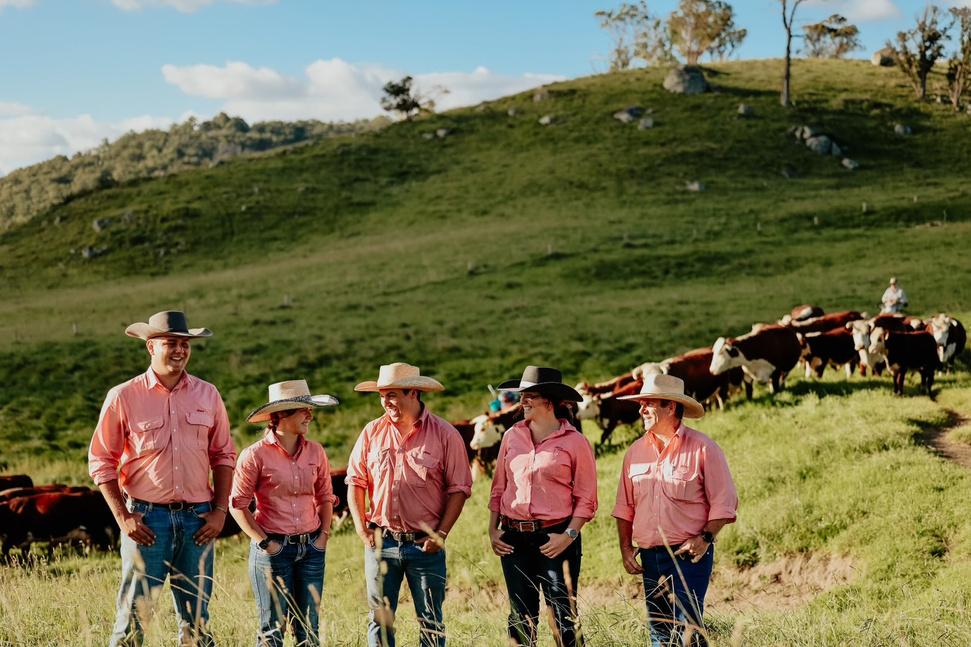
The Elders Glen Innes team are your local agribusiness specialists,and are well equipped to assist your operation for this season and the next. Branch Manager Carl Hooton and his talented local team are supported locally by Attenborough Fertiliser and the statewide Elders NSW network.


Carl Hooton - 0417446017
Nash Tome - 0447858693
Chasten Kaiser - 0459955949 Michael Lamph - 0427502825 Ben Lockwood - 0421755113
Tara Murray - 0408831759


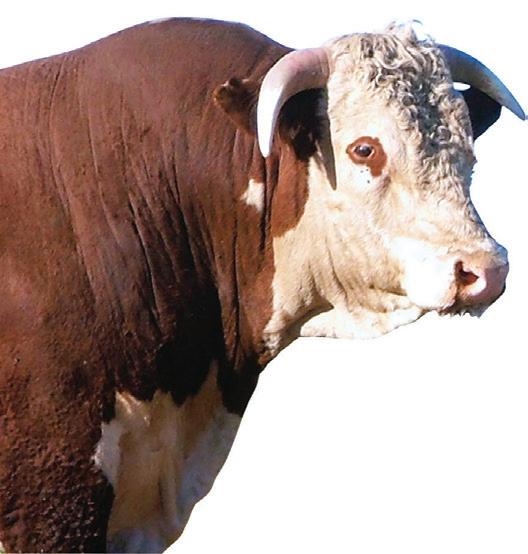





By Kim Woods
PRICES sizzled on the top end of autumn drop Hereford steers to $1760 as steer finishers jockeyed for the cattle on offer at the Benambra Weaner Sale.
A big crowd of buyers and vendors descended on the Benambra yards for the opening Elders whiteface fixture of the 84th annual Mountain Calf Sales on March 5.
The selling agents Elders Bairnsdale penned 1666 Hereford, Hereford cross and Euro steers and heifers for the fixture to average $1002 and gross $1,669,681. A total of 1012 steers sold for an average of $1171 and 654 heifers averaged $740.
Buyers and visitors were greeted by new-look yards with the first stage of a capital works program completed with gravel laid and pens repaired. A second stage will involve more steel infrastructure and troughs.
Hereford March/April drop steers sold to a top of $1760 while the lighter weight April/May calves sold down to $500.
In the heifers, prices ranged from $420 to $1250.
Major buyers included Costello Rural, Corryong, Everitt Seely & Bennetts, Princes Royal Feedlot, SA, ECM Livestock, Moss Vale, Elders Holbrook, Alex Scott & Staff, Warragul, SEJ Leongatha, Corcoran Parker Wangaratta, Elders Yea, Charles Stewart & Co, Colac, Rodwells Euroa, Nutrien East Gippsland Livestock, Elders Warragul, Nutrien Ivone Agencies, Myrtleford, and Elders Euroa.
Gippsland steer finisher Graeme Osborne judged the Herefords Australia champion pen and awarded the sash to
Richard and Anne Faithfull, Benambra, for the sale’s opening pen of April/May drop steers.
The pen of 33 were European Union accredited and Greenham Never Ever accredited, and fetched a cracking $1760 from Everitt Seely and Bennetts, Koo Wee Rup. This was the top price for the sale.
A feature of the sale was almost every pen accredited under the Greenham Never Ever program for the first time.
Greenham livestock manager Sean Kallady, of Warragul, said the processor had spent the last few years encouraging producers to undertake the accreditation.
“We are proud most of the calves here are in the Never Ever program and many of our suppliers come here to buy cattle,” he said.
“All of these cattle go into the grassfed program, the Bass Strait brand, while in Tasmania it is Cape Grim. These cattle are nil antibiotics and no grain feeding. Most of our grass-fed product goes domestically and to the US.
“We find with the Hereford program, especially out of the mountains, there is a lot of breeding behind them. We are keen for these cattle to come into our program for the opportunity for people to buy because we know they will hang up well.
“The cattle are definitely performing for us in the chillers and on the MSA index, and we are happy to put them through our plants.
“We find that raw data is so important to the breeders when selling their calves. Having that data tells the story and that becomes part of their bull selection tools as well. Marbling is the key but there is also weight for age and the other components of the MSA system.”
In the heifer pens, Richard and Anne Faithfull also had the opening pen and claimed the top price of $1250 paid by repeat buyer Darren Askew, Mokoan Livestock Agencies.
Mr Askew bought the March/ April drop European and Never Ever accredited heifers, estimated to weigh 370kg, for a commercial producer at Seymour to join to a Hereford bull.
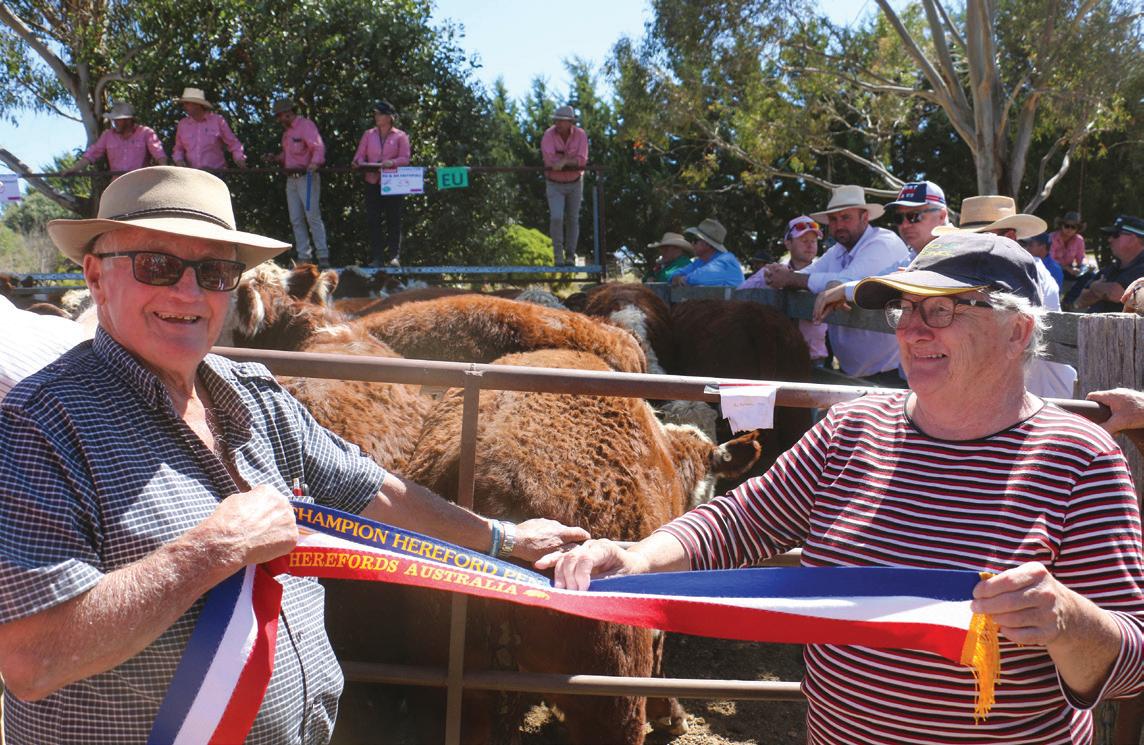
By Kim Woods
GRASS fed programs fuelled demand for Hereford and Hereford infused autumn drop weaners, sending steer prices to $1670 at the Ensay Weaner Sale.
Selling agents Elders Bairnsdale yarded 1276 mixed sex weaners for the March 6 fixture at the Ensay yards to average $1080 and gross $1,379,126. A total of 777 steers averaged $1219 and 499 heifers averaged $864.
The sale was dominated by Anthony Delaney, Delaney Livestock and Property, operating on the heavy end of the steers while other buyers included repeat steer finishers Arthur Angliss, Romsey, Graham Osborne, Officer, and Ian Lester, Scotts Creek, along with SEJ Leongatha, Alex Scott & Staff, Warragul, YC Feeding, Geelong, Elders branches at Yea, Holbrook, Moss Vale, Tasmania, Hotson Ag, and Rodwells Euroa.
Autumn drop Hereford steers rang the bell to top the sale on $1670 and sold down to $500, and for those pens displaying green weights the cents per kilogram on a curfewed basis was 301-405c/kg.
The Shorthorn/Hereford autumn drop steers sold for $1010-$1530, or a curfewed price of 324-393c/kg.
The purebred unjoined heifers sold for $510-$1290 while the Shorthorn/Hereford unjoined heifers made $760-$1280.
Ian Lester, Scotts Creek, judged the Herefords Australia champion pen, awarding the sash to Barry and Topsy Newcomen, Newcomen Herefords, Ensay, for a pen of 20 Hereford European Union accredited and Newcomen blood steers. Mr Lester was impressed with the steers’ weight for age.
The April/May drop calves had a green weight of 434kg and were snapped up by repeat buyer Arthur Angliss, Romsey, for the sale’s top price of $1670 or 405c/kg (curfewed).
Ian Lester and his partner Denise O’Keefe previously finished steers on King Island for grass fed markets but relocated their operation to Scotts Creek, Victoria, two years ago.
The couple finish 200 Hereford and Charolais steers and share farm 500 dairy cows. They paid to a top of $1320 for 362kg Hereford and Shorthorn/Hereford steers from C and J Lloyd at Ensay.
“We used to buy a semi-load of Hereford steers out of these sales but these days it is 30-40 head at 300-350kg, and we turn them off in eight to 10 months,” Mr Lester said.
“We manage to achieve an average daily gain off grass of around 2kg – the best we got out of a paddock in the spring was 3.1kg/day. The best purebred Hereford steer in that paddock was 4.2kg/day off grass over six weeks.
“We buy out of these sales for the quality of the cattle, and they always perform.”
The Hereford steers are finished from 300kg liveweight to 350kg carcase weight in eight to 10 months – no animal is kept for over 12 months – to Greenham Never Ever

program. He said chiller feedback indicated a compliance rate of 95-100 per cent.
“The Herefords do well – on King Island the weight for age of the Hereford meant they could be turned off two months earlier than the other breeds under the same pasture conditions. Overall, Herefords are the best breed, especially for temperament.”
Gary and Samantha Owen, Budgaree Beef, Mirboo North, were inspecting cattle at Ensay to potentially fit their grassfed program for Coles Graze.
“The Hereford cattle out of Ensay do an exceptionally good job at that – we have bought out of here in the past, they are nice medium framed and thick, easy doing cattle on grass,” Mr Owen said.
Being former dairy farmers, the couple are grazing at any time from 1000 to 1200 cattle on high performance pastures using a daily paddock rotation.
The majority of cattle are turned off within six and nine months and achieve an average daily gain from 0.8-1.5kg.
“We supply Coles every week with 48 steers (Hereford, black baldy and Angus) at 500-550kg liveweight (280 kg carcase weight). Most of our cattle are sourced from AuctionsPlus or direct from the paddock,” Mr Owen said.
“The good Hereford is just as much as any other breed. All our cattle are MSA graded, and the better ones are in the early 60s (on the MSA Index) with most of our cattle being 18 to 20 months old when they are killed.
“The Herefords have good fat cover especially on the ribs – we find with young cattle getting the fat cover on the rib is the hard bit, so we have to be selective on the cattle we buy.
“Once we find those cattle which perform, we tend to be a repeat buyer. Most of the good producers want all the feedback on them as well.
“We normally turn off between 1500 and 1800 head a year, and from December onwards we supply a load a week.”

By Kim Woods
ONE of the best line-ups of vendor bred, one mark whiteface weaner calves in the nation caused a sensation with prices hitting a seasonal high for autumn droppers of $1800 in final leg of the 84th annual Mountain Calf Sales at Omeo.
Buyers finishing for grass fed programs made a plunge on the heavyweight autumn drop Hereford steers with Albury commission buyer Graeme Ward snapping up the champion pen at the top price for steer finisher Paul Mason, Wellington, NSW.
Lot feeders struggled to keep up with the pace in the heavyweight cattle over 400kg as feeder prices failed to match the spending power of grass producers.

Selling agents Elders Omeo and Bairnsdale yarded 1402 Hereford and Shorthorn/Hereford cross yearling and mixed sex weaners for the March 6 fixture to average $1153 and gross $1,616,744. A total of 926 steers averaged $1288 and 476 heifers averaged $891.
The sale finalised two days of selling where 8000 cattle were offered at Hinnomunjie, Benambra, Ensay and Omeo, resulting in an enormous economic boost for the region. The three Elders Hereford sales yarded 4344 head to gross $4,665,551 and average $1074.
A large crowd of buyers and visitors from around the nation descended on the Omeo saleyards to see the famed spectacle of cold country cattle in the final leg of the Mountain Calf Sales series.
Autumn drop Hereford steers sold for $650-$1800, while Shorthorn/Hereford autumn drop steers finished at $910-$1590.
Shorthorn/Hereford heifers finished the sale circuit at $850-$1400, and the purebred autumn drop heifers settled at $520-$1340.
The sale opened on the spring drop 2022 calves of Peter and Christine Faithfull, Omeo, with the pen of 19 European Union and Never Ever accredited Herefords snapped up by Gippsland steer finisher Alan Mitchell for the overall sale top of $1810.
Then it was onto the autumn drop 2023 Herefords with the big guns coming out and bids flying in all directions for the Herefords Australia champion pen of 22 European Union and Never Ever accredited steers from Peter and Christine Faithfull.
Commercial Hereford producer Gordon McClure, Beerik Partnership, Coleraine, had judged the champion pen and was impressed with how well drafted the pen was, the evenness, clean fresh coat and trueness to type.
Commission buyer Graeme Ward agreed with the assessment and paid $1800 – the top price for autumn drop Hereford calves across the entire run of major 2024 weaner sales.
The thick and soft April-June drop calves were Mawarra and Glendan Park blood, with Mr Faithfull placing selection emphasis on carcase and weight for age. He likes to attend the Herefords Australia National Sale at Wodonga each year to select at least two bulls.
Brendan and Tracey Ah Sam, Omeo, again topped the Shorthorn/Hereford heifers with a pen of 23 making $1400, after setting a record price of $2900 for females in 2022.
The family also topped the run of Shorthorn/Hereford autumn drop steers at $1590.
Peter and Christine Faithfull topped the Hereford run of autumn drop unjoined heifers at $1340.
Elders National Livestock Manager Peter Homann was sourcing cattle for Princess Royal feedlot, Burra, SA, and Killara Feedlot, Quirindi, NSW.
Mr Homman said the Herefords were outstanding with April-May drop calves weighing 400kg plus.
“The producers here invest a lot in their bulls, and everyone can see it,” he said.
“This is certainly one of the flagship Hereford areas in Australia.”
Mr Homann purchased a few B doubles of cattle destined for either Princess Royal feedlot or to northeast Victorian backgrounders.
“Princess Royal has always been a fantastic supporter of the Hereford breed and run a lot of Hereford cattle.
“To do a grass program, I don’t know why you would go past a Hereford or their cross. They convert it into saleable meat, it’s all about yield and performance.”


20 April/May drop, European Union, Newcomen blood steers weighing 434kg for the top price of $1670 at Ensay.

and
a
18

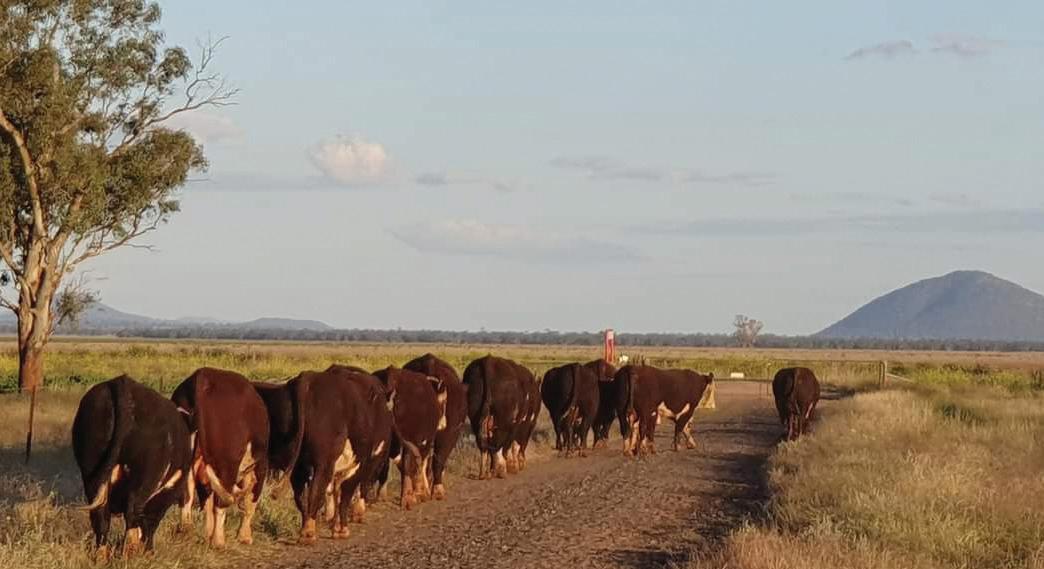
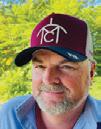
select for functional cattle that can handle Australian outback conditions. Good growth rates, carcass and fertility are essential,”


LOT feeder and backgrounder demand drove Hereford steer weaners to a top of 360c/kg and $1293 at the George and Fuhrmann annual Northern Rivers
Hereford and Angus weaner sale
Selling agents George and Fuhrmann Casino, Warwick, Tweed, Stanthorpe and Bangalow yarded 1314 mixed sex weaners, mostly European Union accredited and PCAS eligible, for the fixture on March 15 at the Northern Rivers Livestock Exchange, Casino, NSW.
The major buyers in the Hereford steers were Ironbark Herefords, Barraba, NSW, and Wickham Farms, Killarney, Qld.
Hereford steer weaners weighing over 350kg liveweight returned 343344c/kg or $1290- $1293 while the lighter steers under 350kg made 348360c/kg or $964-$1214.
The Herefords Australia champion pen, judged by Cameron Hollis, Lotus Herefords, weighed an average of 329kg and returned 354c/kg or $1164 for the vendor, John and Marie Smith, Glen Ayr, Woodenbong.
Their top pen of 312kg calves, EU accredited, made the sale top on a cents per kilogram basis of 360c/kg or $1122, and on a dollars per head basis with calves weighing 376kg and returning $1293.

Jim and Jan Smith, Townview, Urbenville, sold 334kg Hereford steers to a top of 358c/kg or $1197.
George and Shirley Hardcastle, McPherson Herefords, Old Kooreelah, sold 321kg steers for 358c/ kg or $1151. The couple also had the champion pen of Hereford heifers which topped at $800 while the seconds sold for $760 to repeat buyers Daryl and Rhonda Amos, Old Bonalbo, for their Brahman F1 program.
Among the major buyers was Adrian Spencer, Ironbark Herefords, Barraba, sourcing the heavy end of the steers at an average of 340kg liveweight and 352c/ kg for the family’s 1000 head feedlot.

John Smith, Glen Ayr, Woodenbong, and his grandson Archie Holden, Roseview, Old Bonalbo, and his Hereford steer weaners which sold for a sale top price of $1293. Images: Queensland Country Life
Growth promotant free Hereford steers and heifers are grain finished for 100 days for both supermarket and export customers.
Mr Spencer said carcase feedback had revealed consistently high MSA Index scores, ideal fat cover and, in the feedlot, an average daily gain of 2kg on a barley and silage-based ration.
“Casino always has good lines of well-bred Hereford cattle – we pay a premium for the Ironbark blood cattle as we get the superior weight gains and carcase performance,” he said.
“We collect all the data and benchmark how our client’s and our own commercial cattle perform. The feedlot is averaging a 97 per cent compliance at the top of the grid.”

COMMERCIALLY relevant bulls with fertility, temperament and weight for age will be offered at the nation’s longest running regional multi-vendor bull sale, the 79th Glen Innes Hereford Show and Sale on July 24.
To be held at the Glen Innes saleyards, the show and sale is expected to draw a similar number of vendors as past years offering around 50 polled and horned bulls plus 14 registered females.
All bulls are semen and pestivirus tested, vet checked, and ultrasound scanned. They will be presented with liveweights, scrotal circumference, rib and rump fat depths.
Auctioneer Lincoln McKinlay with Hugo and Ben Monie of Thornleigh Herefords with the 2023 top priced bull Thornleigh Black Hawk S206, which sold for $18,000 to David Phelan. Image: StudStockSales
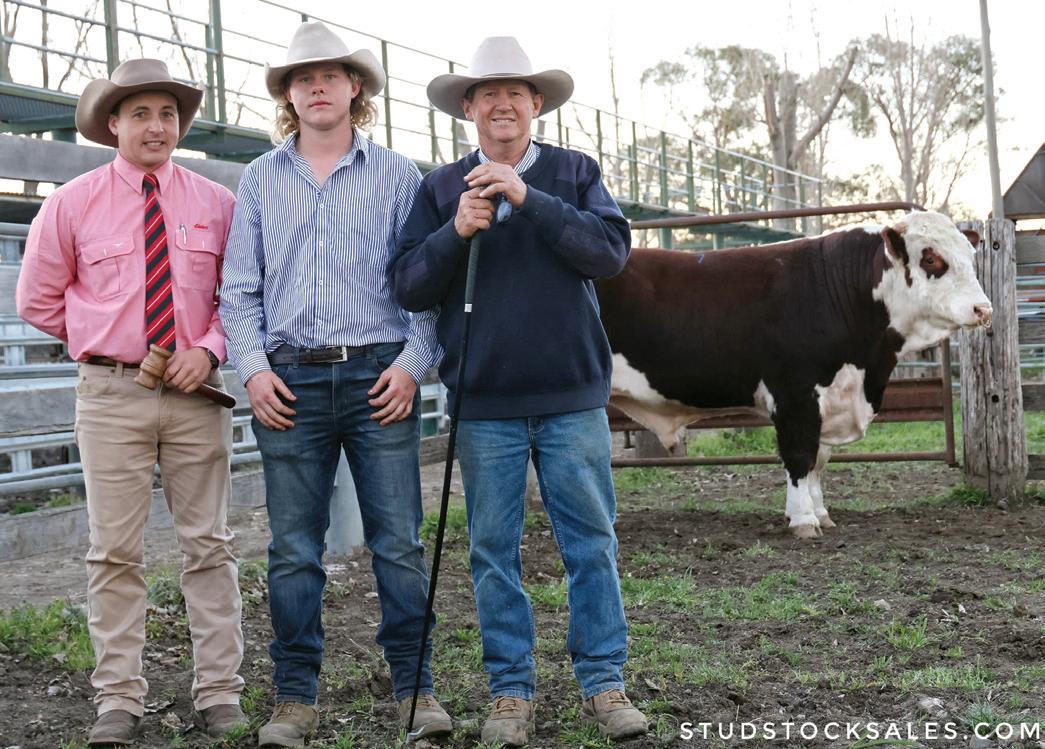
An evening social function will be held at the New England Club on Tuesday, July 23 from 6.30pm for all vendors, buyers, and visitors.
Cattle will be judged in the morning from 9am by Doug Bennett, Little Valley Brafords, Casino, NSW, with classes for junior, intermediate, and senior bulls, the champion pen of three, and champion truck load of six bulls. Heifers will also be judged this year.
Starting at 2pm, the sale will be interfaced with AuctionsPlus and auctioneer in the sale barn will be Lincoln McKinlay, Elders Stud Stock.
Glen Innes Hereford Bull Show and Sale Committee chairman Peter Weller said the sale had successfully transitioned to a one-day format in 2023.
Mr Weller said there was a good line up of industryrelevant bulls this year with a combination of the best semen quality along with growth and carcase traits.
Last year’s sale topped at $18,000 and averaged $7438 for 35 bulls, while nine of 13 female lots sold to a top of $5000 and averaged $3472.
Offered by the Monie family of Thornleigh Herefords, Little Plain NSW, Thornleigh Black Hawk S206 was the top price bull bought by David Phelan, Yarram, Vic.
The catalogue will be online at www.herefordsaustralia. com.au or from Elders Glen Innes on 0267 397 300.


THE Herefords Australia Youth Committee is excited about 2024, which is shaping up to be a fantastic year.
We are looking forward to holding our annual Youth Expo in Cootamundra from July 11 to 14. We have received an overwhelming number of entries and are excited to see everyone.
It’s important the next generation of beef cattle producers have the opportunity to be involved with Hereford cattle and to show them how great they are, to work with and ensure the future of the Hereford breed in the beef industry.
At the Wodonga National Show and Sale dinner we held our Youth Auction. We are delighted to announce we raised $12,300 at the auction which will be used for our upcoming Expo and other Hereford Youth programs.
We would like to thank all our donators, bidders and under bidders from the auction night, who made it possible and supported us. We look forward to seeing everyone in July!
Cassie
Herefords Australia Youth President

IT’S that time of year again where we are in full swing organising the 2024 Expo, it seems to come around faster and faster each year.
We are super excited to invite and welcome everyone to the Harris Farms 2024 Herefords Australia National Youth Expo at Cootamundra on July 11-14. The committee is doing a fantastic job of bringing it all together for what is shaping up to be another great event, with over 150 competitors entered. Come down and check it all out.
As the Expo finishes, we are still busy with Committee applications opening. I encourage all youth who have an interest in the Hereford breed to come forward and apply.
We also have our annual calendar coming up, please keep your eye out for the booking form on the website or our socials and jump in quickly to secure your advertisement spot. Get your cameras out and start clicking away as we will be opening our photo competition in August.
The 2025 World Hereford Conference is just around the corner, we will be sending one team (four youth members) over to Kansas City in October 2025 to compete in the Young Breeders competition.

We will be releasing applications for those who are interested in being a part of the team in the Spring. We will be fundraising to help get this team to the USA by running a 100 Club and if you would like to pick a number, head to the website. Not only are you helping the team, but you will also have the chance to win one of the five prizes with a $1000 prize pool.
By Grace Collins
IN March 2024, I had the pleasure of travelling to the beautiful South Island of New Zealand, as part of my Herefords Australia Youth Travel Scholarship. Along with Joel Forrest, Holly Speers and Boudicea Blatch with contacts and connections from Te-Angie Poll Herefords, we saw some amazing cattle and met some awesome people.
For the first week, we were generously welcomed into the home of the Robertson family of Duncraigen Farms, where we enjoyed many farm tours, as well as clipping and washing cattle to prepare for Wanaka Show on March 8-9.
We viewed Duncraigen Zeus at Duncraigen Farms and Kairuru Penman, now owned by Duncan and Christine Chisman. RG Ogilvie and Sons owns the Australian semen rights for these two bulls, with calves on the ground at TeAngie, many as part of the show herd, and it was fantastic to see both these bulls and their NZ progeny. The next farm tour was to Limehills Herefords, with past NZ Herefords President, Gray Pannett. Following on we visited Laurie, Sharon and Becs Paterson, at Waikaka Genetics. While there, we clipped their three bulls for the show followed by a tour of the farm and their magnificent gardens.
The week culminated in travelling to the Wānaka A&P Show, where we attended along with members of NZ Hereford Youth, and helped prepare and exhibit nine head of Hereford cattle for both Duncraigen and Waikaka studs, in the stunning backdrop of Lake Wānaka and the mountain ranges.
We were generously offered accommodation at Te Anau and Queenstown and are grateful for Marc and Harry Robertson organising us transport as we enjoyed exploring the spectacular scenery around Queenstown, Te Anau and Milford Sound.
As we ventured north, we visited Orari Gorge Station, at Geraldine, and were shown around their Hereford and deer farm by Rosa and Graham Peacock. Through discussions we learned they have made small changes to their breeding program recently to produce slightly smaller framed bulls that are higher yielding.


We were then welcomed into the home of Rob and Julie Stokes, who in partnership with Rob and Mary Ann Burrows, operate Richon and Beechwood Herefords, located in the Lees Valley. They estimate 70 per cent of their yearling sale clientele are dairy buyers. However, they are now running a smaller operation, due to the current drier climate in the Canterbury region. Rob Stokes also took us to visit more Limehills progeny, including Limehills Streaker at Grassmere Poll Hereford & Riverlands J Angus. Our final stop was Glacier Horned Herefords at Weheka, with a tour from Emma Williams, comparing EBV’s of bulls in their final bull sale. It was clear NZ production systems vary considerably between the south and north regions within the South Island. Most notably due to the difference in climate and landscape, harsh winters mean more intensive forage production is required during spring and summer to maintain the feed availability. As a result, this allows for higher stocking rates to graze crops in their vegetative stage.
In comparison to Australia, the major market for Hereford bulls in NZ is the dairy industry. They are used over the dairy heifers due to their low birth weight and can produce first cross calves with enough saleable yield for market. These insights into NZ production systems, and the difference in the importance of showing cattle to the marketing of their bulls compared to Australia was fascinating. I am extremely grateful to Herefords Australia for the Youth Travel Scholarship which afforded me these experiences, and I hope to bring these connections I have made throughout NZ Herefords into my community through committees and youth programs.


AROUND 100 young cattle handlers from rural and urban backgrounds across NSW and Queensland paraded 120 cattle, learnt new skills and cemented friendships at the Herefords Northern NSW Youth Camp.
Hosted by Herefords Northern NSW Youth Group, the camp was held at Glen Innes, NSW, on January 12-14 and drew a large percentage of new competitors.
Lily Gavenlock, Taminga Poll Herefords, Cliftleigh, NSW, won the prestigious Most Potential Breeder award, taking home Glenwarrah Satisfaction T267, an October 2022 drop heifer donated by David and Kate Collins, Glenwarrah Herefords, Bundarra, NSW. The heifer was halter broken and prepared by fellow camp competitor Drew Weller, and was sired by Mountain Valley Quantum Q016 and out of Glenwarrah Satisfaction M012.
Lily took four heifers to the camp, winning reserve senior champion female with Rayleigh M Queenie T112,
was a buddy mentor for the weekend for the peewees, and thoroughly enjoyed the educational activities, especially the farm visit.
Young stud principal Mitch Taylor, Eclipse Poll Herefords, Quirindi, showed his versatility by winning champion senior and grand champion junior judge, grand champion herdsman, third in the senior paraders, and first in the photography competition.
Mitch went on to parade the grand champion bull, Eclipse Optimus Prime U010, while Eclipse Poll Herefords exhibited the champion futurity female, Kanimbla Irish Rose P160 (led by Sam Roche, Timor, and Marcus Wythes, Bathurst), reserve champion commercial heifer, Poppy, led by Jaslin Boyd, Whittingham, and had the best presented team over five head.
Eclipse co-principal, Emily Taylor, received the New England Hereford Youth Club Member of the Year Award.
Lucy and Charlie Crowley, Armidale, led The Cottage Countess S001 to
Logan Scott, Inverell, was junior champion judge and Mia Mackay reserve champion while Annabelle Jones, Roseville, took out the intermediate champion and Jackson Emery, Inverell, the reserve. Breanna Bourke, Mudgee, was reserve senior champion judge.
Brodie Scott, Inverell, was champion peewee herdsman with Sophie McDonald, Upper Hunter, in reserve, Logan Scott also picked up champion junior herdsman with Skye McIndoe, Inverell, in reserve, and Amelia Miller, Walcha, was intermediate champion with Isla McIndoe, Inverell, in reserve.
Maddison Bailey, Tamworth, was senior champion herdsman.
Encouragement awards were presented to Baz McDonald, Inverell, in the peewees, Annabelle Dean, Mallanganee, in the juniors, Annabelle Jones, Roseville, in the intermediates and in the seniors, Macey Davis, Tingha.
Paraders judge Rachael Constable awarded the champion pee wee to Sophie McDonald with Brodie Scott, Inverell, in reserve. Logan Scott was in the winner’s circle again with champion junior and Hudson Emery, Inverell, in reserve, Rhani Dorey, Casino, was champion intermediate, and Macey Davis, Tingha, reserve champion senior parader.
Chilcotts Creek Poll Herefords, Tamworth, received the best presented team under five head.
Ben Monie, Thornleigh Herefords, Little Plain, NSW, judged the cattle classes, awarding the champion steer to Infinity Milybar led by Benjamin Towner on behalf of Infinity Poll
Herefords, Tamworth. Reserve champion steer was Hunter Lakes Uber led by Max Sternbeck, Broke, and owned by Hunter Lakes Poll Herefords, Greenhills, NSW.
The reserve champion bull was Reevesdale Tutankhamun paraded by Damon Murphy, Inverell, and owned by Reevesdale Poll Herefords, Gum Flat, NSW.
Skye McIndoe paraded the champion junior female, Jindalee Miss Minerva U018 for Jindalee Herefords, King Plains, NSW. Reserve champion junior female was Mountain Valley Matchless U003 led by Lilygrace Sleeman and owned by Mountain Valley Poll Herefords, Coolatai, NSW.
Chilcotts Creek South T028 was sashed as the champion intermediate female and paraded by Georgia Bailey, Tamworth, and owned by Chilcotts Creek Poll Herefords. Yalgoo Persistence T247 was paraded by Marcus Wythes, Bathurst, to reserve champion intermediate female for Yalgoo Partnership, Walcha, NSW.
Bella Hannaford, Tamworth, paraded champion senior and grand champion female Tycolah Grace T011 for Tycolah Poll Herefords, Barraba, NSW.
The incoming executive elected at the annual general meeting of the Herefords Northern NSW Youth Group were Riley Weller, president, Damon Murphy, vice president, Lucy Crowley, secretary, Macey Davis, assistant secretary, Jessica Kernahan, treasurer, Makaala Dodd, publicity officer, Morgan Hay, sponsorship, and Anne Starr, youth coordinator. General committee members are Drew Weller, Grace Stuart, Lilygrace Sleeman, Logan Scott and Bree Bourke.
reserve champion futurity female, with Lucy receiving the Bred and Owned award, and the coveted Will Tanner Memorial Award.
Drew Weller, Weller Bros Herefords, Hodgson Vale, Qld, won a scholarship to the 2024 Herefords Australia
National Youth Expo after being named as the Northern Breed Ambassador.
Drew was senior champion and grand champion parader, reserve senior champion herdsman, and Weller Bros exhibited the champion commercial heifer, MVP Javerline (led by Lily-Grace Sleeman).
Jacob Merrick, Singleton, received a $1000 educational scholarship, was sashed as reserve champion intermediate parader, and placed third in the intermediate junior judging.
Over judge Scott Hann, Truro Herefords Bellata, awarded Hunter Will, Delungra, champion pee wee junior judge and reserve champion to Harry Durkin, Warialda.




By Ro Koebel
AN up-and-coming young advocate for the northern Australian beef industry has been awarded the 2023 CM Hocking Scholarship.
Sam Hayes, 21, grew up on Deepwell Station, 100km south of Alice Springs, where his family ran Hereford cattle.
It was during his time on the family property Sam developed a love for Hereford cattle after seeing how well they fared in the unpredictable seasons of central Australia. Now in his second and final year of his agribusiness degree at Marcus Oldham College in Geelong, Sam hopes to use what he learns through his studies to return to the Northern Territory and ultimately end up running his own property.
While Sam didn’t have as much to do with the beef industry while attending high school in Adelaide, he remained connected to the industry through his mother Tracey Hayes, who was at the time the CEO of the Northern Territory Cattleman’s Association and part of the successful class action against the Federal Government for the 2011 live export ban.
Upon completing high school, Sam spent time working as a station hand on Newcastle Waters Station in the west Barkly region of the Northern Territory.
It was during this time his passion for the northern beef industry was reignited, and he decided to seek higher education with which he could ultimately return to the industry.
Receiving the 2023 CM Hocking Scholarship will assist Sam with the cost of completing his studies at Marcus Oldham and ultimately assist him in achieving his long-term career goals.
In his scholarship application Sam identified the need for Herefords to regain market share as one of the key issues facing the breed. He discussed how the desirable traits of Hereford cattle should be promoted through market research, ambassadors, and improved brand image.
In Sam’s application he also discussed the opportunities and challenges for the wider Australian beef industry.
The challenges Sam addressed were biosecurity, methane emissions from the beef herd and the associated consumer perceptions.
The emerging threat of exotic animal disease outbreak, with particular emphasis on Lumpy Skin Disease (LSD) and Foot and Mouth Disease (FMD) were the major challenge and Sam was keen to ensure industry was well prepared to address potential future issues.
He identified methane emissions from the beef herd and consumer perception of this issue as an interesting challenge.
Advocacy from environmental groups and activists has led to a wider consumer belief the methane emissions from cattle are significant drivers of climate change and have led to social trends such as “Meat Free Monday”.
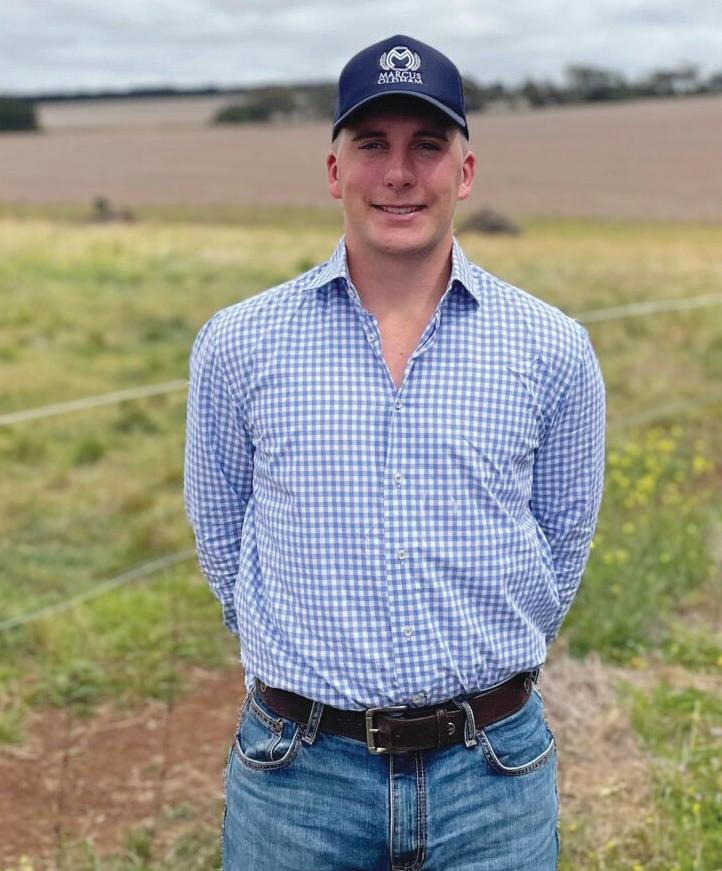
to campaign to educate the Australian public and consumers on several of the industry’s positive impacts, including the degradable of red meat, and developments in environmental and animal welfare.
in the beef industry and agriculture as a whole.
which Sam is genuinely excited to be a part of, along with continued production improvements and innovations which see producers able to improve how they grow food and do more with less.
with consumers in a transparent and authentic way and the importance of maintaining genuine brands.
and healthy food, consistent eating quality, animal welfare, environmental welfare, and Australian ownership of farms.
producers. There’s a lot of uncertainty in global trade and we’re extremely lucky to have the food security we do,” he said.
when the an ongoing annual scholarship for Australian citizens undertaking industry.
By Ro Koebel
BREEDING cattle and farming for more than 160 years in Victoria’s Gippsland region, the Manson family are celebrating a milestone of 70 years of their Wanrua Poll Hereford Stud in 2024.
Established in 1954 at Newry by Ian Manson and now run by his son Andrew, the Wanrua stud prides itself on the natural doing ability, weight for age and functionality of their animals.
The Manson family began producing beef in the Newry area in 1863 when Ian’s great-grandfather Donald Manson (born in Scotland in 1829) selected land at Maffra and Newry to begin farming and grazing.
Land owned by Donald is still in the Manson family today, with Andrew’s children the sixth generation to live and work
In 1948 following Ian’s father Don’s return from army service in New Guinea, a commercial cow herd was established which saved time travelling to various store sales and began Ian’s interest in breeding cattle.
“In the late 1940s and early 1950s I would regularly attend the Melbourne Royal Show to watch the judging of the beef breeds, and it was here that I developed a great interest in Poll Herefords,” Ian said.
It was at the 1954 Royal Melbourne Show auction the Wanrua stud was established with the purchase of the Reserve Junior Champion Bull Kildrummie Samson from Doug Carnegie.
In November of the same year Ian attended the Mt Hamilton dispersal and purchased the Melbourne Royal
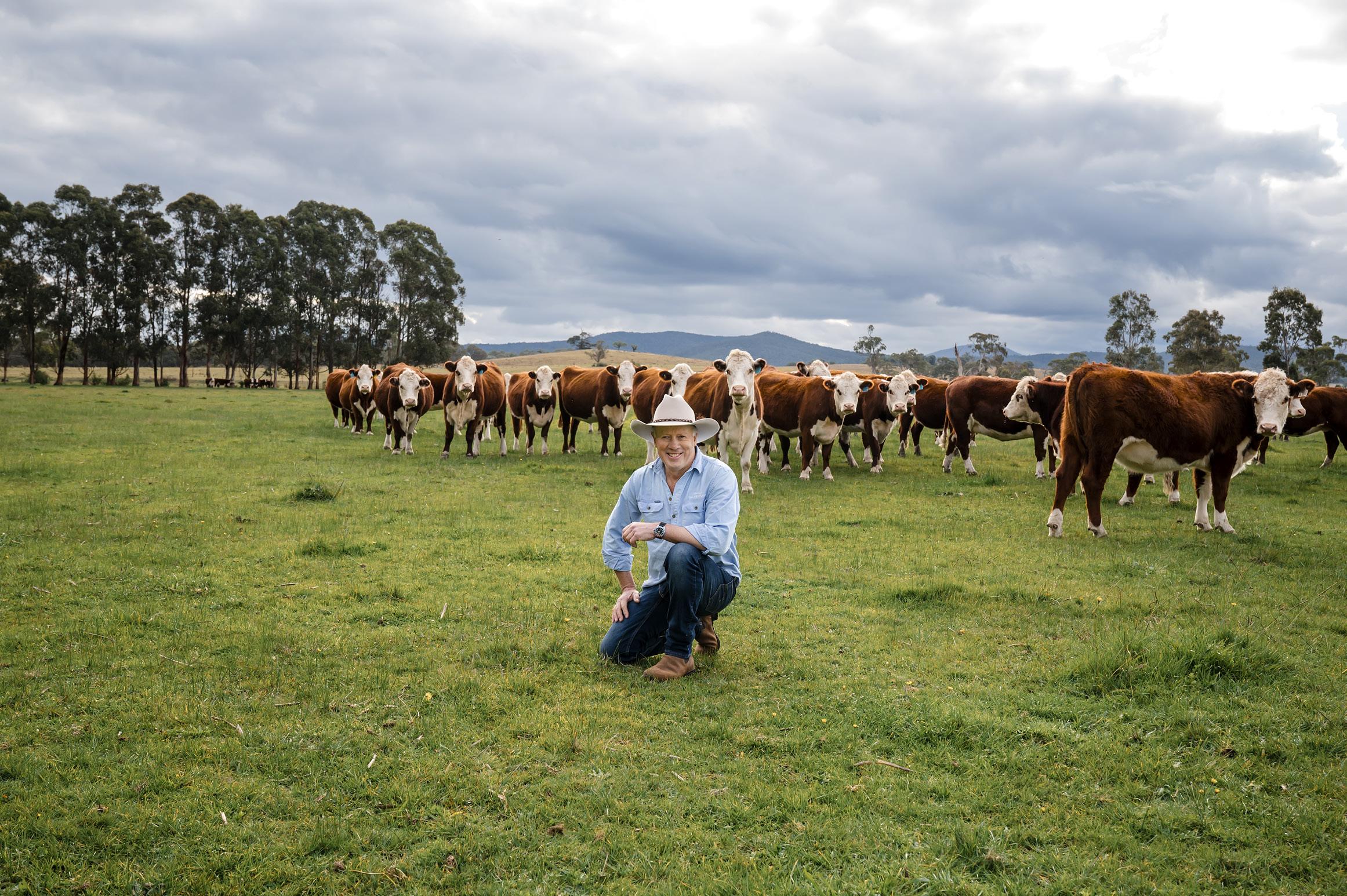
Ian fondly remembers his first trip to Melbourne Royal as an exhibitor and marks this as a true starting point for the stud.
“I took my first bull to Melbourne Royal in 1957 and came home with a ribbon, and then the stud was on its way.”
In the 70 years since, Wanrua bulls have been sold to clients in Western Australia, South Australia, Tasmania, Victoria, Queensland, and NSW.
Bulls were originally sold on-farm but have since been taken to multivendor sales including Wodonga and Dubbo Nationals, Naracoorte Whiteface Bull Sale, Bairnsdale, and Whittlesea Bull Sales.
Wanrua still regularly exhibits at the Wodonga National Show and Sale, as well as holding an annual on-property bull sale in March.
Andrew has continued Ian’s commitment to the local community, competing in cattle events and shows at Maffra and Sale.
Wanrua has enjoyed considerable success at Melbourne Royal with numerous champions and supreme exhibits over the years, including most recently in 2023, where junior and grand champion heifer Wanrua Q Victoria took home the honour of supreme exhibit.
In addition to winning the supreme exhibit, Wanrua exhibited the junior grand champion bull, Wanrua Tank, and was named the most successful stud.
“What a way to start celebrating the stud’s 70th year,” Ian said. Andrew was similarly buoyed: “It’s been a great achievement for us and a credit to the work of everyone at Wanrua.”
Also in 2023, Wanrua and the Manson family were awarded legend status at the Royal Melbourne Show which was a great honour to the whole family.
“We’ve worked incredibly hard to help produce such exceptional animals, and to be increasingly recognised by our peers for that is fantastic,” Andrew said.
Attending shows and sales has been useful for the stud, exposing the Wanrua program to many more potential clients.
Since 2000, Wanrua has been had an active embryo transplant, AI & IVF program, and have also started using genomics to increase genetic accuracy and product.
“By using our own top donor cows and young heifers we have found these methods to be a great way of increasing the genetics in our herd, so now we’re consistently producing

animals with outstanding thickness and length, of good calving ability, and structurally sound,” Andrew said. Andrew attributes the stud’s success in part due to a whole-of-family effort.
“Our children all have their own careers now, but they’ve made it their business to be involved in the property and each has made their mark - which is very pleasing.”
Despite retiring some years ago, Ian and wife Thea, have maintained an abiding interest in Wanrua, visiting regularly and maintaining their passion for the property and the wider industry.
In looking to the future, Andrew noted the many difficulties Australian farmers now face.
“Like all farmers, our task and the challenge remain the same, greater efficiency and improved outcomes.”
As Wanrua celebrates this remarkable milestone, Ian reflected that, “Seventy years is a significant achievement. We’re excited for what lies ahead and confident that Wanrua will continue to thrive”.
With its strong foundation - built on family heritage, innovation, community engagement and a passion for breeding top-quality cattle - Wanrua is well-positioned to navigate the future, helping ensure the Manson legacy endures through the next 70 years.
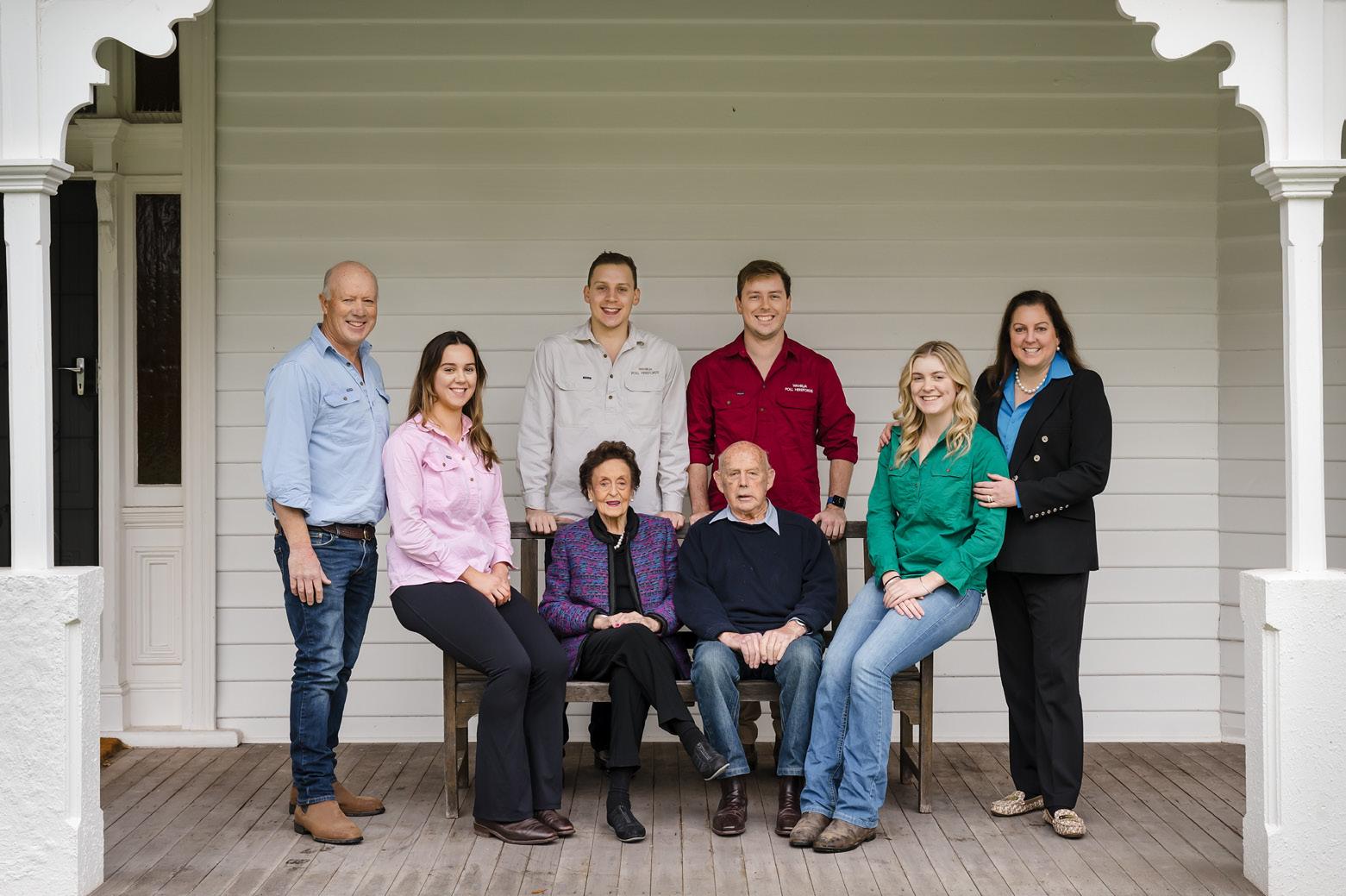
By Kim Woods
HEREFORD bull sales valued at more than $8 million changed hands as southern Australian on-property and multi-vendor sales kicked into gear for 2024.
A total of 29 on-property sales were held from February to May in NSW, Victoria, Tasmania, and South Australia, with 866 bulls sold under the hammer from the 1262 offered, a top of $96,000, gross of $7,904,625 and average of $9128. With multi-vendor sales included, 922 bulls were sold from 1339 offered to gross $8,394,614 and average $9105.
The autumn bull selling season got underway in February with a cracking top price of $96,000 and a significant slice of Hereford heritage going under the hammer with the dispersal of the Tummel stud.

Vale Herefords, Pinkett, NSW. Yarram Park sold 48 from 58 bulls for an average of $11,667.
The Pearce family, Yavenvale Poll Herefords, Adelong, NSW, marked their silver anniversary sale on February 14 with a top price of $96,000 in what was one of the single biggest offerings of Hereford bulls across the nation this autumn.
From the 135 bulls offered, 109 were sold for an 81 per cent clearance, a top price of $96,000 and average of $9486.
The top price bull, Yavenvale Trump Card T350 (AI) (PP), sold as Lot 66 over the phone to new clients Jacqui Baulch and children Tom and Indianna, Jaclinton Poll Herefords, Illowa, Victoria, with semen retained by Yavenvale for in-herd use.
The second top price of $28,000 was outlaid by Barry Newcomen, Newcomen Herefords, Ensay, Vic, for Yavenvale Taylor Made T874 (AI) (PP), a new Herefords Australia Super Sire.
Injemira Patriarch T340 (PP), a 724kg October 2022 drop son of Bowen Patriarch P017, was knocked down for $75,000 at the Injemira Beef Genetics on-property sale at Book Book, NSW, on February 20, to Grace and Emily Elsom, Emigrace Poll Herefords, Warrabkook, Vic. It was the third top price in a row at Injemira for the sisters and their parents, David and Michelle.
The second top price at Injemira was $40,000 achieved twice for Injemira Patriarch T344 to Ardno Livestock Trust, Ob Flat, SA, and Injemira Heidelberg T343 to Willinga Pastoral, Wandoan, Qld. A total of 85 bulls were sold from the 90 offered for the season’s top on property average of $11,929.
Yarram Park Herefords, Willaura, topped at $50,000 on February 12 when Yarram Emperor T151 sold to a partnership of Newcomen Herefords, Ensay, Vic, and Amos
Ian and Diana Locke, Wirruna Poll Herefords, Holbrook, offered two Herefords Australia Super Sires in their autumn catalogue, with one lot, Wirruna Smokin Joe S010 (AI) (PP) being the second highest marbling sire in the breed at +2.4 per cent. The 1118kg Smokin Joe sold for $36,000 to Barry Newcomen, Newcomen Herefords, Ensay, Vic, while Wirruna Steakout S457 (PP) sold for $32,000.
Wirruna Shea S222 (AI) (PP), sired by Limehills Starter 160062 was purchased for the top price of $42,000 by Bendoc Park Herefords, Delegate, NSW.
Paul and Judi Sykes, Lynton and Lauren Hill, Karoonda Herefords, Gelantipy, sold to a top of $30,000 twice at their on-property sale in March, and cleared 59 of 66 bulls to average $8632. John and Amanda Pendergast, Benambra, in partnership with Donald Betts, Benambra, outlaid $30,000 for Karoonda Altitude while George and Shirley Hardcastle, McPherson Herefords, Old Koreelah, NSW, secured Karoonda Alpine for $30,000.
Andy and Serena Klippel, Sugarloaf Creek Herefords, Corryong, topped at $28,000 and cleared 30 from 36 bulls to average $11,833 for their February on-property sale. Sugarloaf Top End T107 (H), a son of Sugarloaf Quality Q105, was sold for the top price to Allan Hewitt, Charvel Grazing Company, Theodore, Qld.
Rob and Heather Francis, Yallaroo Herefords, Brunswick, WA, topped the WA Supreme Bull Sale multi-vendor multibreed sale on March 20 at Brunswick. Yallaroo Tarzan T7 sold for $22,000 the top price across all breeds. The 898kg Tarzan was bought by repeat buyer ED Wedge, Gingin. Yallaroo cleared all 11 bulls to average $11,000 while Quaindering Poll Herefords sold two from four to average
$5500. Herefords topped the breed average from the nine breeds on offer at $10,154.
The Trovatello family, Glendan Park Herefords, Barfold, sold Glendan Park Top Shelf T175 for the top price of $20,000 to repeat buyer, the McClure family, Moree Partnership, Edenhope. A total of 29 bulls were cleared from the 39 offered for an average of $10,407.
The Archer family celebrated their 40th annual Quamby Plains bull sale with a top price of $20,000 for Quamby Plains Thunder T353 bought by Glendan Park Herefords. The sale held at Hagley, Tasmania, cleared 43 from 53 bulls for an average of $8140.
Allan and Heather Morgan, Morganvale Poll Herefords, Willalooka, SA, sold 33 from 49 bulls to a top of $18,000 for Morganvale Tarcowie T112 and average of $8485. The top price bull was purchased by repeat buyer Richard Morgan, Ararat, Vic.
Rob and Tim Hayes, Tarcombe Herefords, Ruffy, Vic, sold 19 bulls from 36 to top at $18,000 and average $6842. Gerard and Brian Kelly, Kilmore, bought the top price bull, the 652kg Tarcombe Resolve T230 (PP).
The Sykes family, Mawarra Genetics, Longford, topped at $18,000 for Mawarra Legit T024 purchased by Ironbark Herefords, Barraba, NSW. The sale cleared 51 from 72 bulls for an average of $8406.
Alastair and Jayne Day, Allendale Poll Herefords, Bordertown, SA, cleared 37 from 39 bulls at their on-property sale to average $8457 and sold the top price bull, Allendale TDF Justice, for $17,000 to Craig and Robyn Gum, Kombali Farms, Pinnaroo, SA.
Howard and Allison Yelland, Glentrevor Herefords, Finley, topped at $16,500 for their February 12 bull sale for a son of Wirruna Noel N049, Glenrevor Noel T411. The bull ranked top 1 per cent for carcase weight, eye muscle area and all indexes.
James and Kate Luckock, Ennerdale Poll Herefords, Dundonnell, Vic, topped at $16,500 for Ennerdale Regime (AI) (PP) selling to first time commercial clients Coryule Pastoral, Willowvale. The sale averaged $7020 for 27 bulls sold from 36.
Lachy and Lou Day, Days Whiteface, Bordertown, SA, had a high clearance

rate of 95 per cent at their on-property sale for 41 from 43 bulls. The top price of $16,000 was achieved three times for Days Milestone T047 bought by Mahwalloak East, Stockyard Hill, Days Limestone T094 to JM Childs Farming Trust, Kalangadoo, and Days Godfather T178 to Tom and Amy Honner, Minlacowie stud, Brentwood.
David and Olwyn Lyons, Melville Park Hereford and Poll Herefords, Vasey, sold 22 bulls from 37 offered to a top of $15,000 for Melville Tipperary T487, bought by new client Trent Morris, South Hamilton, to average $7477.
Nathan and Amanda Clarke, Wongiwilli, Mount Gambier, kicked off the autumn sales in South Australia on February 9 with 15 bulls topping at $14,000 for Wongawilli Tuck, a son of Wirruna Qabita Q198.
Barry and Topsy Newcomen, Newcomen Herefords, Ensay, topped at $14,000 at their March sale for Newcomen Twilight Payment T025 selling to repeat buyers Evan and Dot Newcomen, Ensay.
Philip Davie, Guilford Poll Herefords, Ouse, Tasmania, marked the 50th annual sale with a top of $14,000 for Guilford Telegram T070 (PP) bought by Jamie and Rebecca Woolley, Glen Huon.
The final sale of the season was held in May by Michael and Cheryl Rutherford, Stanford Poll Herefords, Bathurst, with a top of $14,000 for Stanford Troll T245.
Rick and Leanne Hodge, Valley Vista Herefords, Buchan, sold bulls to a top of $10,500 for the 802kg Valley Vista Thunderstruck T202 while Andrew and Ange Lyons, Wilkah Herefords, Vasey, Vic, topped at $10,000 for Wilkah Holyfield T003.
In the female sales, Wirruna Poll Herefords sold a selection of 10 from 11 PTIC females as individual lots to average $4100 and 67 registered cows in group lots at their on-property sale. Wirruna Doreen P403 (P) topped the PTIC individual lots at $6500 while the group lots topped at $2200 for spring calving cows aged five to six years and average of $1904.
Truro Herefords and Poll Herefords, Bellata, sold eight stud females to average $3000 in February. All cows were PTIC to Warwick Court Roma R111.
The Comley family, Ardno Performance Livestock, sold 20 PTIC
heifers, due to calve to Injemira Robert Redford Q287 within weeks, for $2625, at their on-property sale. Ian Macdonnell, Glenarm, bought the 20 weaner heifers, daughters of Robert Redford, for $1270.
Sugarloaf Creek Herefords sold 11 from 12 heifers to a top of $6500 for Sugarloaf Ladylike T183, an Ironbark Daybreak Q017 daughter purchased by Beggan Hill Herefords, Harden, and average of $3773 at their on-property sale.
Injemira Beef Genetics, Book Book, sold PTIC heifers, 22 to 23 months, at the on-property sale with Lake View Regen Ag, Currawang, purchasing 26 to a top of $2175. The heifers were due to calve from the first week of April and were joined to sons of recordbreaking sire Injemira Robert Redford Q287.
Peter and Karen Weller, Swanvale Herefords, Winton, NSW, held an online major female reduction sale on March 15 with cows and calves selling to $3000 and semen straws to $15 each.
Tarcombe Herefords sold 12 heifers at their on-property sale to a top $4400 for Tarcombe Priscilla T139 (P) to Wanrua Poll Herefords, Newry, and averaged $2733.
Kirraweena/Glenholme Herefords cleared all 26 heifers at their onproperty sale to average $1876 and top at $2150 to repeat buyers Dennis and Denice Griggs.
Llandillo Poll Herefords held their “About Dam Time” sale at The Lagoon, NSW, on March 9 with guest vendor JTR Cattle Company. The sale resulted in a 100 per cent clearance and topped at $9000 four times. A total of 38 heifers sold to an average of $4764, one bull sold for $8000, 20 semen lots averaged $100 and three recipients sold for an average of $3750. The top price heifers included Llandillo Last Day U91, Llandillo Blush U43, the pick of two Harriet females and the pick of the Llandillo spring T drop heifers.
Guilford Poll Herefords, Ouse, Tasmania, sold five heifers at their 50th annual sale to a top of $3500 for Guilford Satin U079 and an average of $3000. Stanford Poll Herefords sold first calf heifers with calves to $2500, station mated heifers to $1700 and cows, 30 to 32 months, with calves to $2100.



By Kim Woods
THE Aster cow line dominated the ring at the 2024 Royal Canberra Show’s Hereford feature show with two females taking calf, senior, grand and supreme exhibit for a NSW central west stud.
Exhibited by Andrew and Jessica Quirk, Pinnacle Poll Herefords, Forbes, NSW, the prolific donor dam Llandillo
Aster S56 (P) was sashed as senior and grand champion female and supreme exhibit by judge Steve Crowley, Tycolah Poll Herefords, Cobbadah, NSW.
The April 2021 drop female was by Grathlyn Pacemaker and out of Landillo Aster P010, a Glendan Park Lancefield L037 daughter, and was shown with a July drop heifer calf, Pinnacle Aster U003 (S), sired by JTR Royal R046. She was following up a senior and grand champion Hereford female win at the Crookwell show a few weeks earlier.
Aster had been purchased as the top priced female at the 2022 Dubbo National Show and Sale by the Pinnacle stud from vendors Llandillo Poll Herefords.
The supreme exhibit’s embryo calf, Pinnacle Aster U073 (AI) (ET) (P), also
impressed the judge to take the calf champion female.
The April 2023 drop heifer was sired by Tycolah Queenscliff N029 and was following her hit out at the Crookwell show where she won junior champion Hereford female.
Junior and grand champion bull was Granite Hill Toro T010 (ET) (PP) exhibited by Danny Hill, Granite Hill Herefords, Bungendore, NSW. Toro was by Herefords Australia Super Sire Injemira Robert Redford Q287 and out of Kerlson Pines Annie L1.
The July 2022 drop homozygous polled bull had BREEDPLAN figures of +0.8kg for birthweight, +7.5sqcm for eye muscle area, +1.3 per cent for intramuscular fat and carcase weight of +77kg.
He went on to take the interbreed champion of champions bull paraded by Kierin Martin and under the judges Steve Crowley, Cobbadah, Hannah Powe, Cargo, and Tim Lord, Kangaloon.
Toro impressed the judges with his conformation, supple skin, athleticism and sirey outlook.
Granite Hill also exhibited the calf champion bull, Granite Hill Ulysses
U11, and the pair of bulls under 20 months.
The reserve champion calf bull was the July 2023 drop son of Injemira Robert Redford Q287, Talumbi Undisputed, exhibited by Daniel and Caleb Croker, Talumbi Herefords, Yarra, NSW.
Talumbi also paraded the senior champion bull, Talumbi Tank (AI) (ET) (PP), a March 2022 drop son of Herefords Australia Super Sire Wirruna Matty M288.
The August 2022 drop son of Mawarra Influential Q162, Oak Hill Titan (ET) (H), was shown by Paul Manwaring, Oak Hill Herefords, Cootamundra, NSW, to reserve champion junior bull.
Reserve senior champion bull was Bolong Spectre S007 (S), sired by Bolong Protcus, exhibited by Sam Croker, Bolong Herefords, Yarra, NSW.
John and Renae Keith, Allanae Poll Herefords, Goulburn, showed Allenae Hope T040 (PP) to junior champion female. The November 2022 drop heifer was sired by Te-Angie Quayle Q064 and out of Allenae Hope P012.
The reserve champion went to JTR Harriette T056 shown by Tim and Jemma Reid, JTR Cattle Co, Roslyn, NSW,


The Kanimbla Redemption Q079 daughter, Kanimbla Nicky S130 (P), and her heifer calf Legacy Nicky U021 (AI) (P) was exhibited by Brett and Emily Keeble, Legacy Poll Herefords, Zeerust, Vic, to reserve senior champion female.
Llandillo Poll Herefords, The Lagoon, NSW, paraded the reserve calf champion female, Llandillo Diana U39.
Allanae Poll Herefords, Goulburn, won the pair of heifers under 20 months while JTR Cattle Company won the breeders group, sires progeny group (Maildaburra Jarrah J2) and dam’s progeny group (JTR Harriette R032).
In the miniature Hereford ring, also judged by Steve Crowley, the junior and grand champion bull and supreme exhibit was Palisade Kovu, exhibited by Sue Parish, Palisade Miniature Herefords, Camden South.
Palisade also exhibited the junior and grand champion female, Palisade Kala, the senior champion female Palisade Indi, reserve senior champion female, Palisade Ivy, reserve junior champion female Palisade Kora, and the senior champion bull Palisade Jim B. Palisade was third in the Champion of Champions most successful exhibitor.
In the led steers, Yass High School exhibited a Hereford steer to fourth place in the purebred/trade 250-340kg class.
The 18-month-old Hereford steer JTR Speak Up was prepared and donated by JTR Cattle Co as a charity steer
to raise funds for Dolly’s Dream. The steer was bought for $6250 by Royal Canberra Show President Rick Jones who re-offered the steer back to auction, with a syndicate of Crookwell businesses paying the successful bid of $6000 to raise a total of $12,250 for charity.
A Hereford youth program resulted in William Van Gend, Orange, NSW, sashed as champion parader and reserve champion Charlie Tarlinton, Bannister, NSW, under judge Graham Williams. Van Gend also won reserve champion herdsman.
In the herdsman, Hayden Tarlinton, Bannister, was junior winner and Jono Nicholls was senior herdsman under judges John and Renae Keith, Jack Bush and Lisa Bonenkamp. In the open classes, Youth member Max White, The Lagoon, won the Alan Dunk Memorial 12 years and under champion parader.
Hereford Feature Show Breed Captain Tim Reid said the event drew 80 entries from NSW and Victoria.
He paid tribute to the strong physical, financial and in-kind support from stud breeders for the event along with the skilled judging by Steve Crowley.
He thanked the Hereford Feature Breed major sponsors, Virbac Australia Animal Health, Quayle Milling and Herefords Australia.



A CRACKING young carcase sire swept through the classes at the 2024 Sydney Royal Easter Show to take the broad ribbons for junior and grand champion bull and supreme Hereford exhibit for a northern NSW stud.
Steve and Therese Crowley, Tycolah Poll Herefords, Cobbadah, exhibited Tycolah Viking T119 (AI) (PP), an August 2022 drop son of New Zealand sire Koanui Layer P028 and out of the homebred Tycolah Ursula M079.
They received the Viscount Hereford Perpetual Trophy for the grand champion bull and Canada Perpetual Cup for best exhibit.
Judge David Smith, Ben Lomond, NSW, described the 19-month-old Viking as “a very good class of bull with a really nice muscle pattern, eye muscle area, clean front, he parades out well and is a well-balanced complete bull.”
Another Koanui Layer son and Viking’s stablemate, Tycolah Volume T107 (AI) (P) was sashed as reserve junior champion bull.
And, in a clean sweep of the ring, Tycolah took out the pair of bulls not over 24 months, the sire’s progeny (Koanui Layer P028), breeder’s group and the HR “Bubbles” Field Perpetual Trophy for the Most Successful Hereford exhibitor.
Steve Crowley was thrilled to have the two Koanui Layer sons in the lineup and said they were the first calves on the ground by the stud’s new AI sire.
He had used the grand champion bull lightly at home over stud females and planned to use both bulls over cows in May/June as well as collect semen.
The grand champion had been halter broken for Glen Innes show and Sydney Royal was only his second showing.
Kierin and Nikki Martin, Kianma Poll Herefords, Forbes, NSW, exhibited the senior champion bull, Kianma T-Rex T002 (P), a July 2022 drop son of Eathorpe Precision P040 and out of the homebred Kianma Matchless P009. Reserve senior champion bull was Tondara Guggenheimer S004 (AI) (H) exhibited by Tom and Sophie Holt, Tondara Herefords, Urana, NSW. The August 2021 drop bull was sired by ILR Ribeye 88X 449B and out of Tondara V-9 Novelty 117.
Exhibited by Andrew and Jessica Quirk, Pinnacle Poll Herefords, Forbes, NSW, the prolific donor dam Llandillo Aster S56 (P) was sashed as senior and grand champion female.
This was hot on the heels of senior and grand champion female and supreme exhibit at the Royal Canberra

Terminator Q274 and out of Kerlson Pines Last Day L24.
Reserve senior champion female went to Talumbi Leonie Q002 (P) shown by Daniel Croker, Goulburn, NSW.

Show under judge Steve Crowley, Tycolah Poll Herefords.
The April 2021 drop female was by Grathlyn Pacemaker and out of Landillo Aster P010, a Glendan Park Lancefield L037 daughter, and was shown with a July drop heifer calf, Pinnacle Aster U003 (S), sired by JTR Royal R046.
Aster had been purchased as the top priced female at the 2022 Dubbo National Show and Sale by the Pinnacle stud from vendors Llandillo Poll Herefords.
Pinnacle Poll Herefords also exhibited Pinnacle Aster U073 (AI) (ET) to reserve junior champion female. The April 2023 drop heifer was sired by Tycolah Queenscliff N029 and was following her hit out at the Royal Canberra Show where she won calf champion female.
Judge David Smith described Llandillo Aster S56 as an easy doing, structurally sound three-year-old displaying capacity and volume, and with a great heifer calf at foot.
Kianma exhibited the junior champion, Kianma Last Day T016 (ET) (PP), a daughter of Mawarra
The pair of females not over 24 months was won by Kianma Herefords, the dam’s progeny was taken out by Tim and Jemma Reid, JTR Cattle Company, Roslyn, NSW, with progeny of JTR Cherry Ripe L17, the best maintained team (two to five head) was won by Pinnacle Poll Herefords and the best maintained team over five head went to the Geoff and Heather Bush, Glenholme Herefords, Cootamundra, NSW.
Herefords Australia Youth committee members from the one family dominated the junior judging at the show with a swag of titles.
Mitchell Taylor was sashed as the 2024 RAS/ASC beef champion junior judge while his sister Emily was champion junior judge in the RAS/AGS grain section, and reserve champion junior judge for fruit and vegetables.
Hereford youth member Oscar Feuerherdt, Culcairn, placed fourth after being introduced to junior judging just eight months before at the 2023 Herefords Australia National Youth Expo.



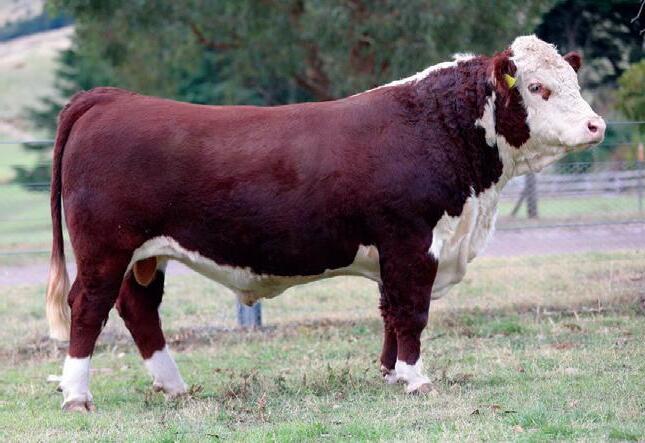

FORMER Australian Poll Hereford Association board member, John Neville Meikle passed away at the age of 94 on November 11, 2023, at the Woorayl Lodge Nursing home at Leongatha, Victoria.
Known as Neville to avoid confusion with his father John, Neville was a stalwart of the Poll Hereford breed in Victoria from the 1950’s until his retirement from breeding, on handing over the reins of their Tarwin Poll Hereford herd to his son David through the 1990’s.
Neville and his father John began their stud in 1950 and Neville was to run with it through the 1950’s to the 1990’s. In that time, he gained a reputation as a respected cattleman willing to support the breed and his fellow breeders.
Neville served for many years on the Victorian Poll Hereford Association committee as it was then. Often undertaking the role of breed inspector, show steward and organiser as required.
Neville regularly judged at country shows in Victoria and further away including the Hobart Royal. He was always prepared to give sound advice
to new breeders. This included making cattle available for Young Farmer judging competitions.
Regularly showing through Gippsland (South Gippsland in particular) from the 1950’s to the 2000’s, and competing in carcase competitions, the Tarwin cattle gained a respected reputation for commercial soundness under Neville’s stewardship. He would be a regular competitor at the Melbourne Royal through the 1960’s and 70’s, in both the show ring and the carcase competition and enjoyed the fellowship of the other cattle people of the No.3 pavilion, irrespective of breed.
Neville believed in the carcase competitions as a valuable means of promoting the breed in a more commercial environment and as a learning exercise for himself to see what was actually under the hide. He also served on interbreed bodies such the Victorian Stud Breeders Association and the Victorian Beef Week committee.
Neville always enjoyed the family he shared with his wife Doreen, five daughters and one son followed by
THE Hereford community paid tribute to a former Australian Poll Hereford Society director and vice chairman, John Proctor, upon his passing on January 11, 2024, at the age of 89.
Born on June 5, 1934, John was described as a family and community man dedicated to the land.
John served as a APHS director from 1986 to 1996 and as vice chairman from 1995 to 1996.
He joined the Victorian branch of the Society at the 1973 annual general meeting. The society was later named the Victorian Poll Hereford Association and he served as vice president in 1976 to 1978, followed by junior vice president in 1979 to 1981, senior vice president in 1981 to 1983, president in 1983 to 1986 and ex-officio until 1996. John was made an honorary life member of the association.

14 grandchildren and eight great grandchildren.
He served on the Australian Poll Hereford Association board in the early 1990’s, utilising his network of contacts within the breed, built up over the years. He always enjoyed the fellowship of his fellow breeders and was interested in the various breeding strategies and farming methods used in other districts.
OLIVER Holliss was born August 5,1938, to Bert and Clara Holliss as a much-loved son to complete their family and doted on little brother for Rita.
Oliver grew up on Old Farm, Pinkett, being actively involved in daily chores from an early age with his education at the Moggs Swamp school.
Oliver’s destiny was to be on the land and fortunately it was a life he relished, spending 84 of his 85 years at Old Farm. His memories of the area as he grew up were sharp and he told stories of attending sports days as a child and remembering the entertainment provided by some adults after events and a few beers at the end of the day.
Oliver was a competent horseman and covered many miles mustering and acquainting himself with the eastern fall country that was his home.
Back in the 1950’s, like now, any reason to socialise is a great reason to get out and local dances are where you’d find him. It was during one of

A meeting was held on November 18, 1983, at Vern and Elaine Young’s Rochester property to form a northern Poll Hereford group. John became a founding member of the group, involving himself in junior heifer shows, education days, judging schools, feature shows and stewarding at the events.
John established the Kooreh Poll Hereford stud in 1960 and exhibited at many shows including the senior and grand champion female at the 1973 Royal Melbourne Show.
A memorial service was held on February 9 at the St Arnaud Country Golf Club. John is survived by his wife Margaret, children and their partners, Jenny and Dale Watts, Brenda, Alison and Pat O’Reilly, Paul and Ingrid, and Scott and Ciara.
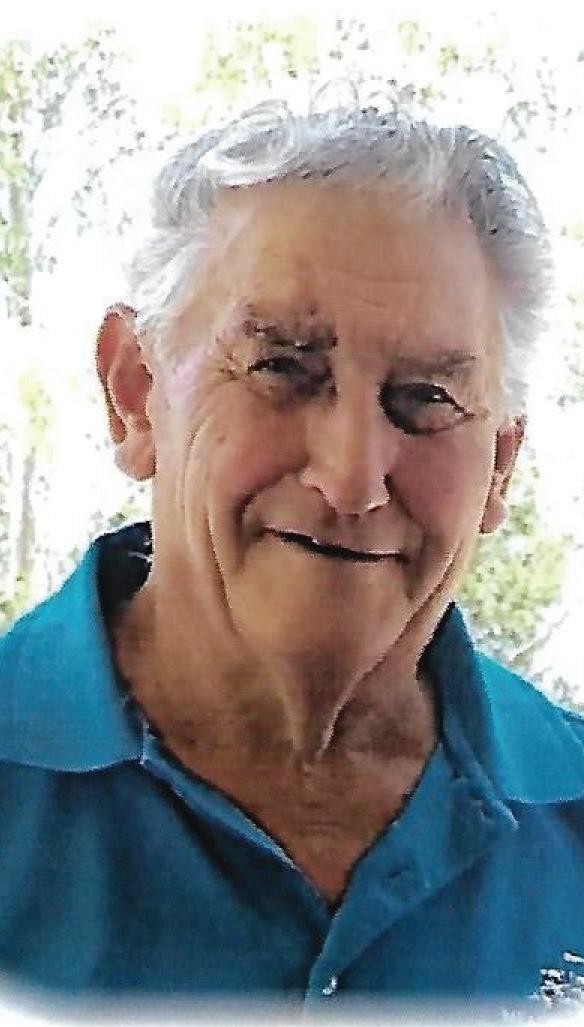
these occasions that he met the love of his life, Colleen Morley and they married on January 9, 1960, building their life together at Old Farm for 58 years until Colleen’s passing in 2018. Their greatest joy in married life was the birth of their two sons Tony and Craig.
Life in the country provides lot of things to do and challenges to overcome and Oliver with Colleen by his side met these head on and worked hard to achieve their life goals. Oliver enjoyed his hunting, fishing, camping, and participating with his sons in TugO-War.
He was an active member of the local rural fire service for many years and always took a keen interest in the activities of his sons and later grandchildren.
Apart from family, Oliver’s ongoing passion were Hereford cattle.
Together Oliver, Colleen and the boys continued the legacy started by Bert and Clara and grew the Old Farm

Oliver and Colleen’s love for Hereford cattle saw them travel widely, including overseas and resulted in many longlasting friendships which they valued greatly.
He died on December 4, 2023 and was buried on December 12, 2023 following a funeral service at the Holy Trinity Anglican Church, Glen Innes.


• Doodle Cooma Poll Herefords, Wagga Wagga, NSW
• Wirruna Poll Herefords, Holbrook, NSW
• Allendale Poll Herefords, Bordertown, SA
• D & G Gulliver, Gulliver Rural, Dimby Herefords, Tamworth, NSW
50
• A & R Smith, Glenellerslie Poll Herefords, Adelong, NSW
• JP Davie & Co, Guilford Poll Herefords, Ouse, TAS
• J & R Lynn, Eskdale Herefords, Cunderdin, WA
• Hunt Ag, Gimba Herefords, Moree, NSW
• Kay M Payne, Elite Poll Herefords, Gundy, NSW
• M & C Rutherford, Stanford Poll Herefords, Bathurst, NSW
• M & P Tollard, Byrralee Herefords, Fosterton, NSW
• Peter Whittakers, Cornalla Poll Herefords, Deniliquin, NSW
• Margaret Allen, SB Herefords, Moolap, VIC
• J & G O’Brien, Maringo Herefords, Merrijig, VIC
• RA Weston, Algona Herefords, Jindabyne, NSW
• RB Corkhill & Co, Normanhurst Herefords, Borrowa, NSW
25 YEARS MEMBERSHIP
• Duggan Farming Pty Ltd, Seaview Herefords, Southport, TAS
• Reid Lester, Clarendon View Herefords, Lake Clarendon, QLD
• R & L Bethune, Mitta Mitta, VIC
• Yavenvale Poll Herefords, Adelong, NSW


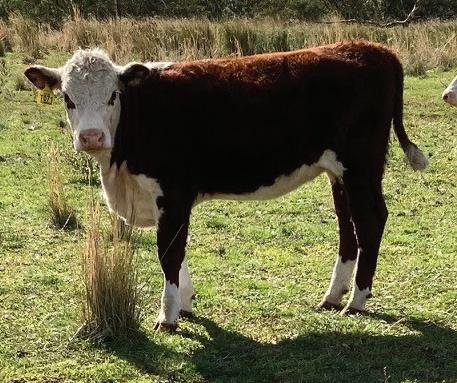
By Kim Woods
DEMAND for heavy grass-fed Hereford steers pushed prices to $1940, weaner steers to 462c/kg and quality breeding females with calves fetched to $2420 around the nation’s store markets during autumn.
In the purebred heavy grass-fed steers over 350kg liveweight prices settled at $1427-$1940 or 254-318c/kg while yearling Hereford steers sold for $1200-$1750 or 307372c/kg and purebred feeder steers made $1220-$1695 or 300-359c/kg.
Hereford weaner steers weighing over 350kg liveweight sold for $1012-$1560 or 298-432c/kg and the lighter pens at 280-350kg made $735-$1320 or 260-462c/kg, and the lightweights under 280kg finished at $400-$960 or 218408kg.
In the purebred females, weaner heifers under 350kg liveweight sold for $720-$1160 or 205-354c/kg, yearling heifers $1020-$1410 or 252-352c/kg.
Pregnancy-tested-in-calf heifers finished at $1440-$2620, PTIC cows $1350-$1810, PTIC cows and calves $1790-$2420, and unjoined cows and calves settled at
$2090-$2125 while PTIC heifers and calves were generally not offered.
At Bairnsdale, Webb & Richardson sold Hereford steers, 384kg, for $1400 or 364c/kg and the seconds, 315kg, for $1200 or 380c/kg. Kent Park sold 324kg steers for $1300 or 401c/kg and 268kg steers for $1240 or 462c/kg. Phil “Bluey” Commins, Nunniong Herefords, Ensay, sold 671kg heavy steers for $1710 or 254c/kg.
Whispering Valley Poll Herefords, Strath Creek, sold weaned steers, 305kg, and 10 to 11 months, for $1150 or 376c/kg. They were by Ravensdale Anzac Q105 and out of Karoonda and Melville Park cows.
Kobyboyn Partnership, Seymour, sold Mawarra and Glendan Park blood weaner steers, 10 to 11 months, 338kg, for $1280 or 378c/kg, and their heifer portion, 321kg, for $1000 or 311c/kg. Eccles Pastoral, Willatook, sold a run of 78 Newcomen blood weaner steers, 185kg, 5 to 6 months, for $960 or 408c/kg.
At Bairnsdale, Ensay breeders Phil and Kerry Geeham sold a draft of 83 steers, nine to 10 months, with the tops weighing 393kg and returning $1550 or 394c/kg, while those weighing 352kg made $1380 or 392c/kg and the 317kg steers sold for 416c/kg or $1320.
CONTINUED ON PAGE 88



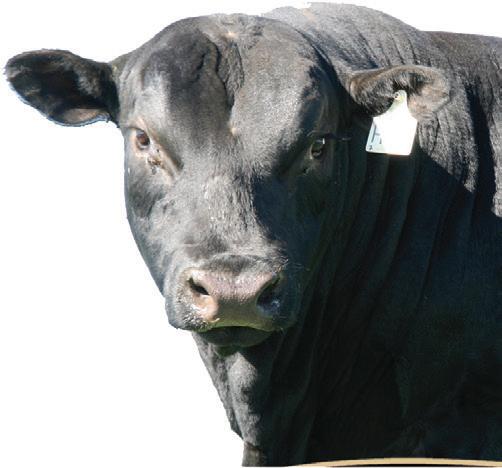



Bill and Annemarie Henderson, Gelantipy, also sold at Bairnsdale, a line of 90 mixed sex calves, nine to 10 months, including 18 steers, 427kg, for $1480 or 346c/kg, and heifers 342kg for $880 or 257c/kg. P A Smith, Omeo, sold 70 steers and 90 heifers, including the top steers at 390kg for $1280 or 328c/kg and 330kg steers at $1200 or 390c/ kg. His heifers weighed 326kg and made $670 or 205c/kg.
C and J Cooper, Wulgulmerang, sold 65 steers, nine to 11 months, including 378kg for $1300 or 343c/kg.
At Yea, Ross Armstrong, Evergreen, Island Bend, sold Yavenvale and Tarcombe blood steers, 384kg, for $1460 or 380c/kg, while G and M Aldridge sold Injemira and Wirruna blood steers, 292kg, for $1130 or 386c/kg. Lynn and Pam Vearing, Glen Goulburn Poll Herefords, Glenburn, sold 461kg steers, 13 to 14 months, for 321c/kg or $1480 and 399kg steers for $1270 or 318c/kg at Yea.
At Kyneton, Chandpra sold Glendan Park and Allendale blood steers, 371kg, for $1125 or 303c/kg. A draft of 64 feeder steers weighing 535kg and aged 20 to 22 months, returned $1610 or 300c/kg for Eirenclare Farms, Mortlake, after they were bought out of the 2023 Mountain Calf Sales. Tallara Holdings, Charam, sold Injemira blood steers, PCAS eligible, March/April 23 drop, 342kg, sold for $1110 or 323c/kg.
At Leongatha, George and Lorraine Simmons, Woodside, sold steers 10 to 12 months, 403kg, returning $1420 or 352c/kg, 388kg steers for $1350 or 347c/kg and 361kg steers for $1300 or 360c/kg. Don and Kay Belcher, Wonga Park, Woodside, sold a run of 41 steers, 10 to 12 months, with the tops weighing 361kg and making $1560 or 432c/ kg to a Nar Nar Goon steer finisher. Roger and Yvonne Connley, Omeo, sold 49 steers, 14 months, including a pen weighing 520kg returning $1750 or 336c/kg, 480kg steers at $1580 or 329c/kg and 455kg steers at $1400 or 307c/ kg. All were bought by a steer finisher from Wonthaggi. The Dowel family, Leongatha South, sold 60 steers, 10 to 12 months, including a pen weighing 375kg for $1300 or 346c/ kg to a Yarram buyer.
Also at Leongatha was K and J Shea selling Hereford steers, 620kg, for $1940 or 312c/kg.
At Mortlake store sale, Chocolyn Farm sold PCAS eligible steers, 22 to 24 months and 453kg for 318c/kg or $1440 while Moonmoote sold 539kg grass fed steers, Ennerdale and Morganvale blood, for 295c/kg or $1591, Gellview sold heavy grass-fed steers, 551kg, Ennerdale blood, and 24 to 26 months, for 280c/kg or $1543. T Rea sold weaner steers, seven to eight months, 241kg, for 352c/kg or $848.
David Sleigh, Sleigh Farming, Ruffy, sold PTIC cows, Allendale and Bayunga blood, five to eight years and 756kg, and Allendale blood calves for $2350.
At Wodonga, Michael and Anna Coughlan, Tarabah Livestock Company, Morundah, sold a feature line of weaners with the tops weighing 311kg and returning $1190 or 382c/kg. Mt Skene Pastoral Co, Merrijig, sold Allendale blood cows with six to seven-month-old calves for $2200.
Bill and Mary Goldsworthy, Eurobin, sold PTIC heifers, 717kg, 32 to 24 months, for $2530 while R and S Morgan, Ballyrogan, sold a run of 82 Morganvale, Days and Allendale blood, EU accredited weaned steers, 435kg and 11 to 12 months, for $1350 or 309c/kg.
Mahkwallok East Pastoral, Stockyard Hill, sold a draft of 76 weaned steers, 342kg, 10 to 11 months, for $1230 or 359c/kg. Vaccinated with MH + IBR, the EU accredited steers were by Days, Allendale and Injemira sires ranking in the top 20 per cent for 600-day weight.
Western Districts Pastoral Company, Lucindale, sold a draft of 85 weaned steers, 379kg, nine to 11 months, Yarram Park blood, for $1470 or 387c/kg. They were Greenham Never Ever accredited, antibiotic free, grazed on irrigated pastures and out of females purchased at the Hamilton feature Hereford weaner sales.
Heading over the border to NSW, the first on-property Yulgilbar genetics commercial female sale in February resulted in Yarram Park Herefords/Santa Gertrudis heifers, averaging 473kg, EU accredited and PTIC, selling to a top of $2440 to David and Paul Bennett, Talofa, and a Westpac Helicopter Rescue Service charity heifer, Hereford/Santa Gertrudis cross weighing 670kg and PTIC, made $8200. Joined Hereford/Santa heifers with calves topped at $2500 and PTIC EU accredited Hereford heifers sold to $2620.
The champion whiteface weaner heifers at the Donovan Livestock and Property weaner sale at Grafton were from Nattai Investments, Waterview Heights, weighing 287kg and returning $815 or 284c/kg. The champion pen of whiteface steers weighted 217kg and returned $887 or 408c/kg for the Moorhead family’s Baryulgil Pastoral. Bahreenah Poll Herefords, Tingha, sold steers, 301kg, and eight to 10 months, for $1240 or 411c/kg while B and M Reid, Bendemeer, sold feeder steers, 394kg, 16 to 18 months, for $1410 or 357c/kg. J and Y Benton, Glen Innes, sold a draft of 68 Ironbark blood, EU accredited, feeder steers, 15 to 16 months and 339kg, for $1220 or 359c/kg.
Wiltara Farms, Cassilis, sold a draft of 45 PTIC cows, Wirruna blood, 2.5 to 3.5 years and 500kg, for $1450. Martin Austin, Coolah, sold a draft of 62 steer weaners, Yalgoo and Yavenvale blood, 303kg, and 10 to 11 months, for $1115 or 367c/kg and 54 weaned heifers, 282kg, 10 to 11 months, for $735 or 260c/kg. Martin also sold station mated heifers, 492kg, 21 to 22 months, for $1220 or 247c/kg.
Commercial Hereford breeders for over 60 years, the Rutherford family, Stanford Ag, Bathurst, sold a draft of 74 yearling EU accredited, Stanford blood heifers, unjoined, 361kg, and 17 to 18 months, for $1210 or 335c/kg. Mrs J Crosbie, Neville, sold PTIC cows, six to nine years and 616kg, for $1810 and station mated cows, five to six years, with calves for $1790.
Wooling Pastoral, Crookwell, sold feeder steers, 16 to 17 months and 423kg, for $1430 or 337c/kg and their unjoined sisters, 413kg, for $1220 or 294c/kg. C and S Allen, Hoskinstown, sold station mated Hereford cows, 551kg, 24 to 35 months, with calves,

for $2420. R and J Legge, Cudal, sold non station mated cows, Allendale blood, three to eight years and 665kg, and their calves, for $2090.
At the Forbes store sale, N Clark sold PTIC heifers, 415kg, and 16 to 18 months, for $1560 while Bellarwi Pastoral sold steers, 394kg, Kidman blood, and 14 to 16 months, for $1360 or 345c/kg.
The Sturt family, Batlow, sold unjoined heifers, 327kg, 10 to 11 months, and Yavenvale blood for $1160 or 354c/kg. Their steer portion, 374kg, made $1225 or 326c/kg.
Gontawang, Holbrook, sold a draft of 60 Wirruna blood yearling heifers, 17 to 18 months, 383kg, for $1220 or 317c/ kg. Koorong Pastoral, Holbrook, sold Injemira blood PTIC cows, 670kg, three to seven years, for $1560.
In South Australia, Swan Lake, Heywood, sold 354kg PCAS eligible Taronga blood stees at $1080 or 305c/ kg to Thomas DeGaris and Clarkson, Penola, and a lighter draft at 322kg to Elders Mount Gambier at $1035 or 3121c/kg at Mount Gambier store sale.
Pannell Farming Enterprises, Malpas, sold non station mated cows, Verna Park and Wongawilli blood, four years and 552kg, with Black Simmental calves, for $2125.
North to Queensland where the O’Leary family, Remolea Poll Herefords, Clifton, sold a draft of 36 future breeders, with the tops weighing 399kg, aged 14 to 18 months, Remolea blood, and making $1410 or 352c/kg. E Bailey & Co, Guluguba, sold Remolea and Merawah blood weaned steers, 287kg, eight to 11 months, for $1050 or 365c/kg.
A draft of 79 Merawah blood yearling steers were sold by E Bailey and Co, Gulugbua, weighing 357kg and 14 to 18 months, for $1330 or 372c/kg.
They also sold a run of 57 unjoined yearling heifers, 347kg and 14 to 18 months, for $1060 or 304c/kg.
C A Hauff & Sons, The Springs, Blackall, sold Hereford feeder steers weighing 476kg and returning 356c/kg or $1695 at the Blackall store sale.
Across to Western Australia where J & J Gibbs sold a draft of 70 steers, 10 to 11 months, and weaned, with the tops weighing 384kg and returning 252c/ kg at the Elders Boyanup weaner cattle sale in February.
Mooylyall Farms sold grain assisted Hereford steers, 533kg, for $1427 or 268c/kg at the Mt Barker prime sale.
Down to Tasmania where Nova Poll Herefords, West Ridgley, sold yearling steers, 412kg and 15-17 months, for $1470 or 356c/kg. Duggan Farming, Powranna, sold Valma, Kidman and Wirruna blood steers, 306kg, eight to 14 months, for $980 or 319c/kg and heifers, 366kg, eight to 14 months, for $930 or 253c/kg.
Kinglands, Redpa, sold a draft of 28 weaned steers, 311kg, seven to nine months, and for $930 or 298c/kg. The steers were sired by Tarcombe Cadbury R056, senior champion bull at the 2022 Wodonga National Sale.
At the Powranna Feature Hereford weaner sale in April, Scott Reardon, Bothwell, topped the 2500 head yarding with heavy steers weighing 409kg and returning $1320 or 322c/ kg, 354kg steers making $1080 or 305c/kg, and lighter 306kg steers selling for $1000 or 326c/kg. His heifers weighing 304kg made $720 or 237c/kg. The top pen of heifers was judged as the best presented pen. Isabelle Hurburth, Ouse, sold 310kg heifers for $800 or 258c/kg. In the lighter steers Andrew McKenzie, Launceston, sold 246kg steers for $770 or 313c/kg.













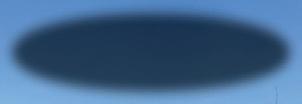












Meet our team for 2024. For the benefit of the membership, included are details for the Herefords Australia Limited Board of Directors

Greening
CHAIRMAN
Mobile: 0411 043 039
Email: marc@injemira.com.au

DIRECTOR, YOUTH LIAISON REP and FINANCE, AUDIT AND RISK COMMITTEE CHAIRMAN
Mobile: 0429 476 221
Email: sambroinowski@bigpond.com

DIRECTOR and MEMBER
LIAISON REPRESENTATIVE
Mobile: 0458 227 277
Email: annie.pumpa@genuspic.com
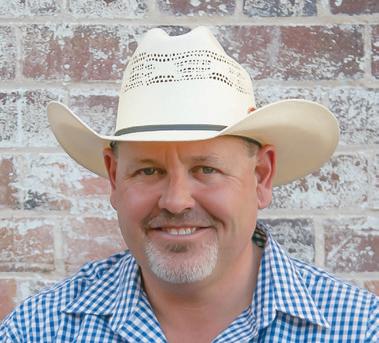
DEPUTY CHAIRMAN
Mobile: 0427 299 012
Email: ianthomasdurkin@bigpond.com

Tom Nixon
DIRECTOR
Mobile: 0427 276 182
Email: tom@devoncourt.com.au

DIRECTOR
Mobile: 0421 044 528
Email: benrumbel@icloud.com

COMPANY SECRETARY
Mobile: 0424 152 950
Email: mbaker@herefordsaustralia.com.au
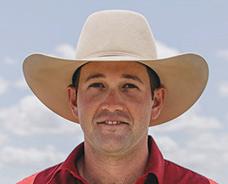
DIRECTOR and RESEARCH AND DEVELOPMENT
COMMITTEE CHAIRMAN
Mobile: 0417 576 667
Email: sam@jarrahcattle.com.au

DIRECTOR
Mobile: 0428 270 381
Email: sparkesy2@gmail.com
Central Tablelands Herefords Association
Paul Hancock, Secretary
“Whim Park’’
66 Kings Plain Road, Blayney NSW 2799
T: 02 6368 2140 - M: 0418 639 597
E: whimpark@bigpond.com.au
Hunter Valley Herefords Association
Jessica Grosser, Secretary 893 Hinton Rd, Nelsons Plains NSW 2324
M: 0456 800 533
E: mondeo.p.h@bigpond.com.au
Herefords Australia
Northern NSW Association
Amy Rawson, Secretary
3/25-27 Chisholm Street, Inverell NSW 2360
M: 0437 385 681
E: amy.louise.rawson91@gmail.com
Herefords Australia Northern NSW Youth
Lucy Crowley, Secretary
M: 0429 034 578
E: herefordsnorthernnswyouth@gmail.com
Sydney Regional Herefords Breeders Group
Ellen Hussein, Secretary
2 Eskdale Close, Narellan Vale NSW 2567
M: 0411 089 578
E: ellenhussein@gmail.com
Western Regional Herefords Association
Brooke Rayner, Secretary “Grathlyn’’, Hill End Road, Via Mudgee NSW 2850
T: 02 6373 8677
E: grathlyn@gmail.com
Southern NSW Hereford Breeders Group
Brittany Sykes, Secretary PO Box 435, Cootamundra NSW 2590
M: 0408 734 696
E: brittanysykes@outlook.com.au
Southern NSW Hereford Youth Group
Helen De Costa, President
28 Taber Street, Uranquinty NSW 2652
T: 0448 353 764
E: hdecosta@bigpond.com
Herefords Queensland Association Inc
Julie Nixon, Secretary
Colville Park
1091 Dulacca South Road, Dulacca QLD 4425
M: 0414 253 936
E: weetalabah@gmail.com
Herefords Queensland Youth Association
Mitchell Portbury, Secretary
M: 0437 087 449
E: Mitchell.portbury@gmail.com
Victorian Herefords Youth Group
Elle Woodgate, Secretary
1 Armstrong Street, Buchan Vic 3885
M: 0428 192 229
E: victorianherefordyouthgroup@outlook.com
North East Victorian Herefords Group
Ferruccio Tonini, Secretary
RMB 1045, Glenrowan Vic 3675
T: 03 5766 2417
E: glenpoll@internode.on.net
Herefords Gippsland
Lauren Hill, Secretary
M: 0427 750 250
E: lauren@karoondapark.com
Corrangamite Hereford Breeders Group Inc
Margaret Allen, Secretary PO Box 105, Mortlake Vic 3272
Northern Herefords Group Inc
Debbie Young, Secretary PO Box 109, Rochester, VIC 3561 M: 0417 370 385
E: strathvalley@bigpond.com
Herefords SA
Kaye Butler, Secretary PO Box 1369, Williamstown SA 5351
M: 0477 889 748
E: herefordssa@gmail.com
Western Australia Herefords Association
Sandra Woods, Secretary 1791 Westdale Rd, Beverley WA 6304
T: 08 9647 2029
M: 0439 964 720
E: terraneil@wn.com.au
Tasmanian Performance Herefords
Judy Fry, Secretary
206 Plummers Rd
South Forest TAS 7330
T: 03 6458 3364
M: 0418 319 689
E: jamena1@bigpond.com
Herefords Australia 16 Uralla Road
Locked Bag 7, Armidale NSW 2350
T: +61 2 6772 1399 - Fax: +61 2 6772 1615
Office hours: 8am to 4pm
E: info@herefordsaustralia.com.au








